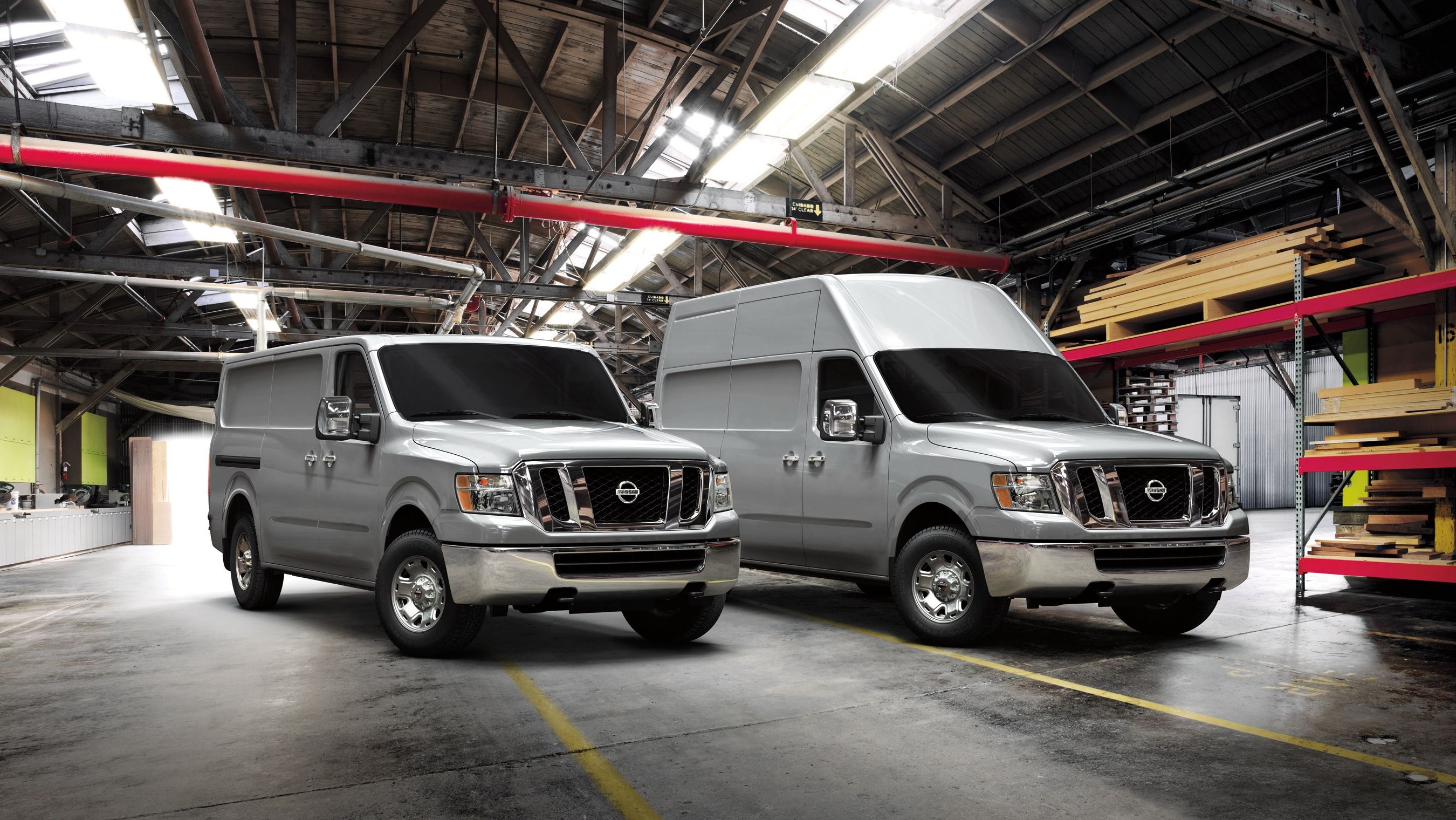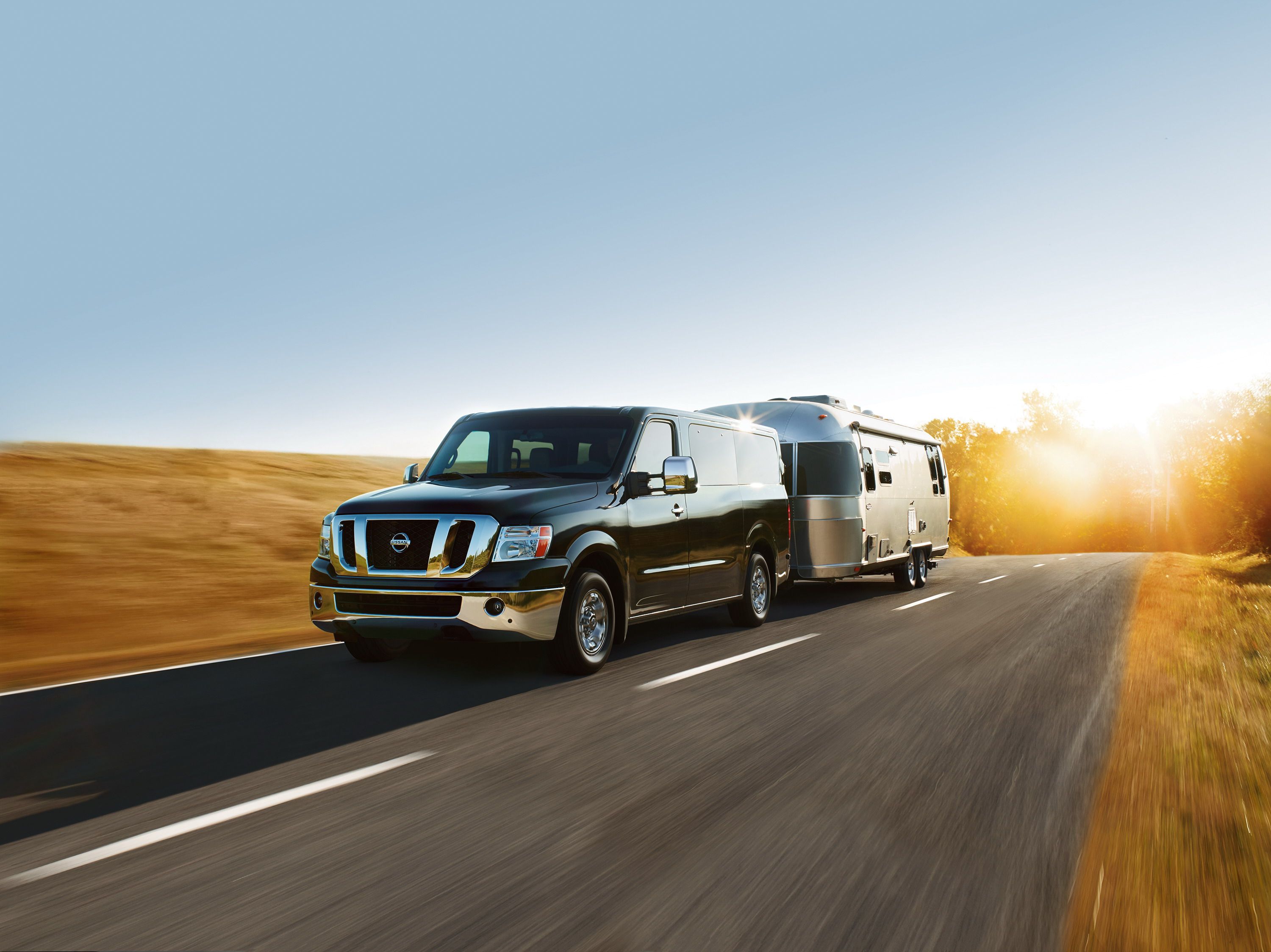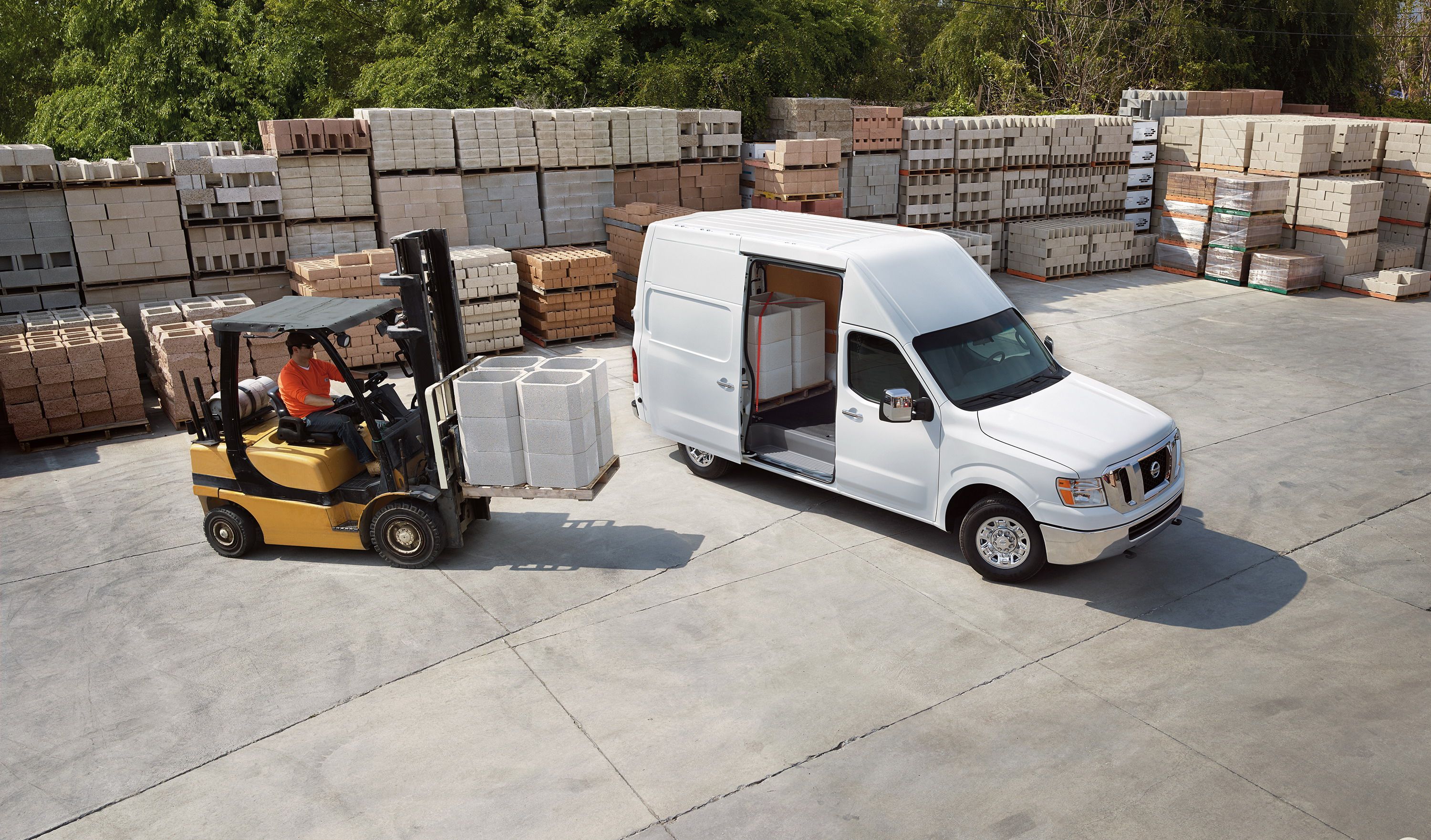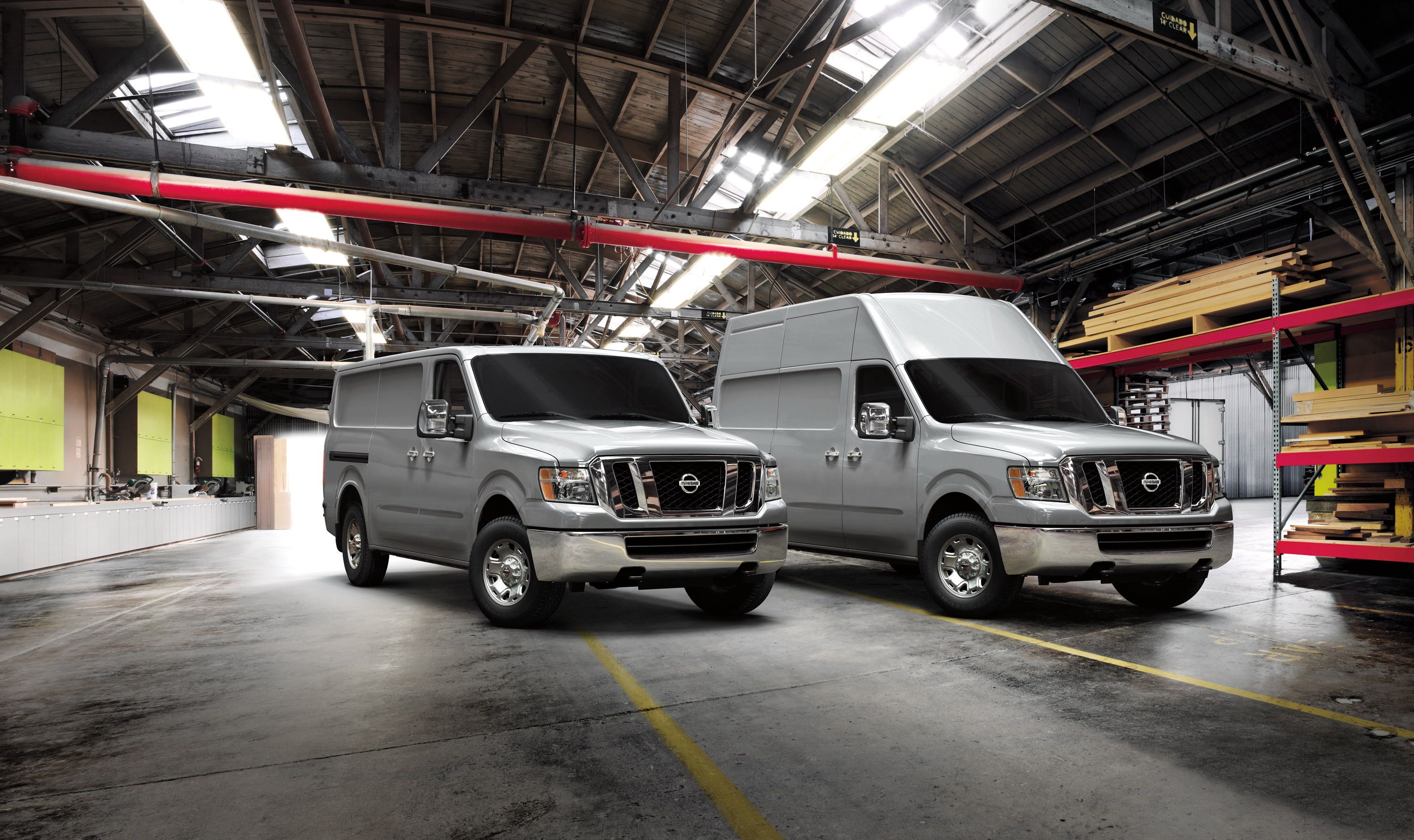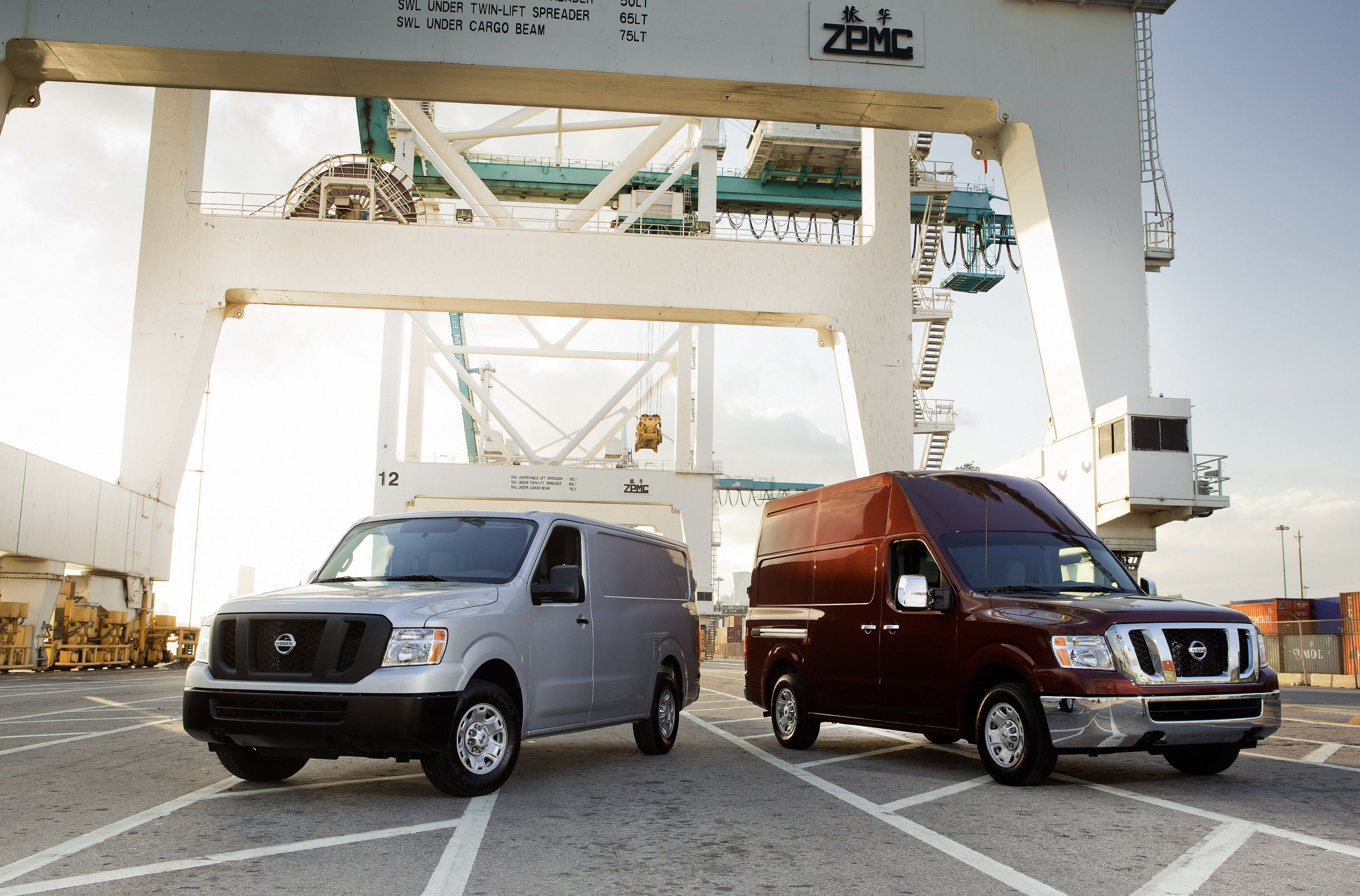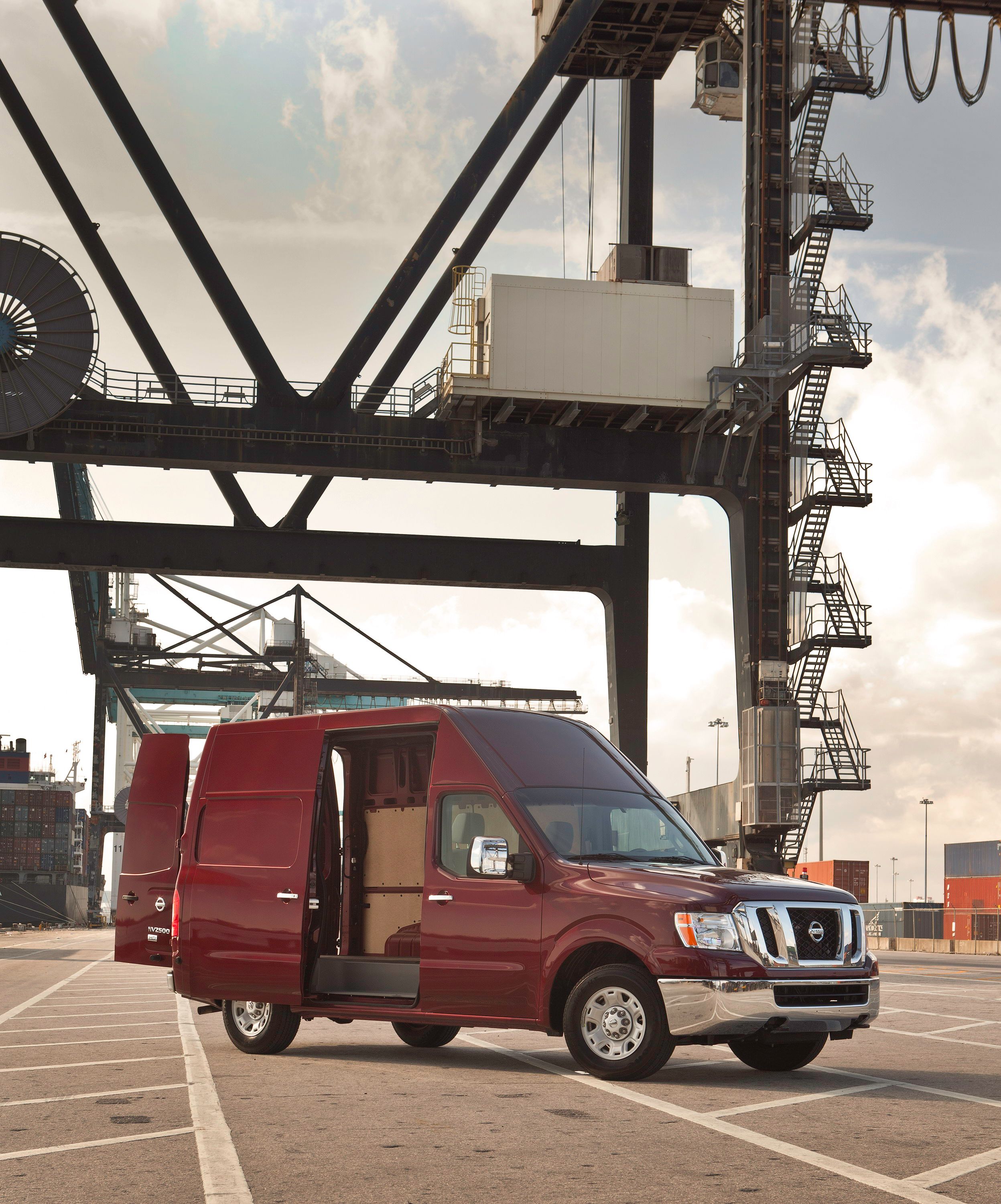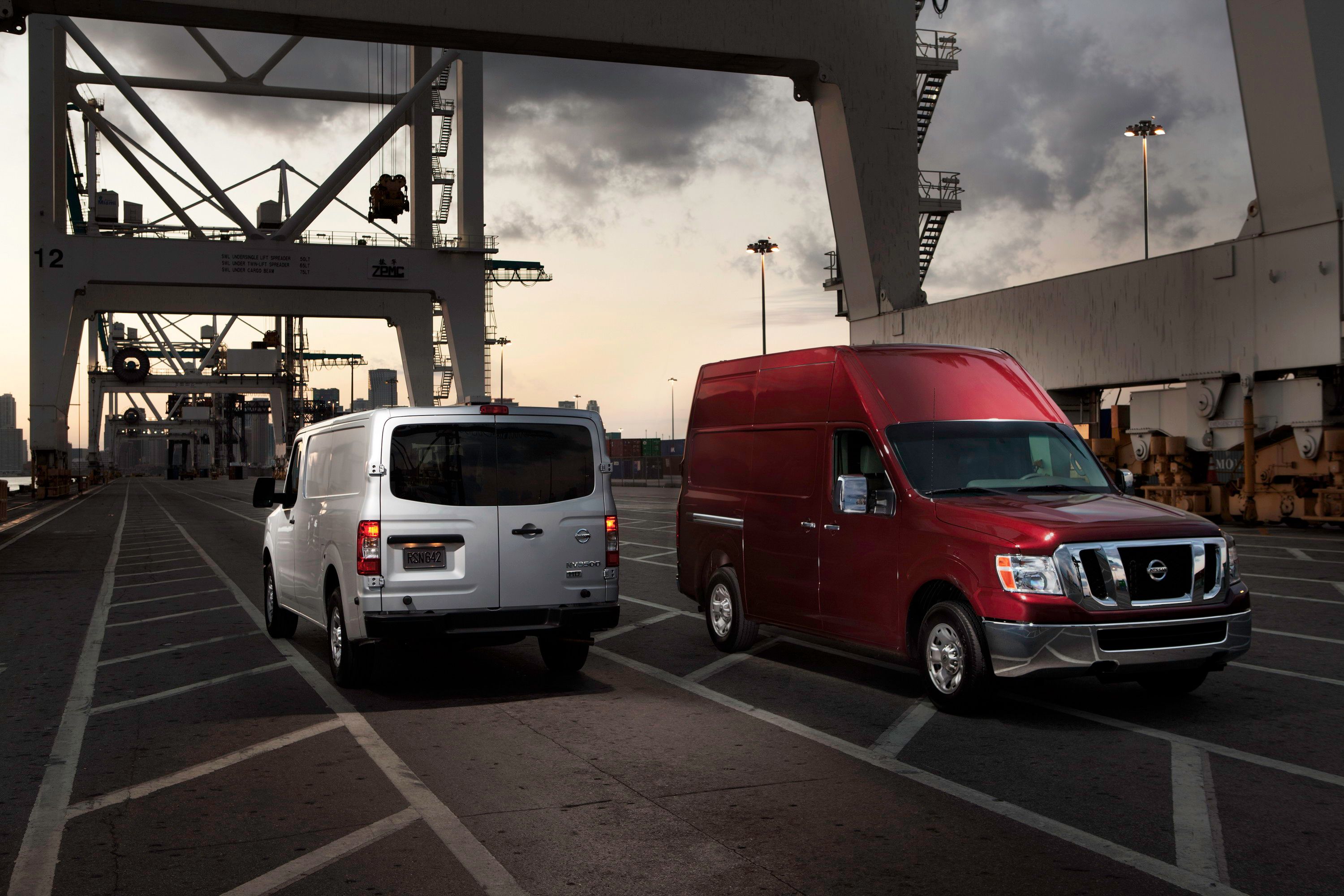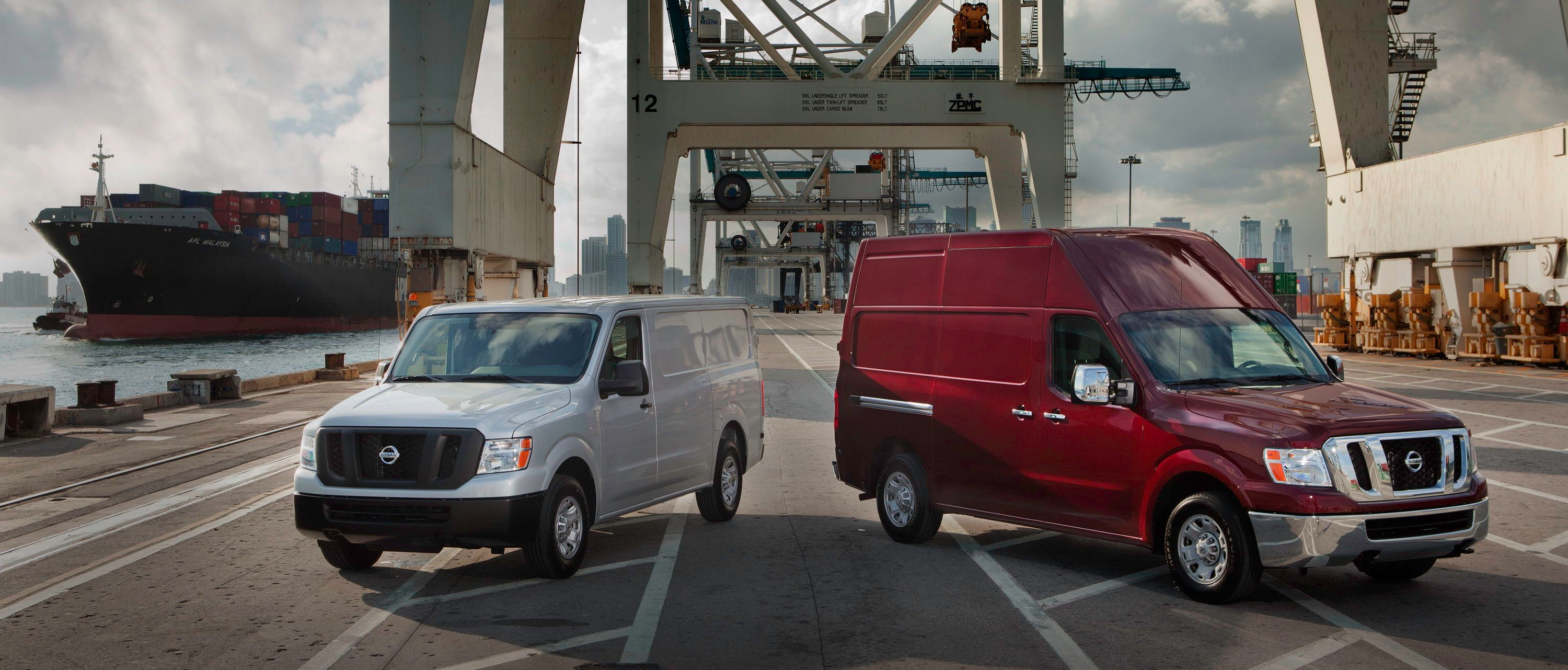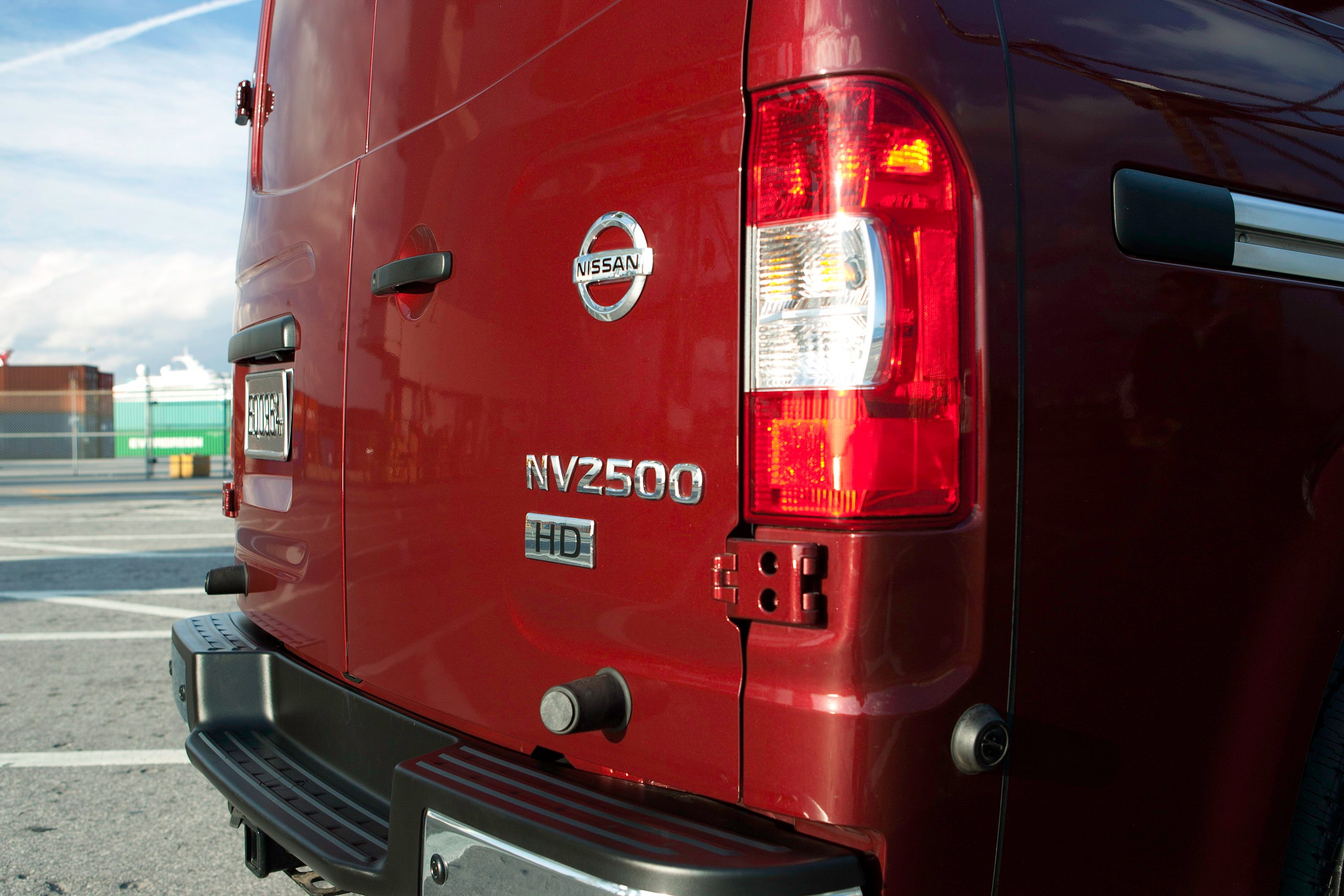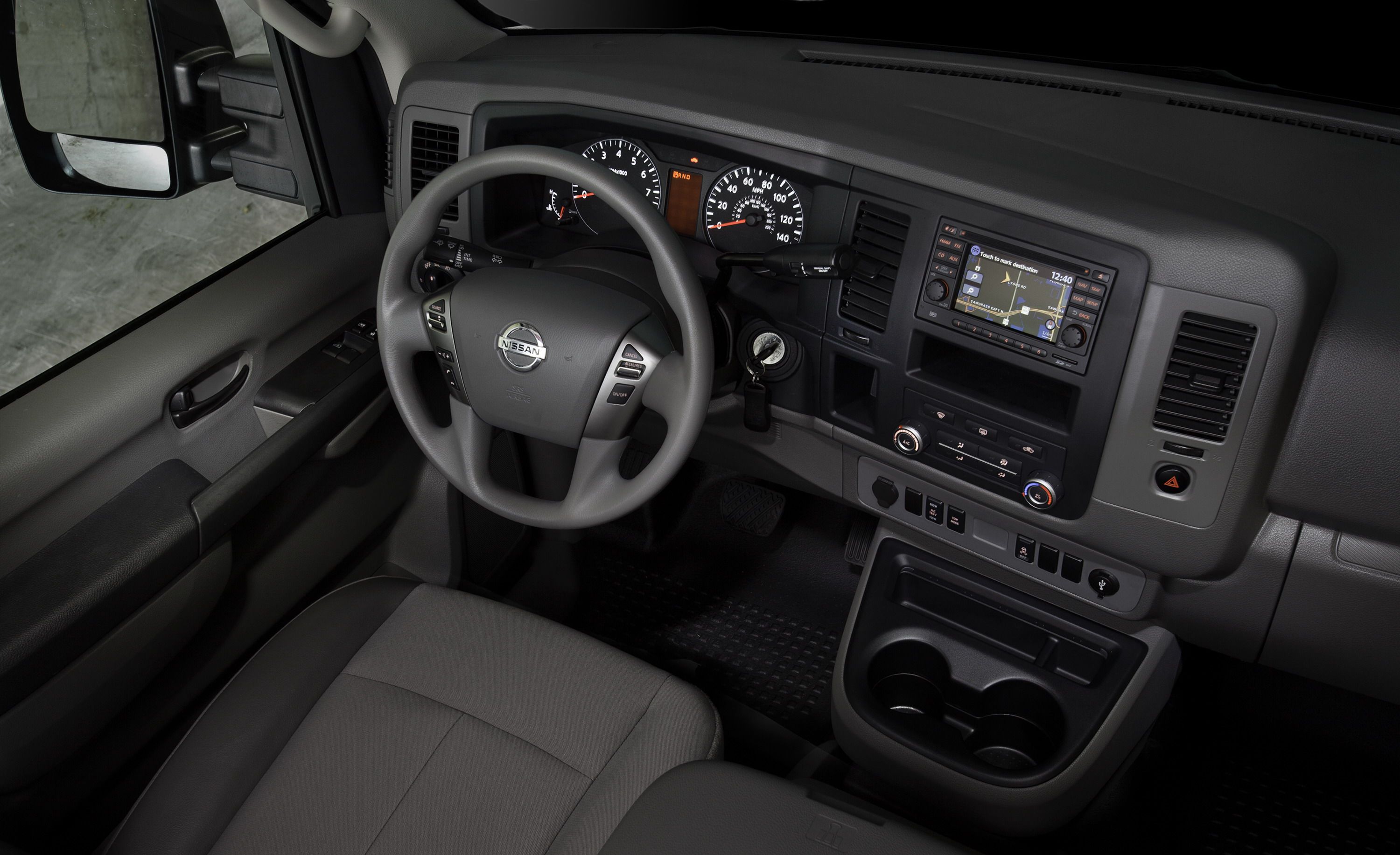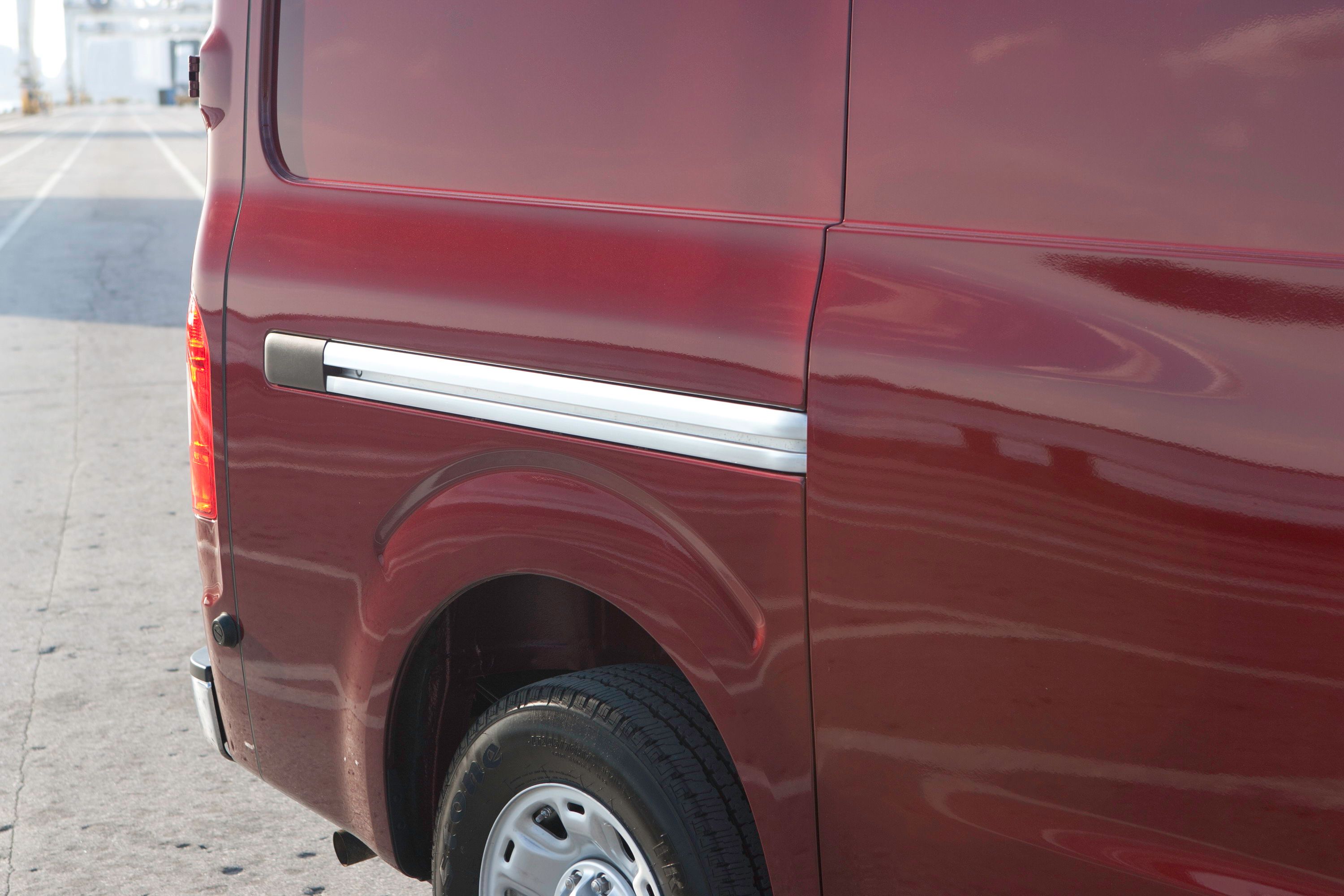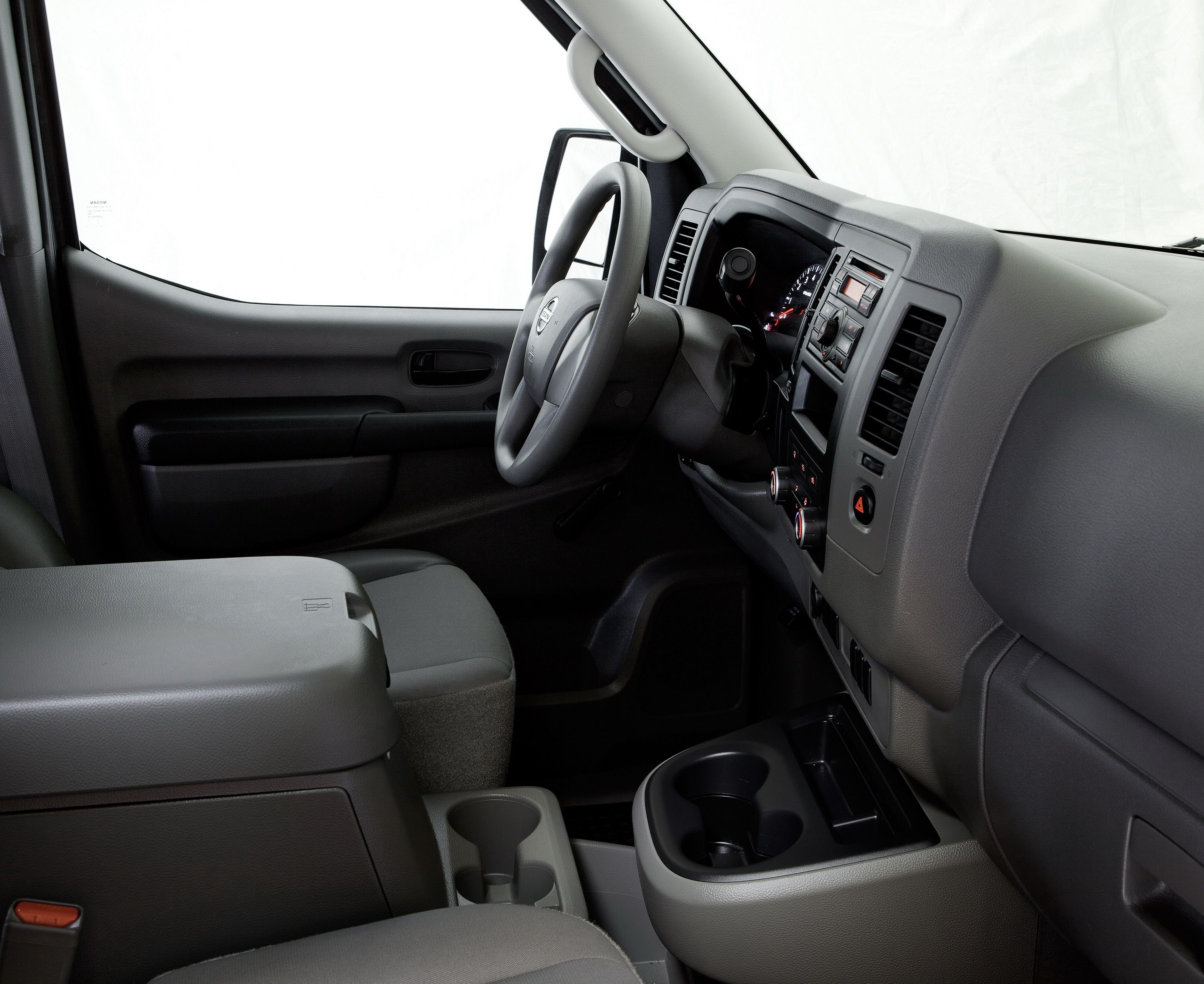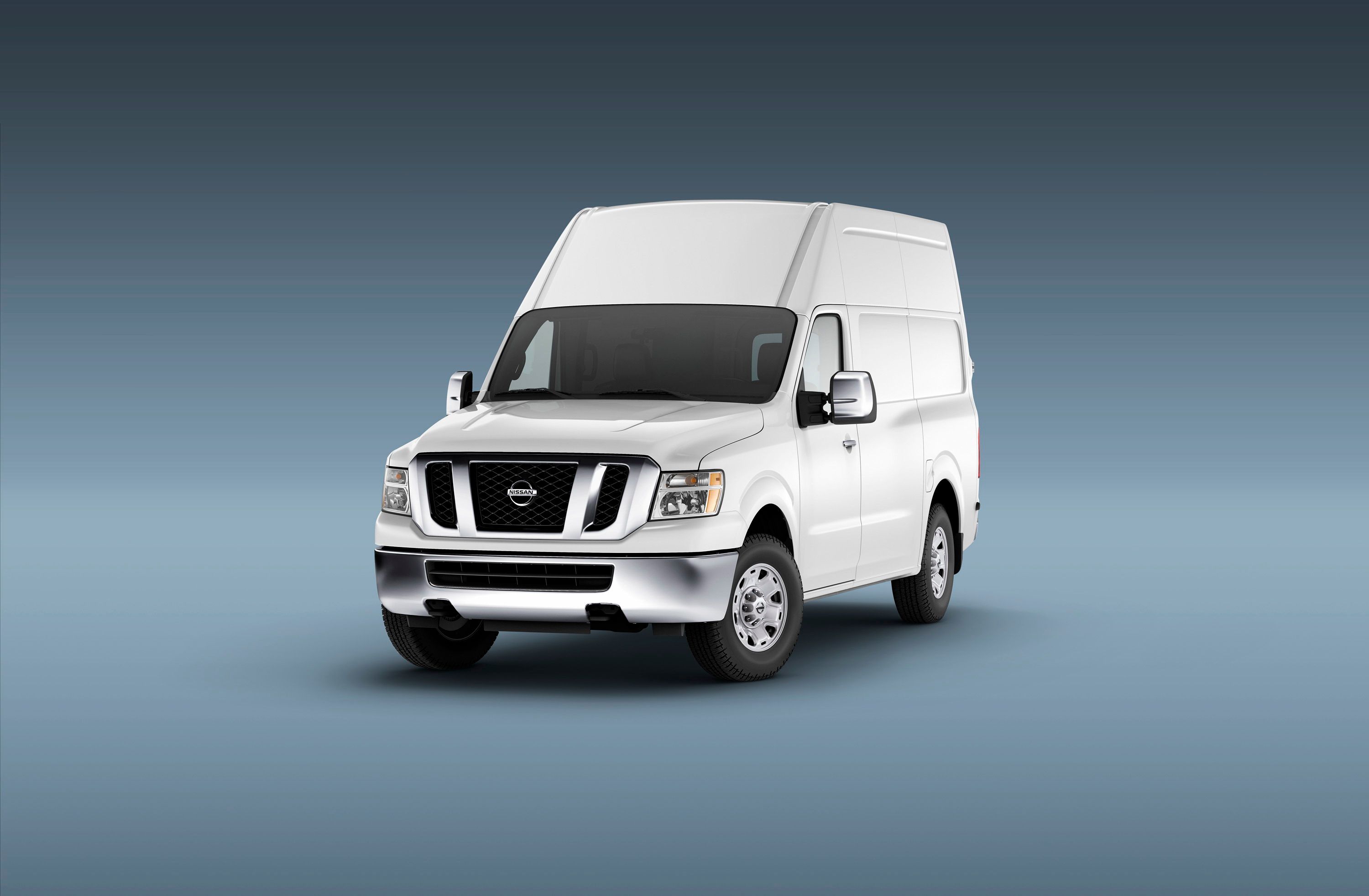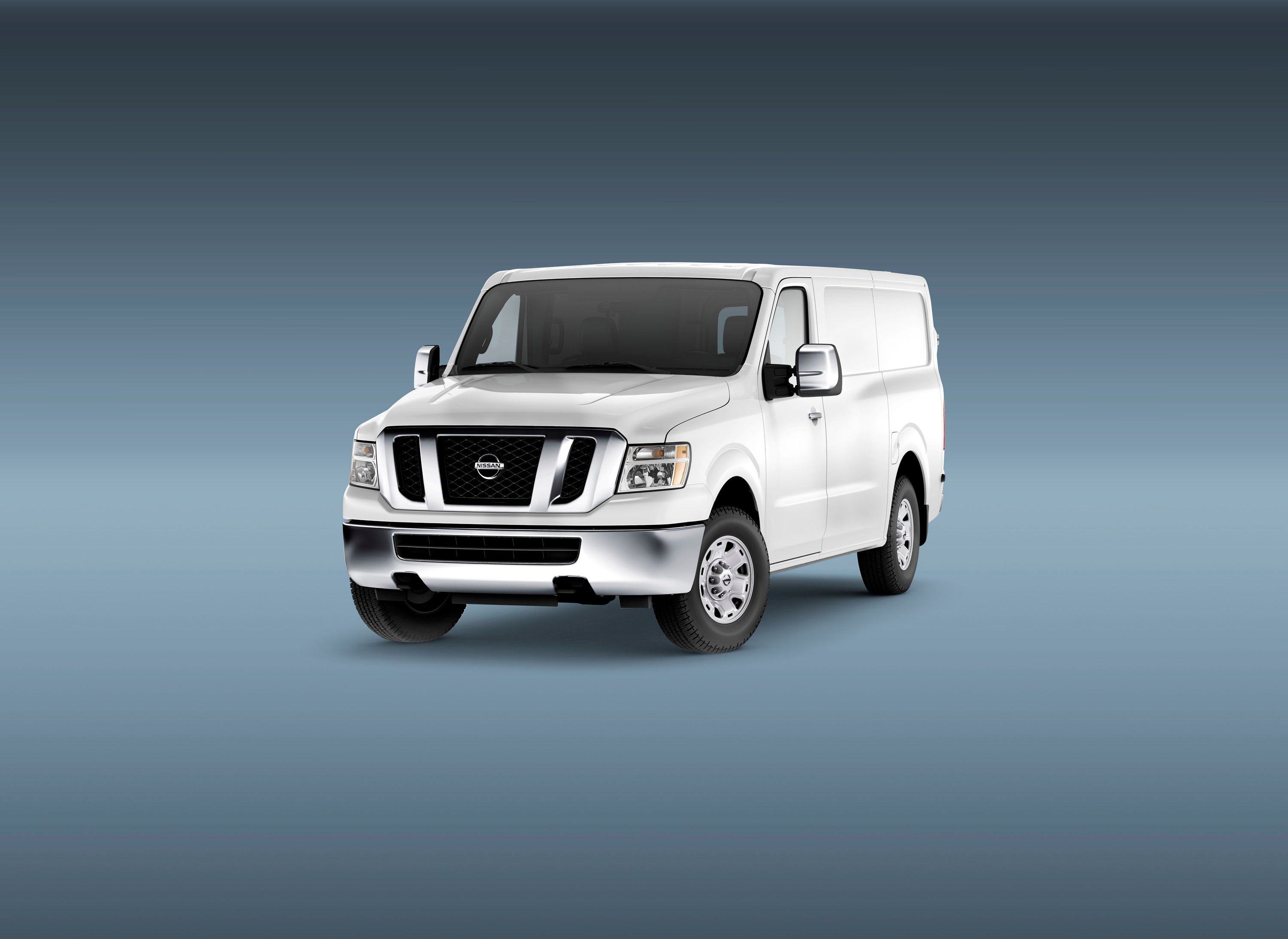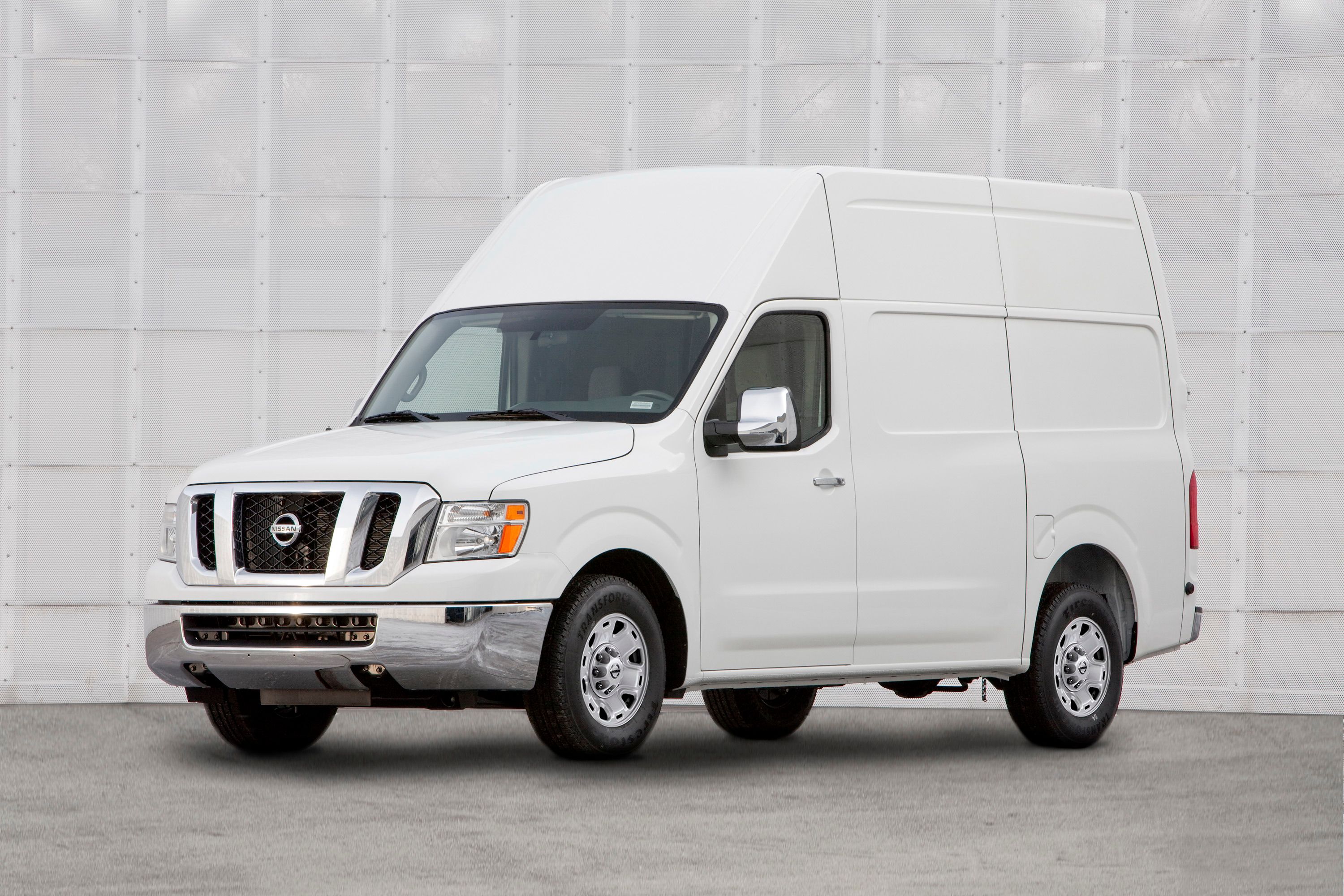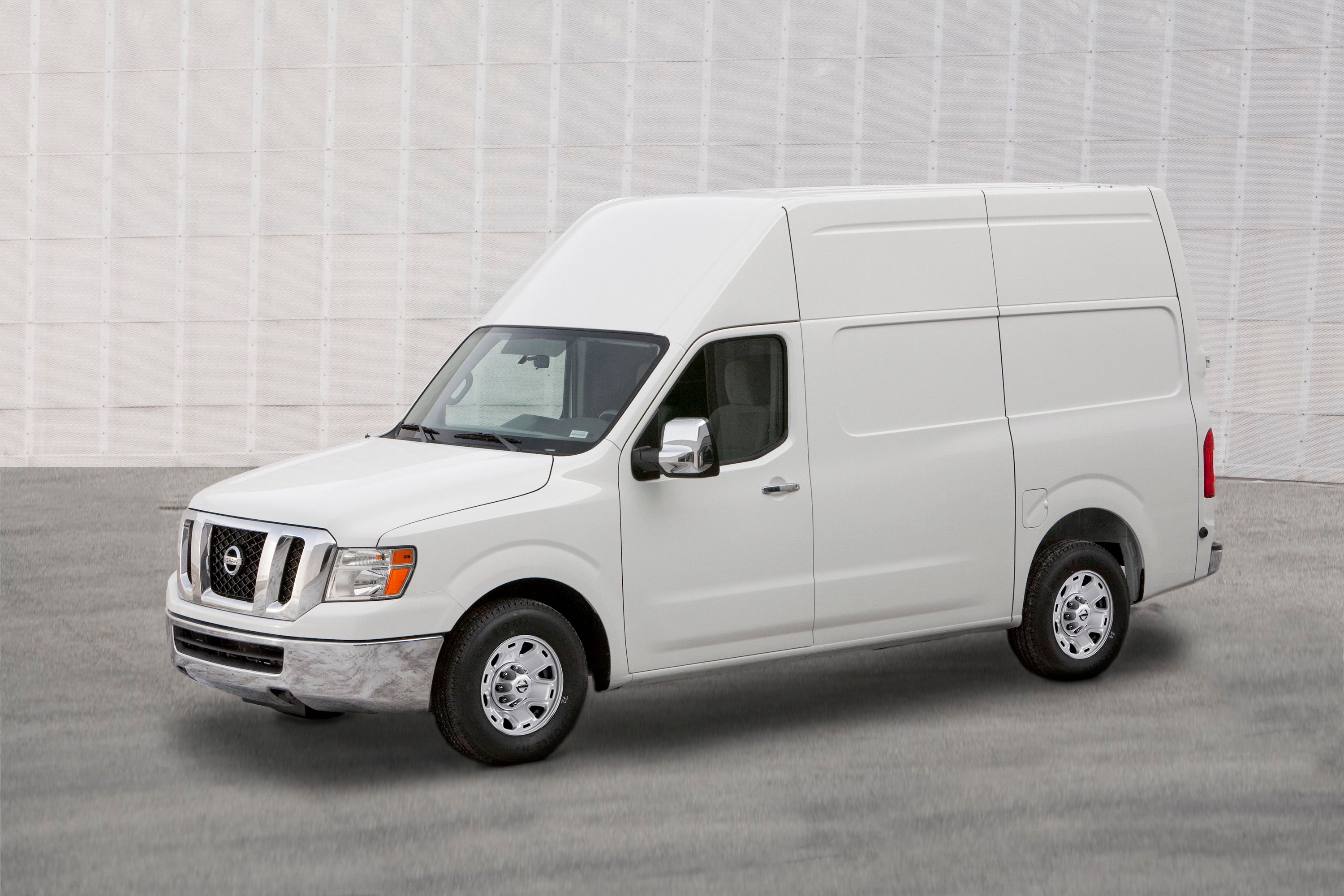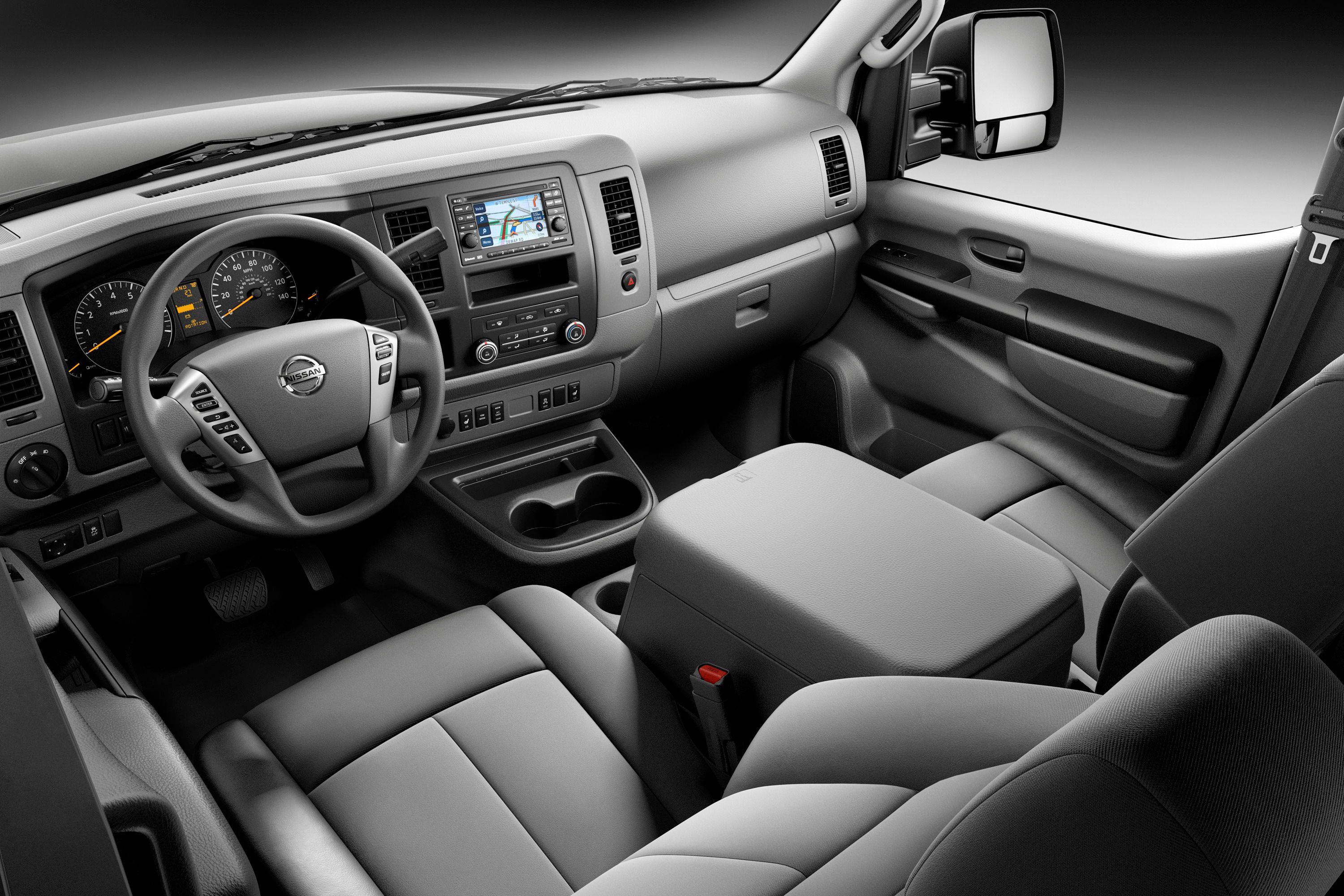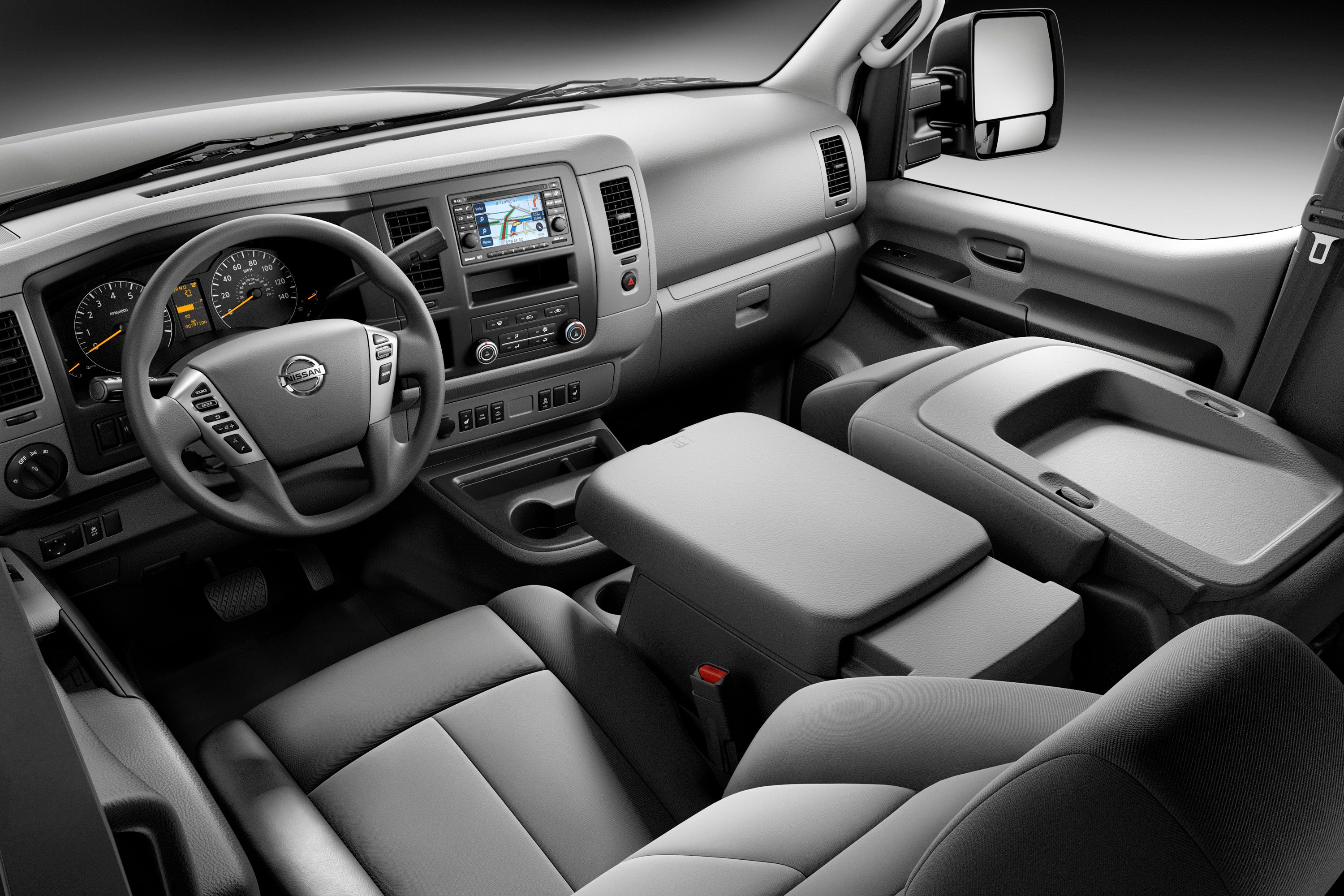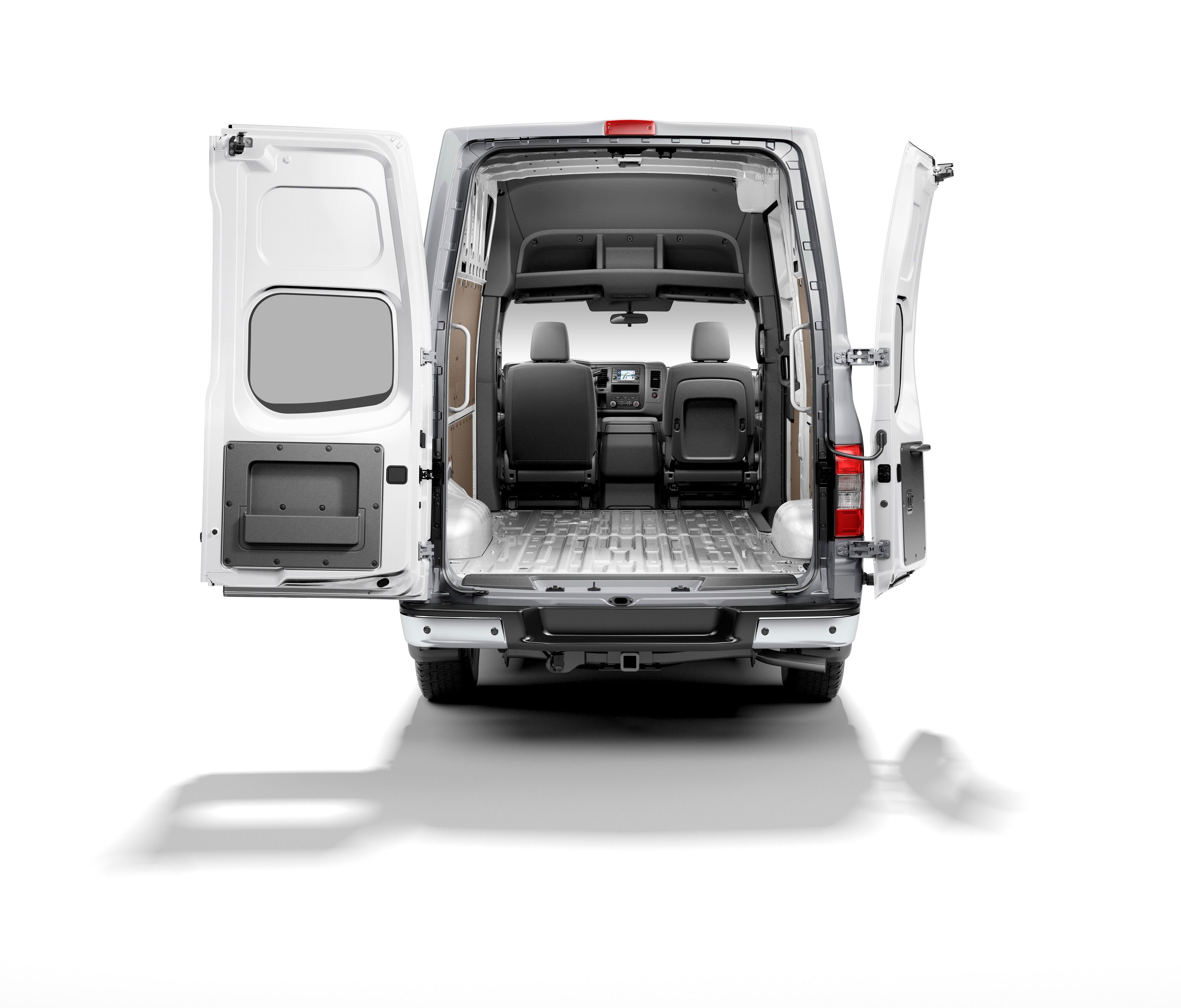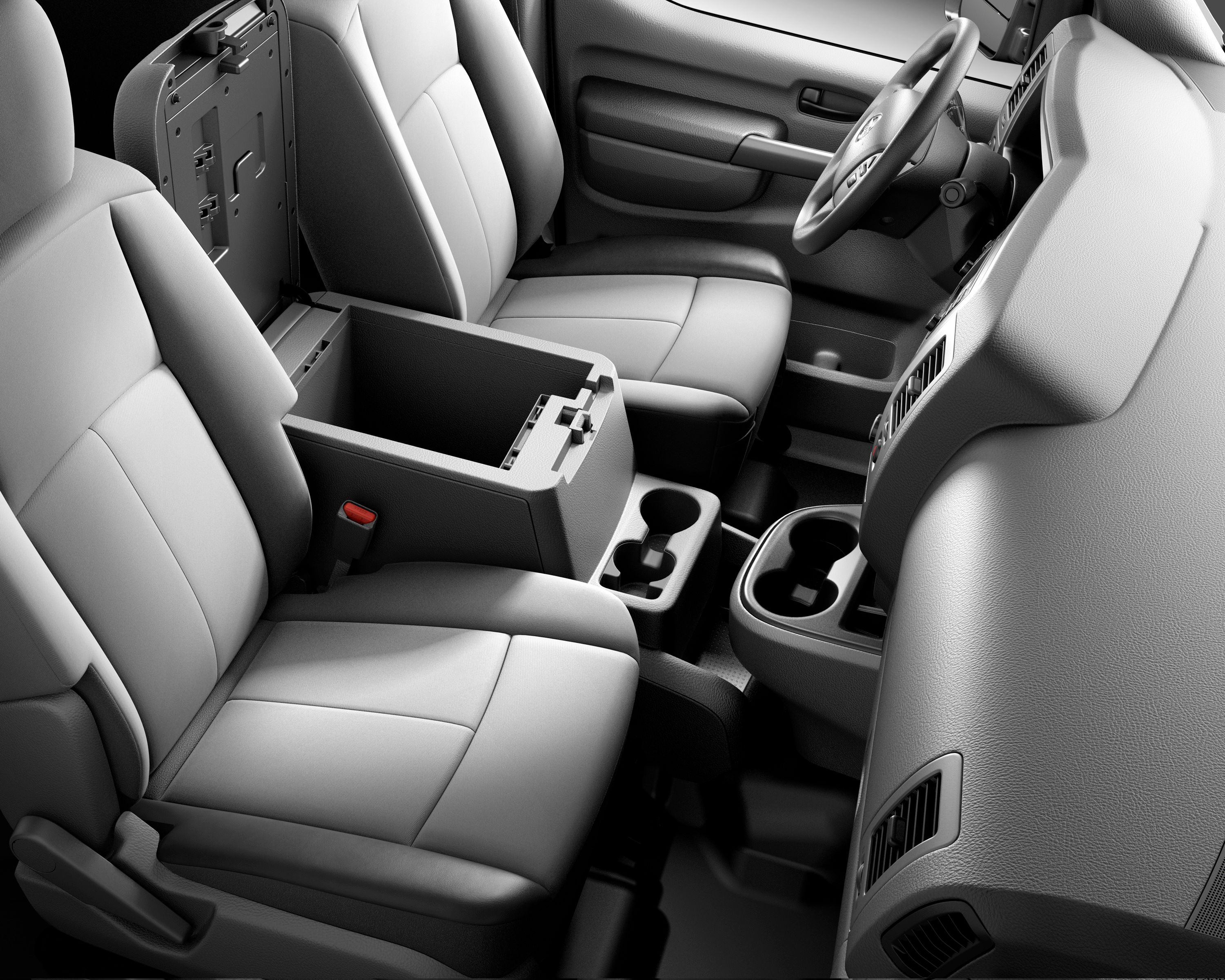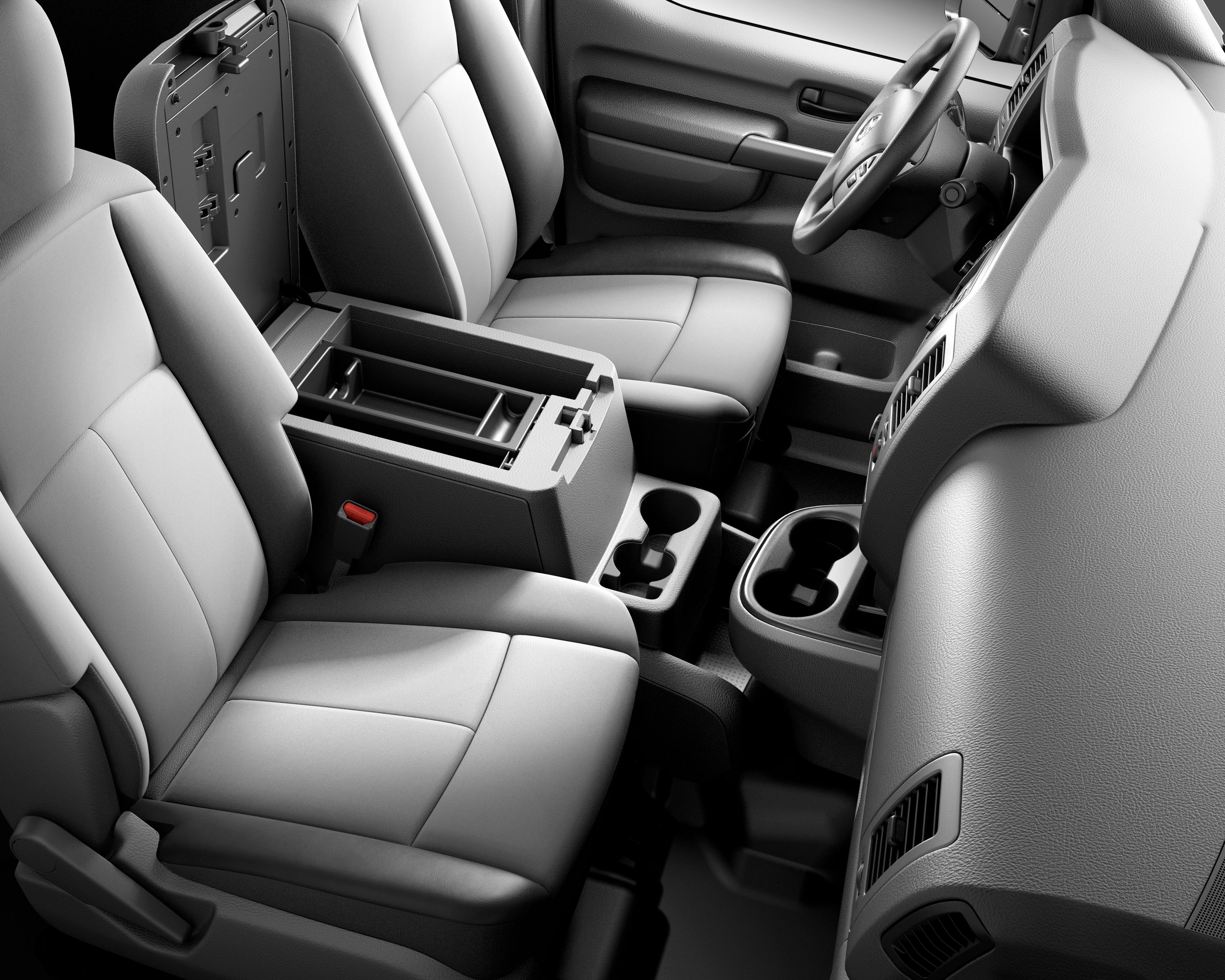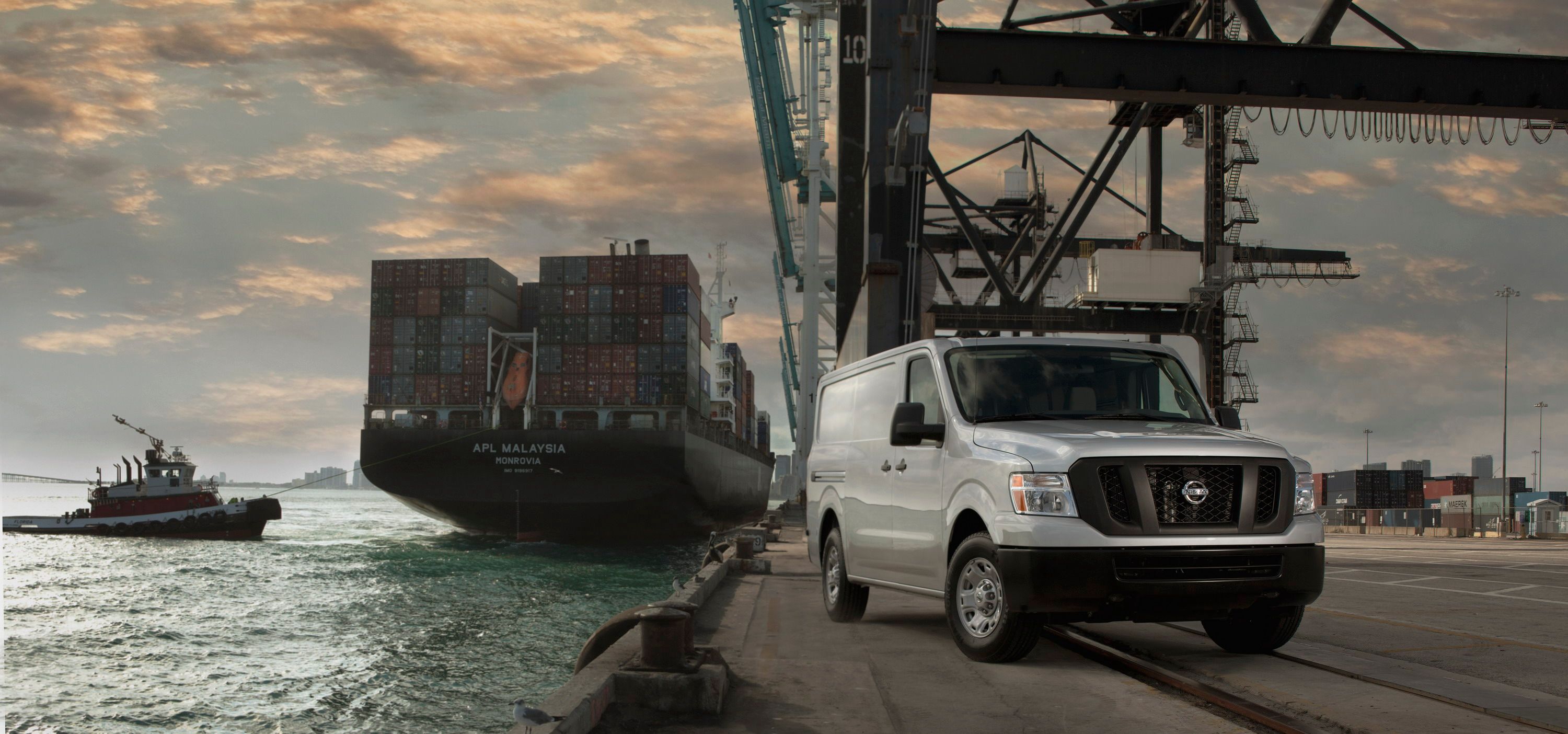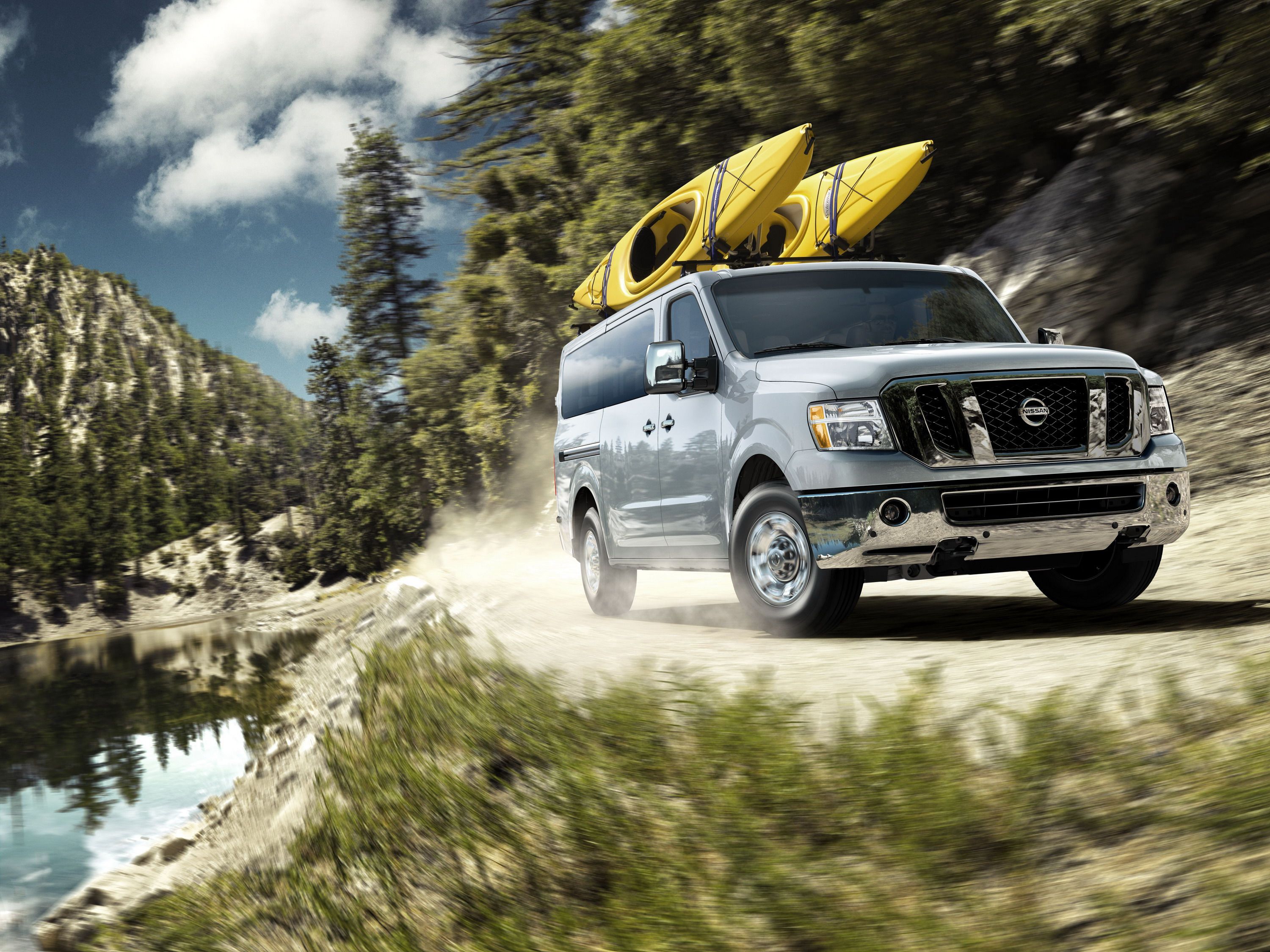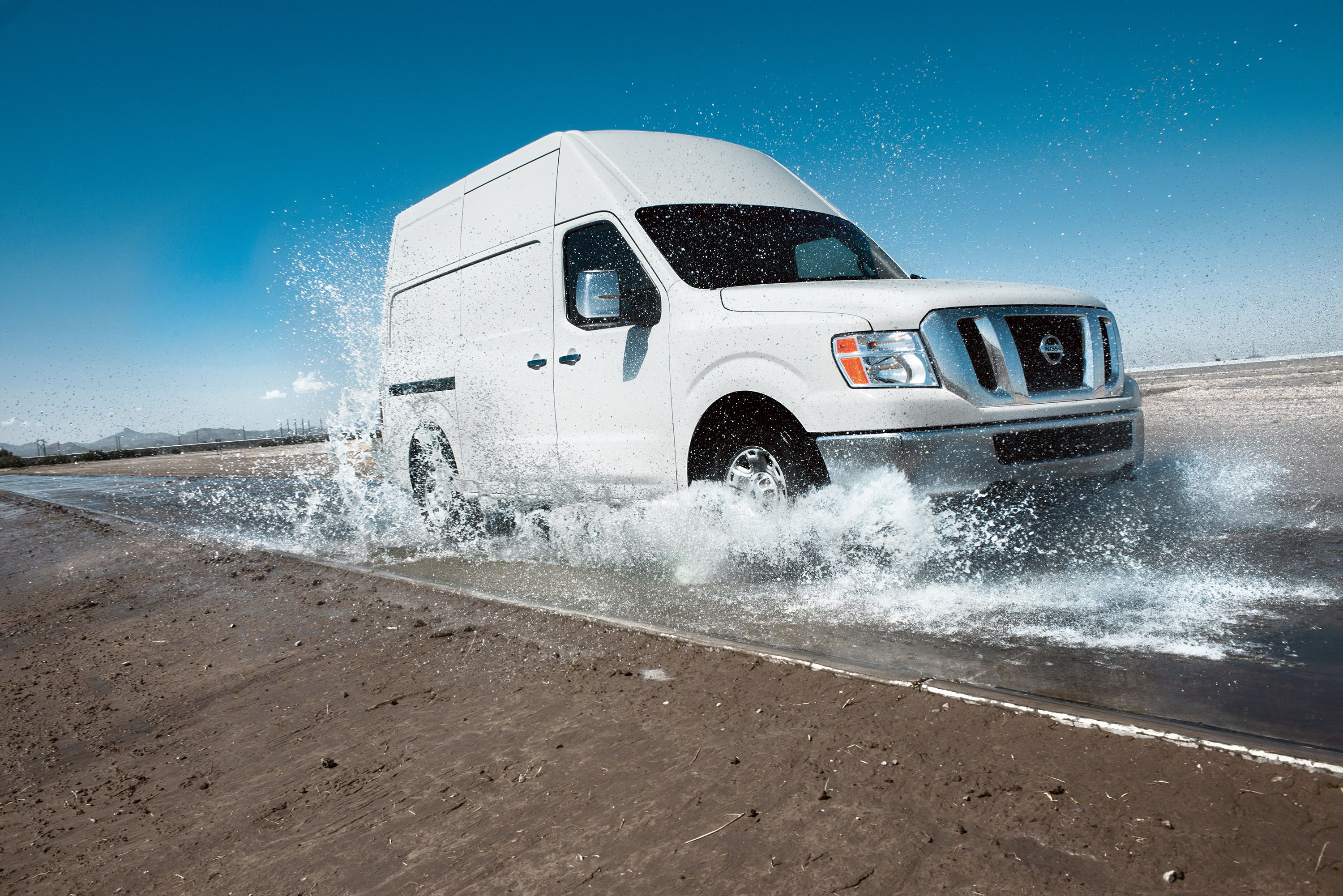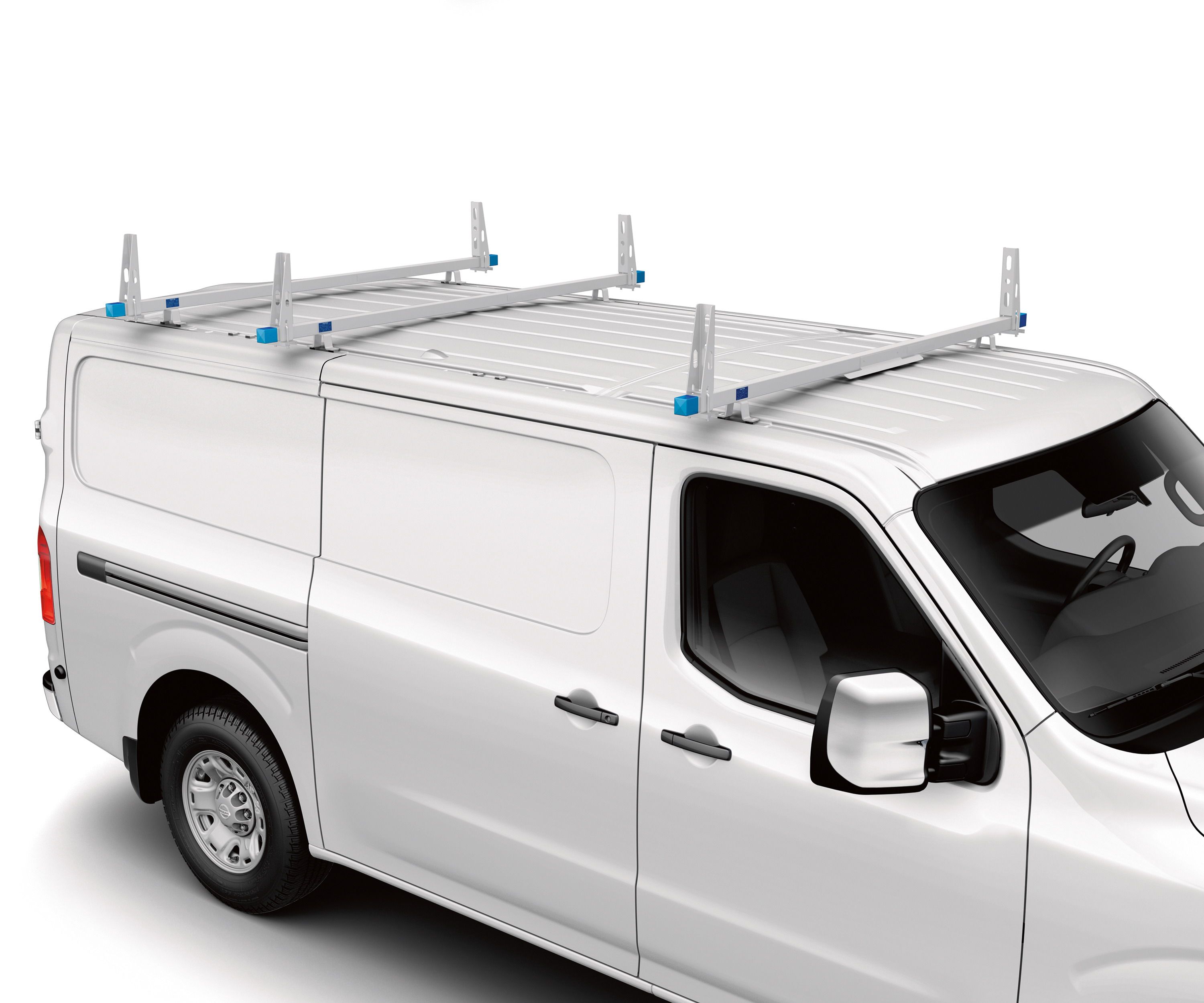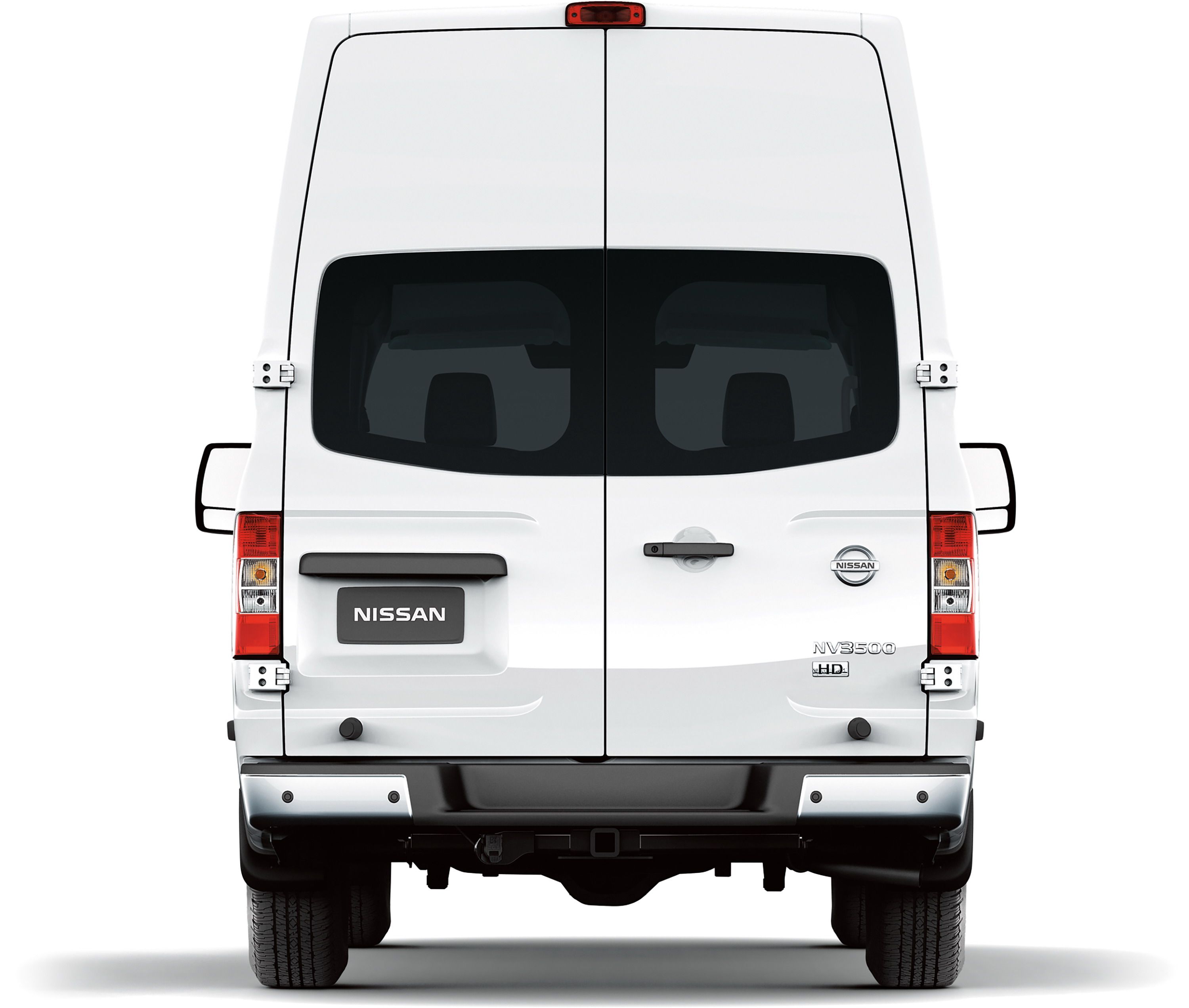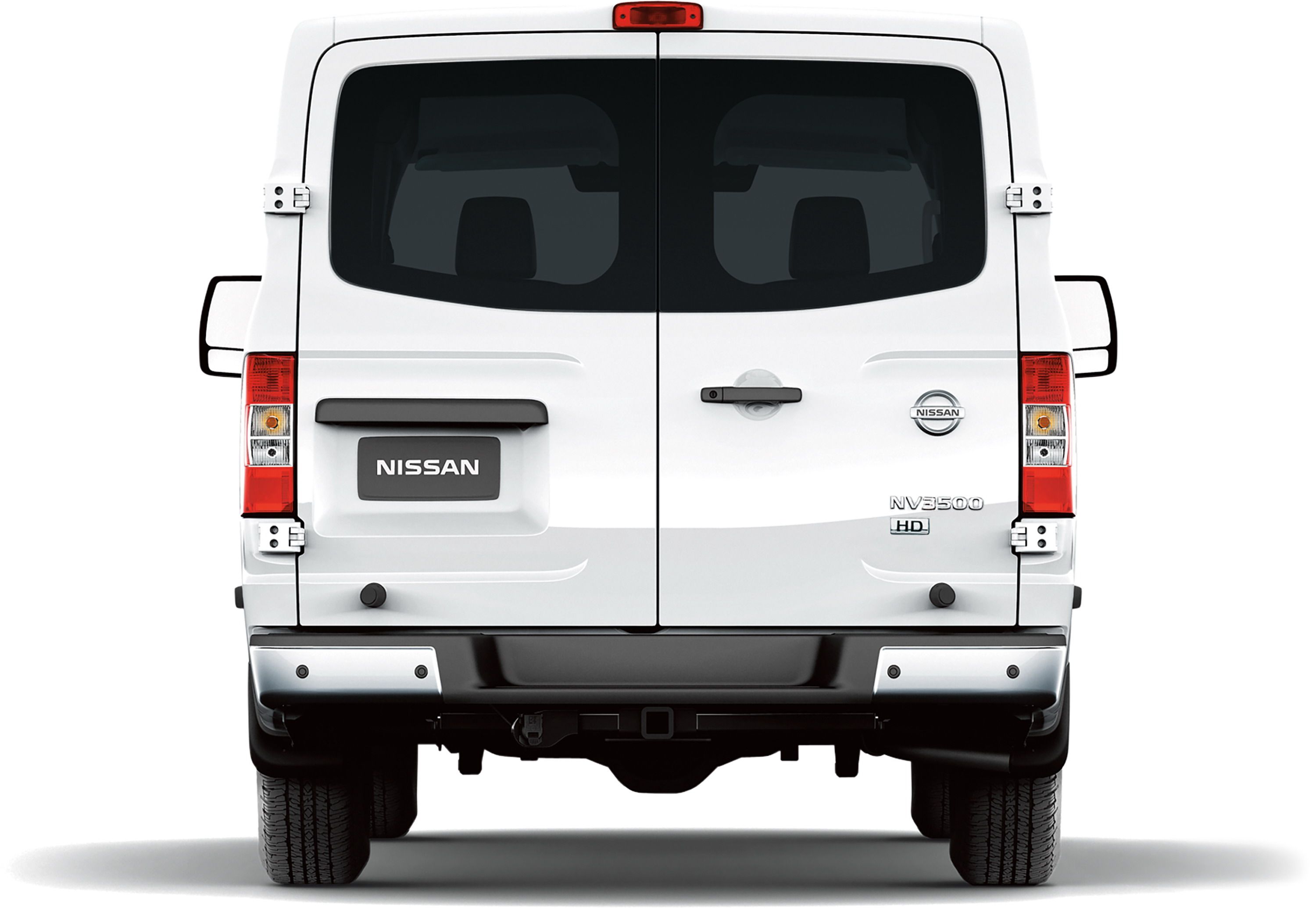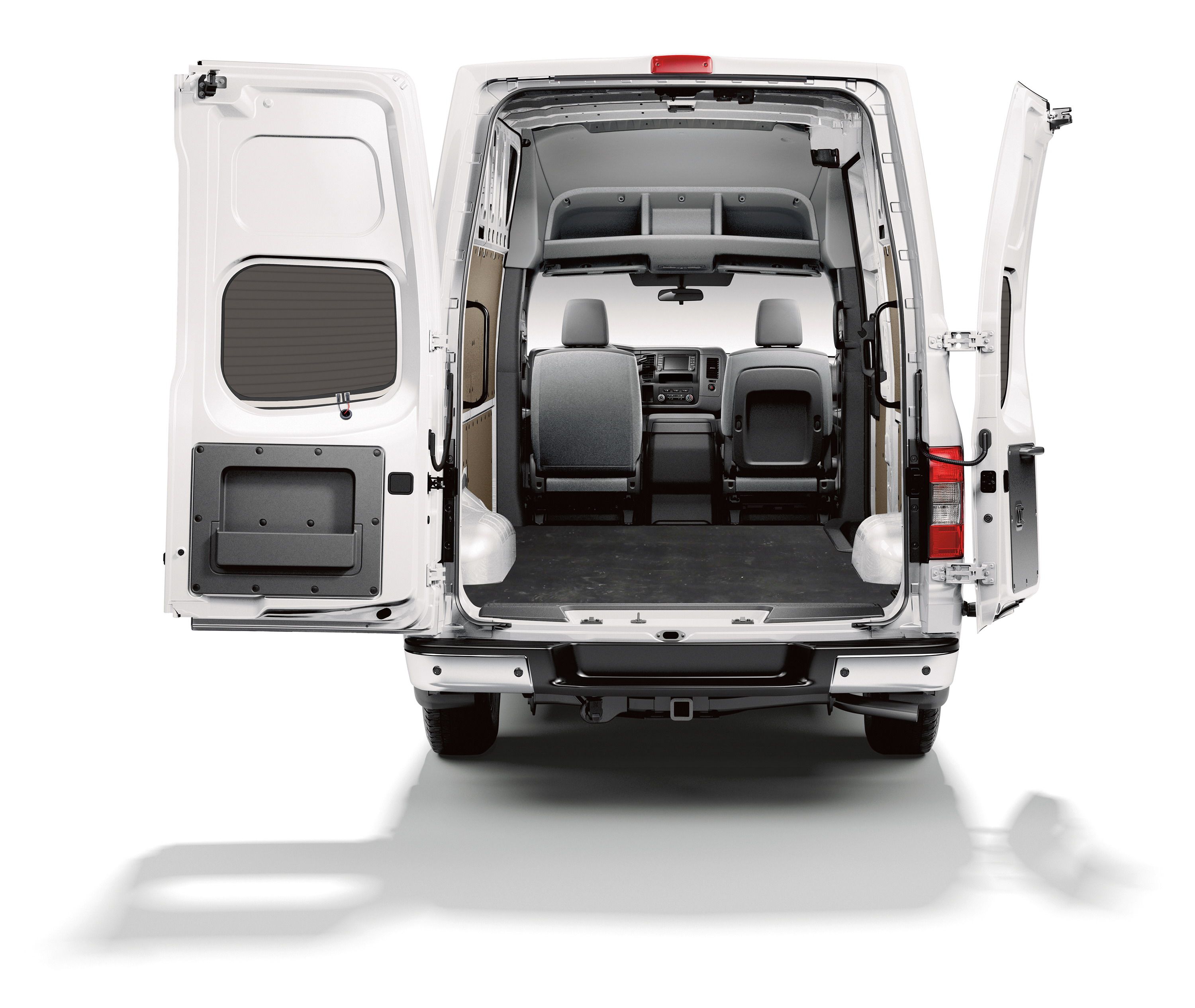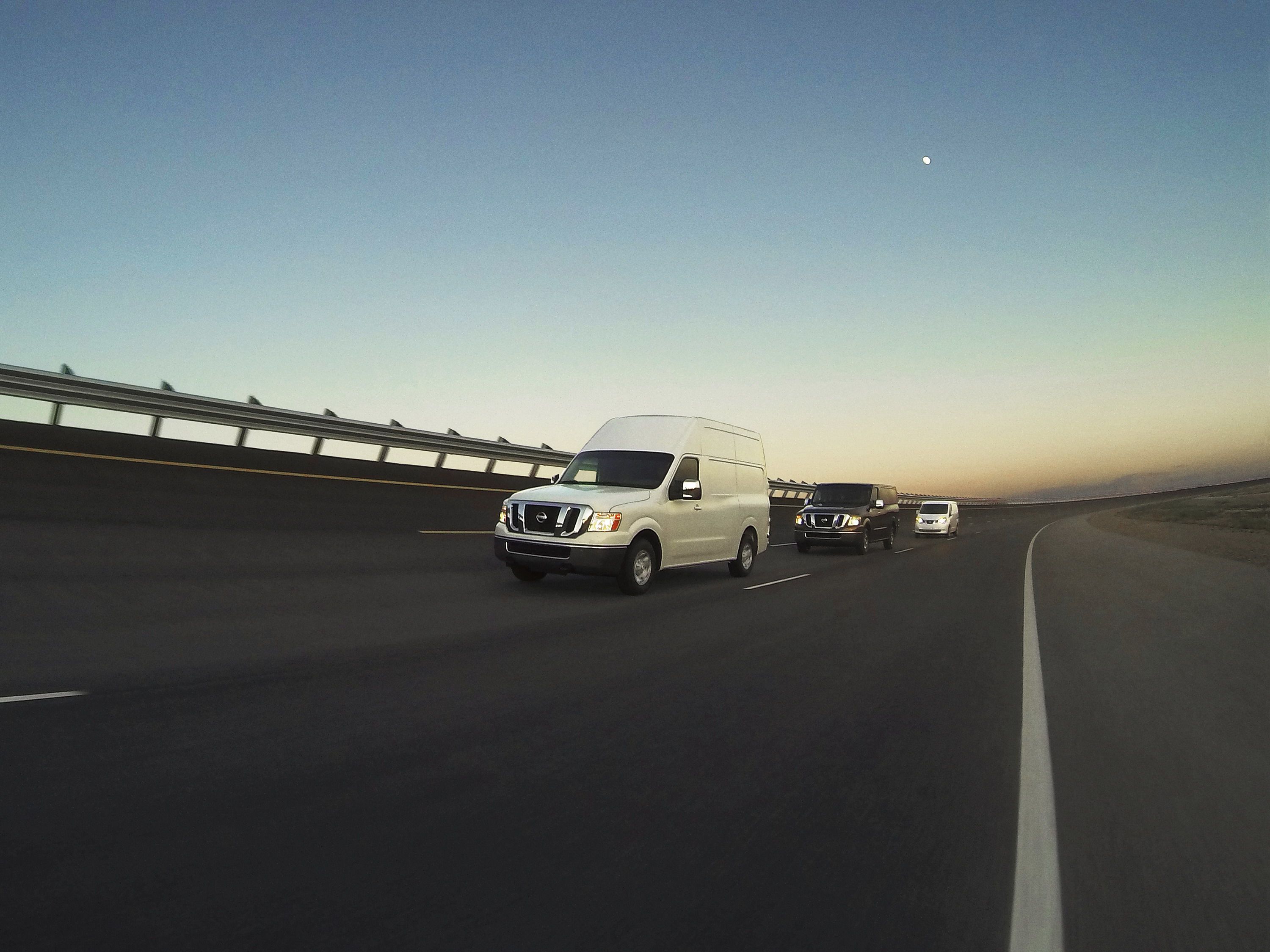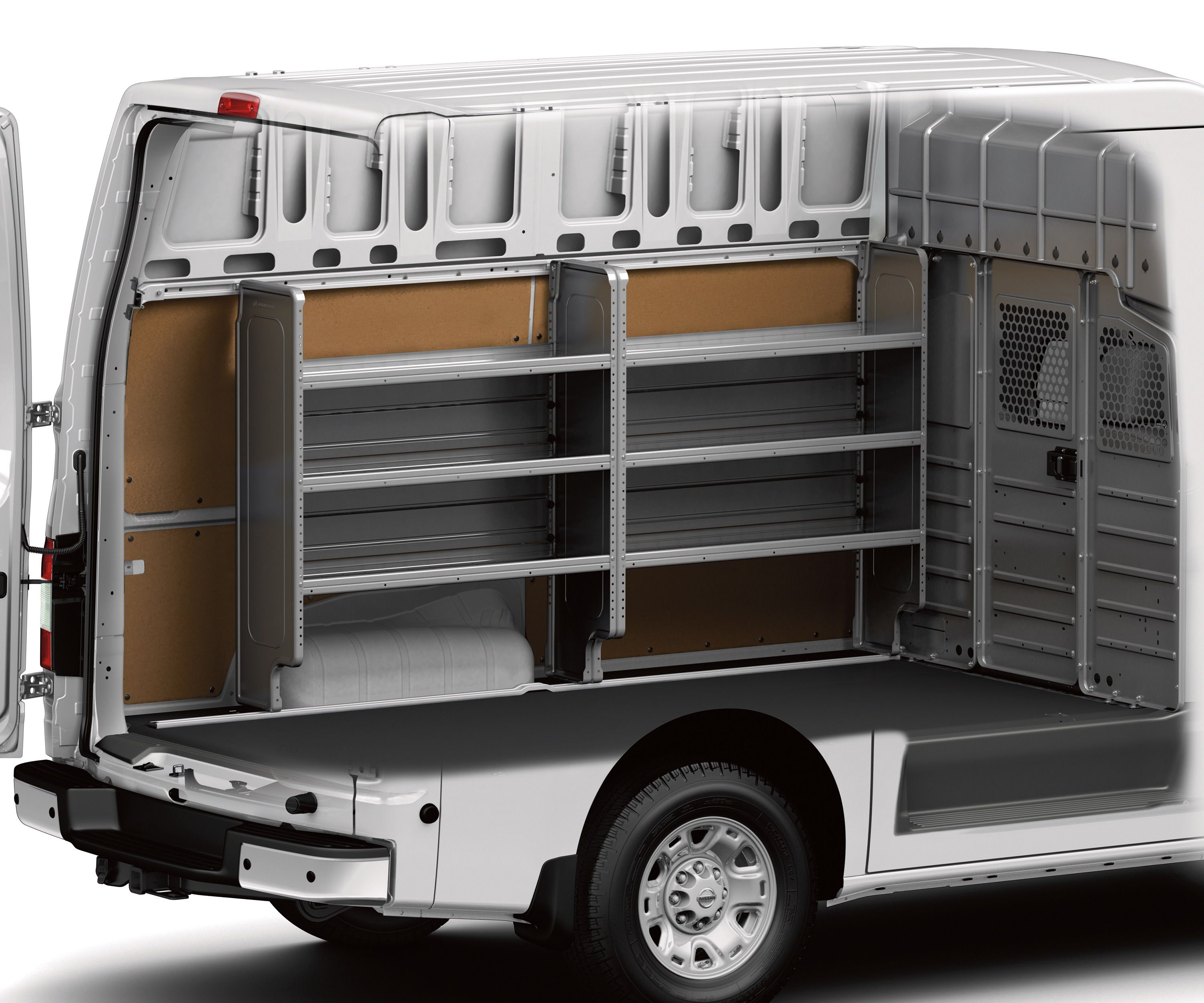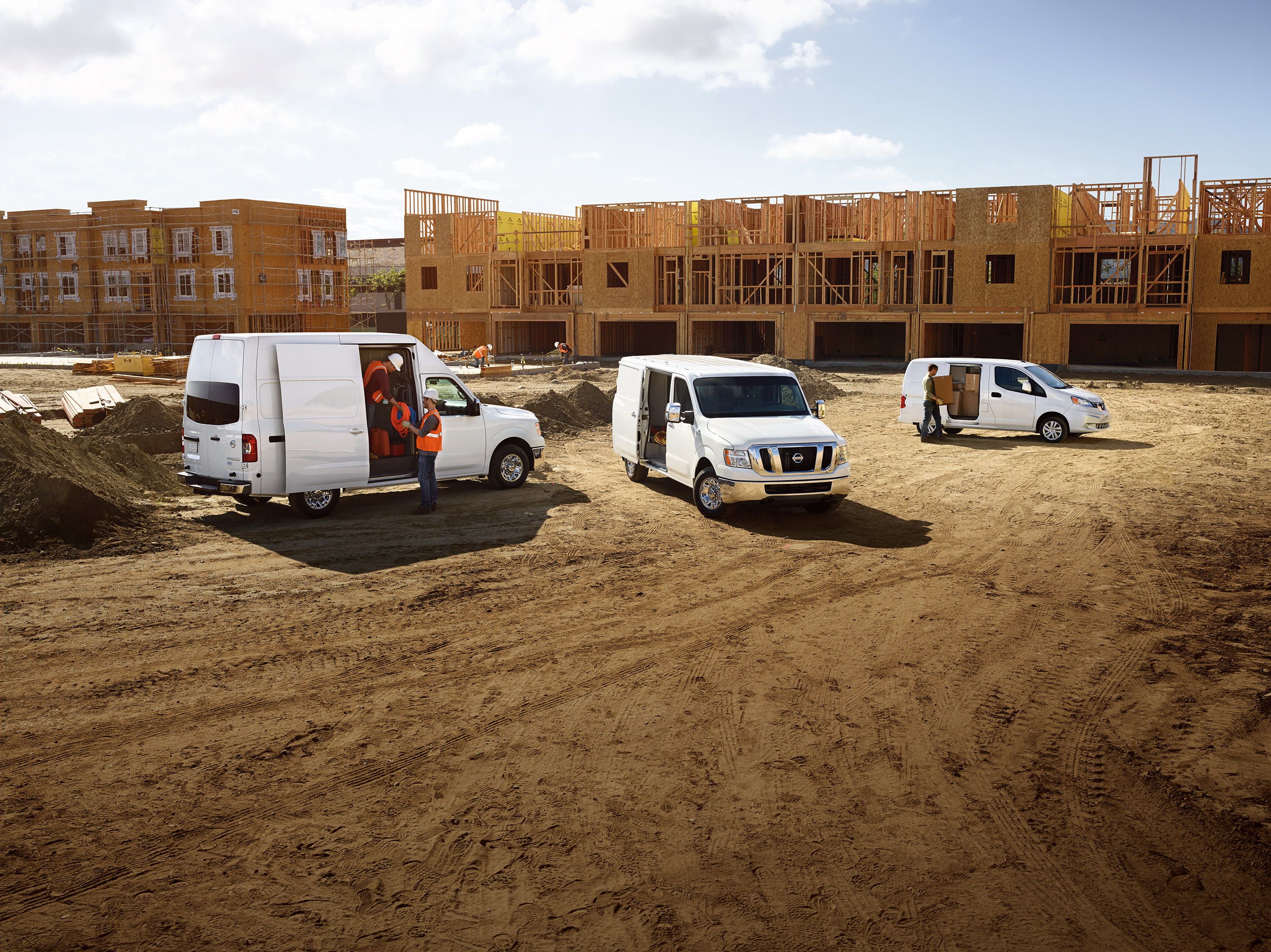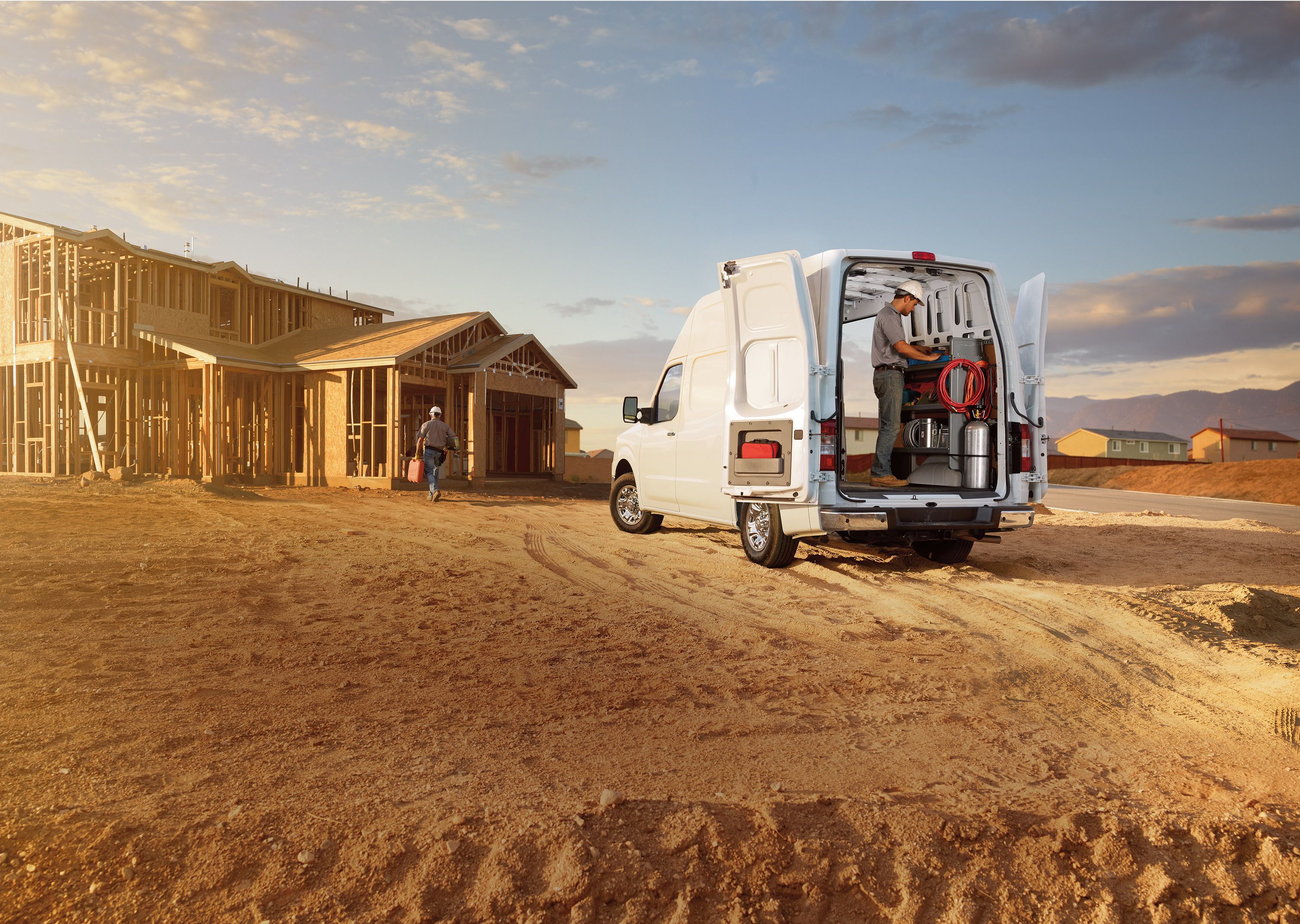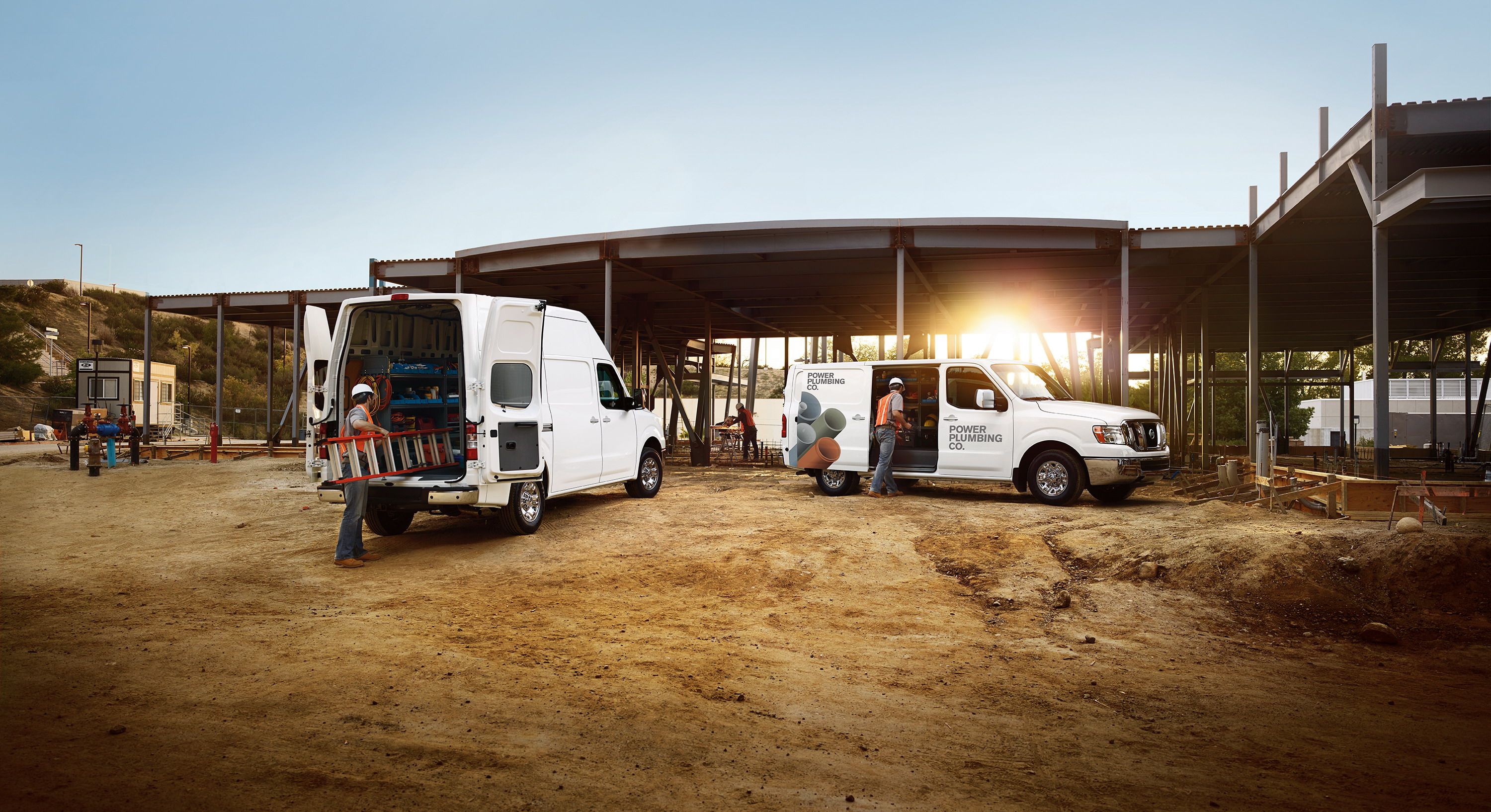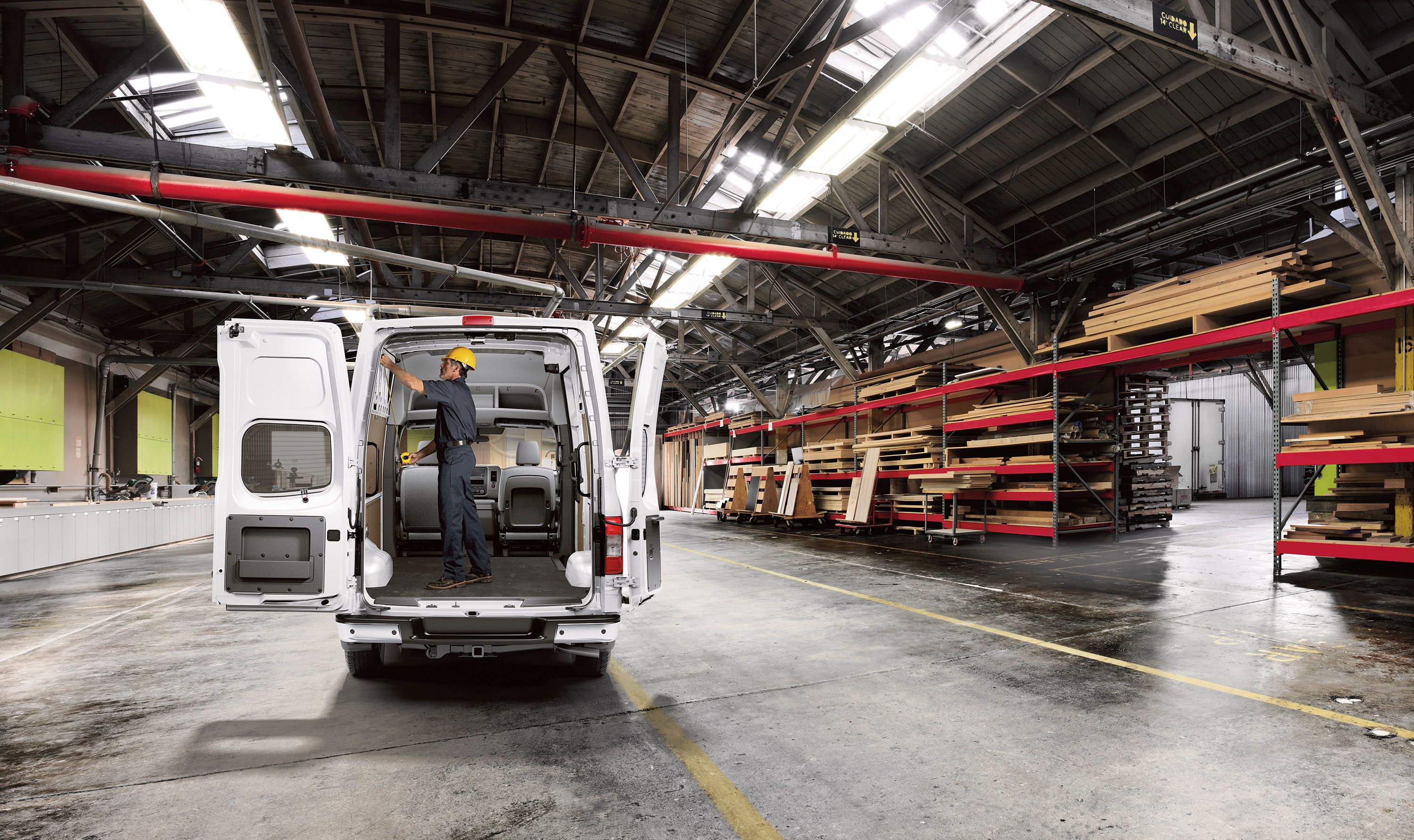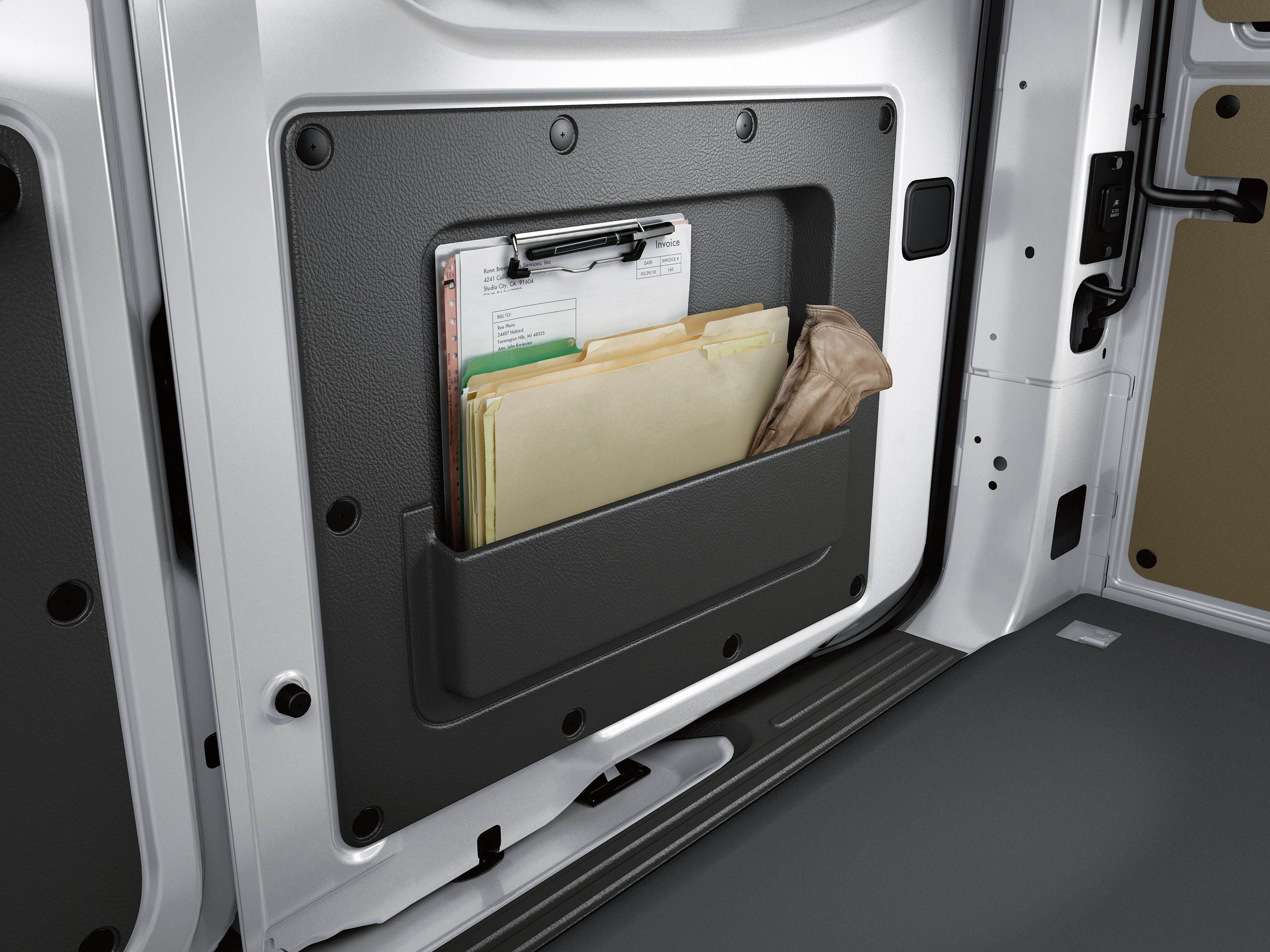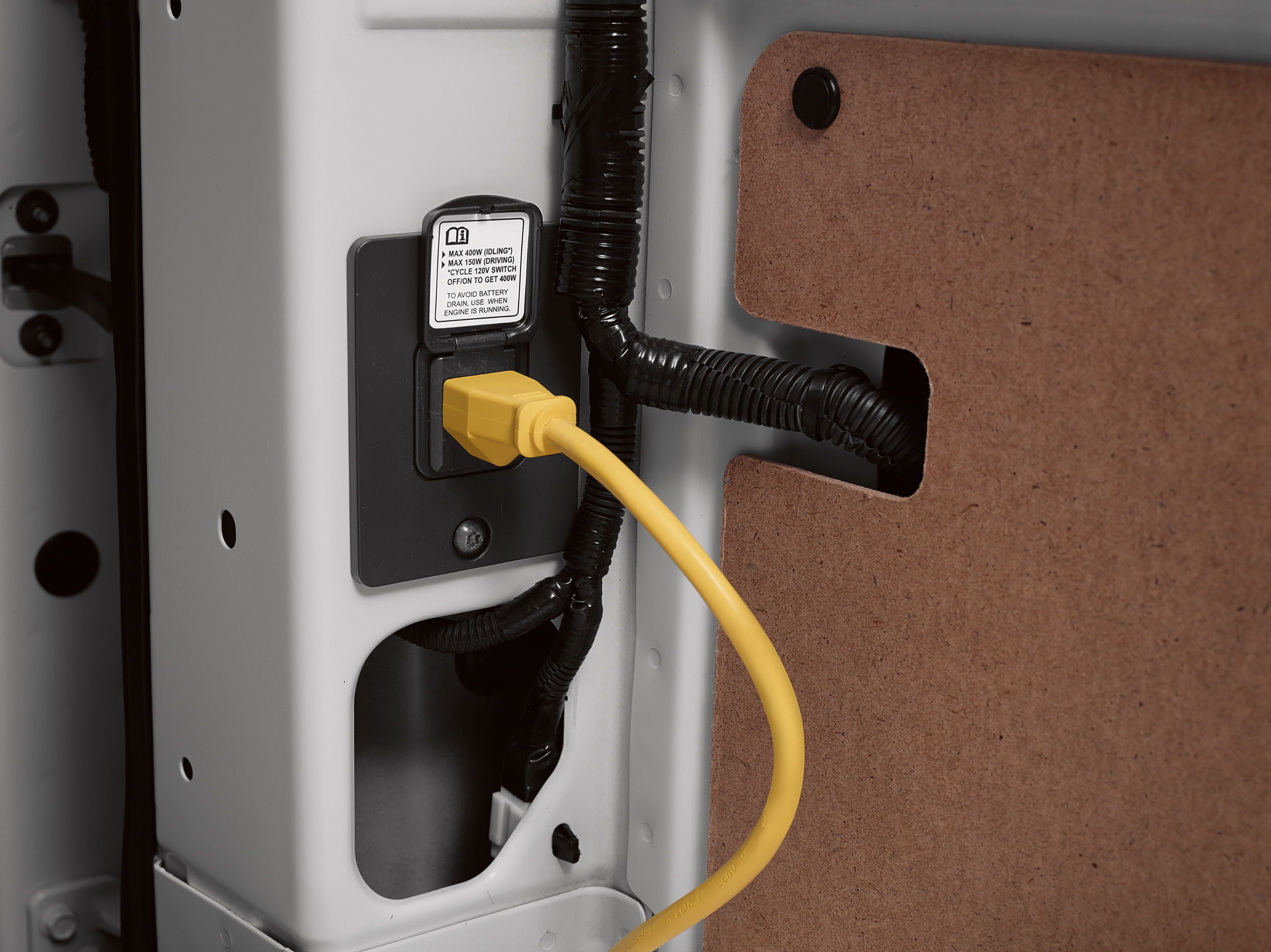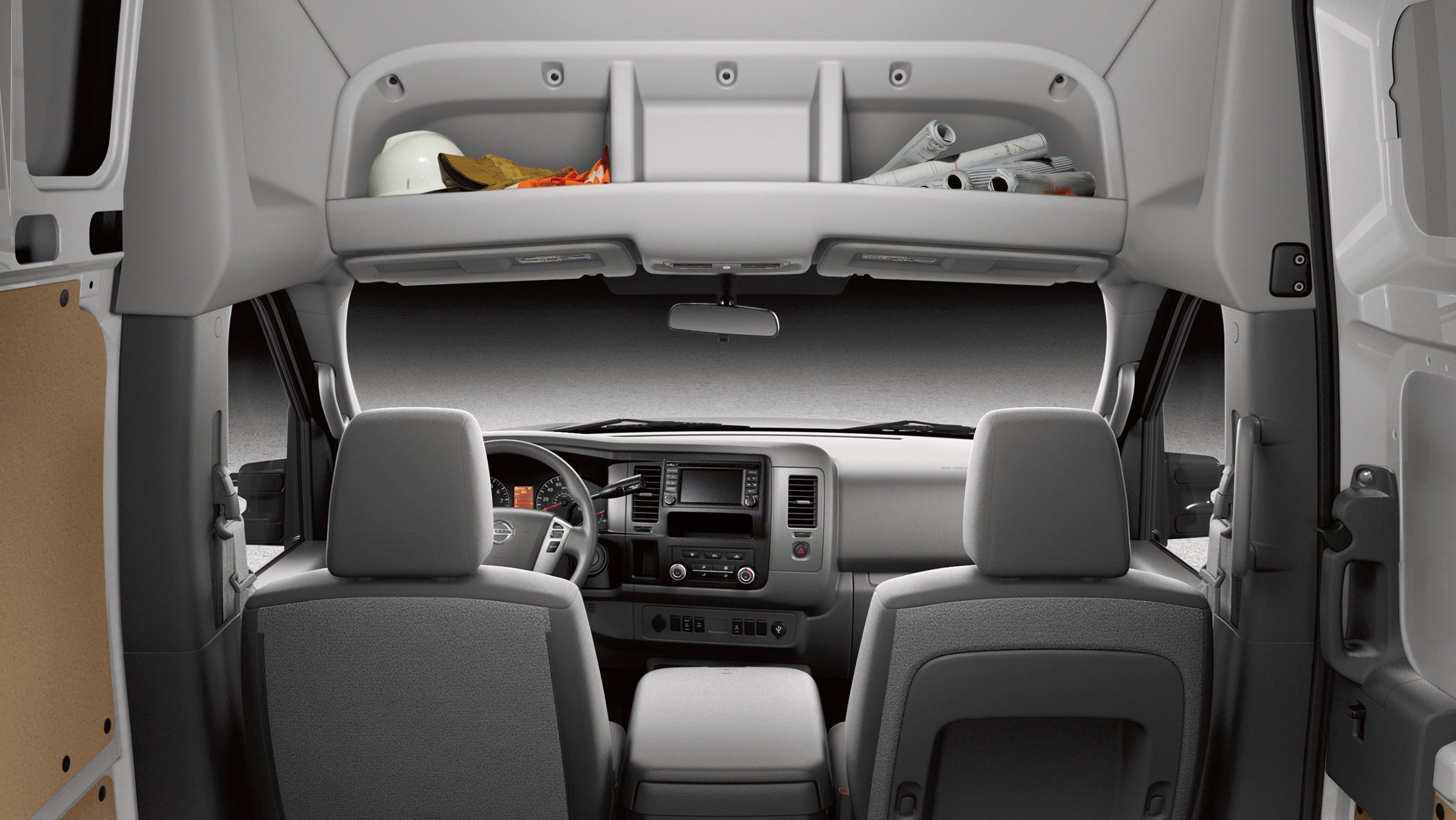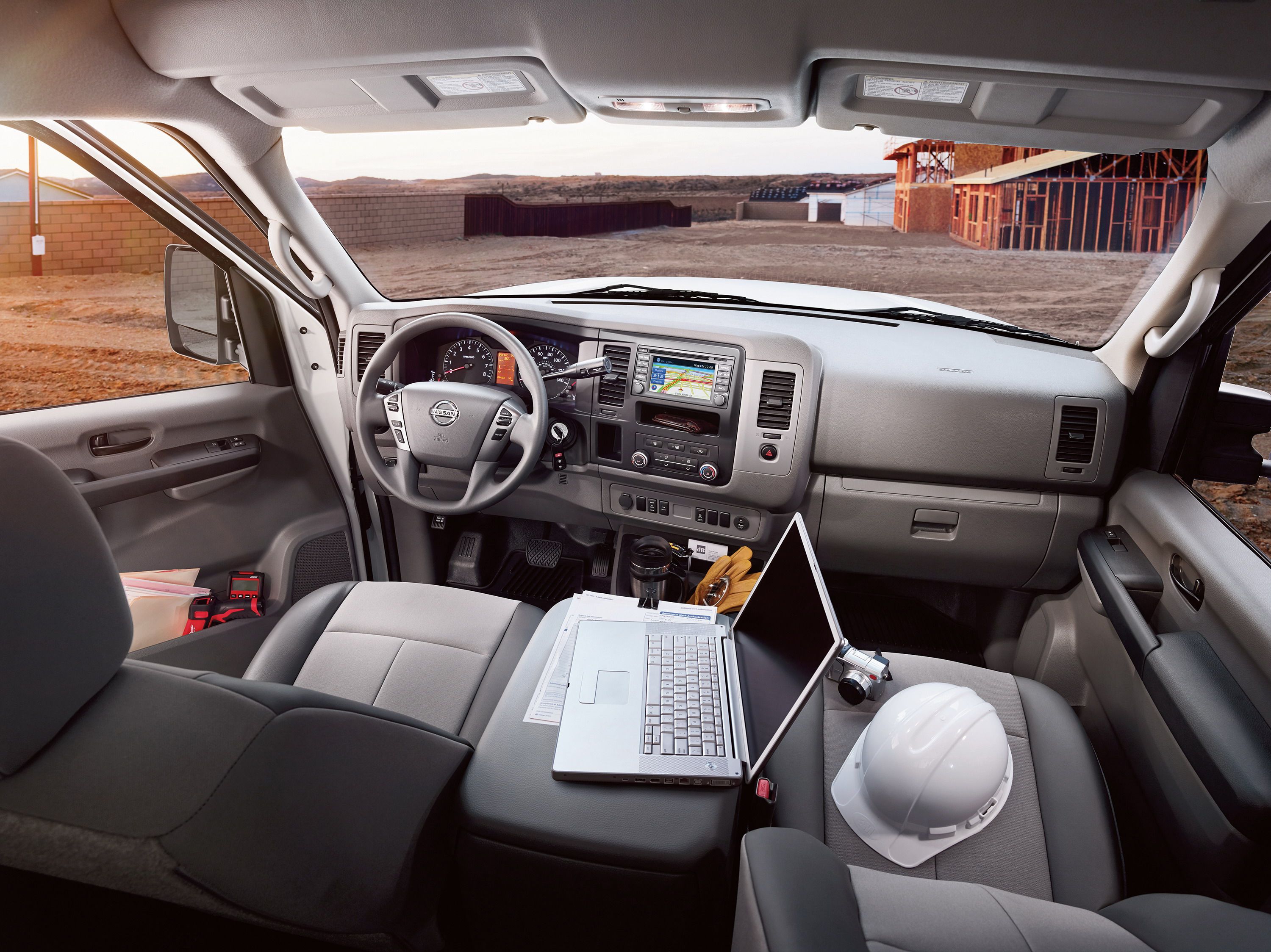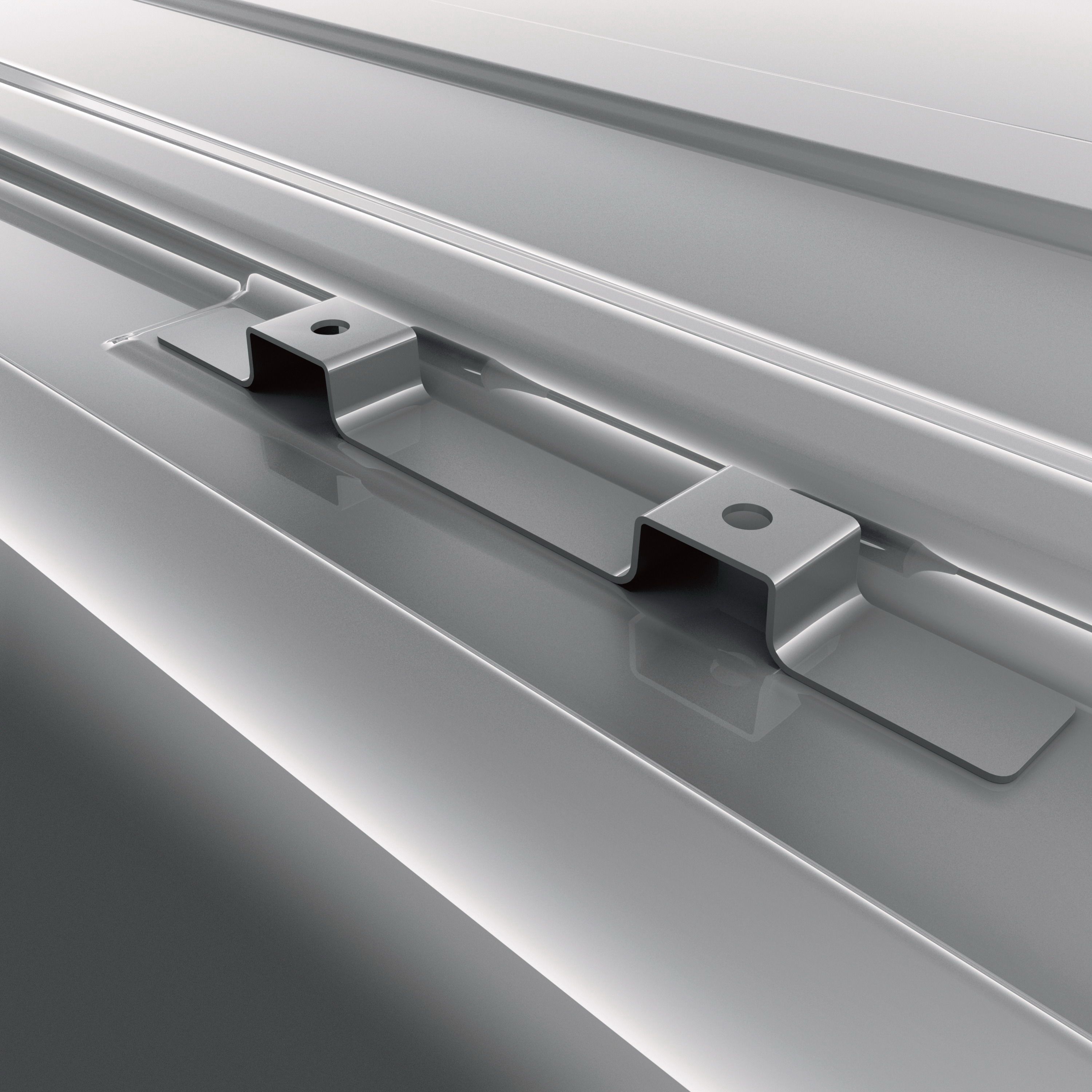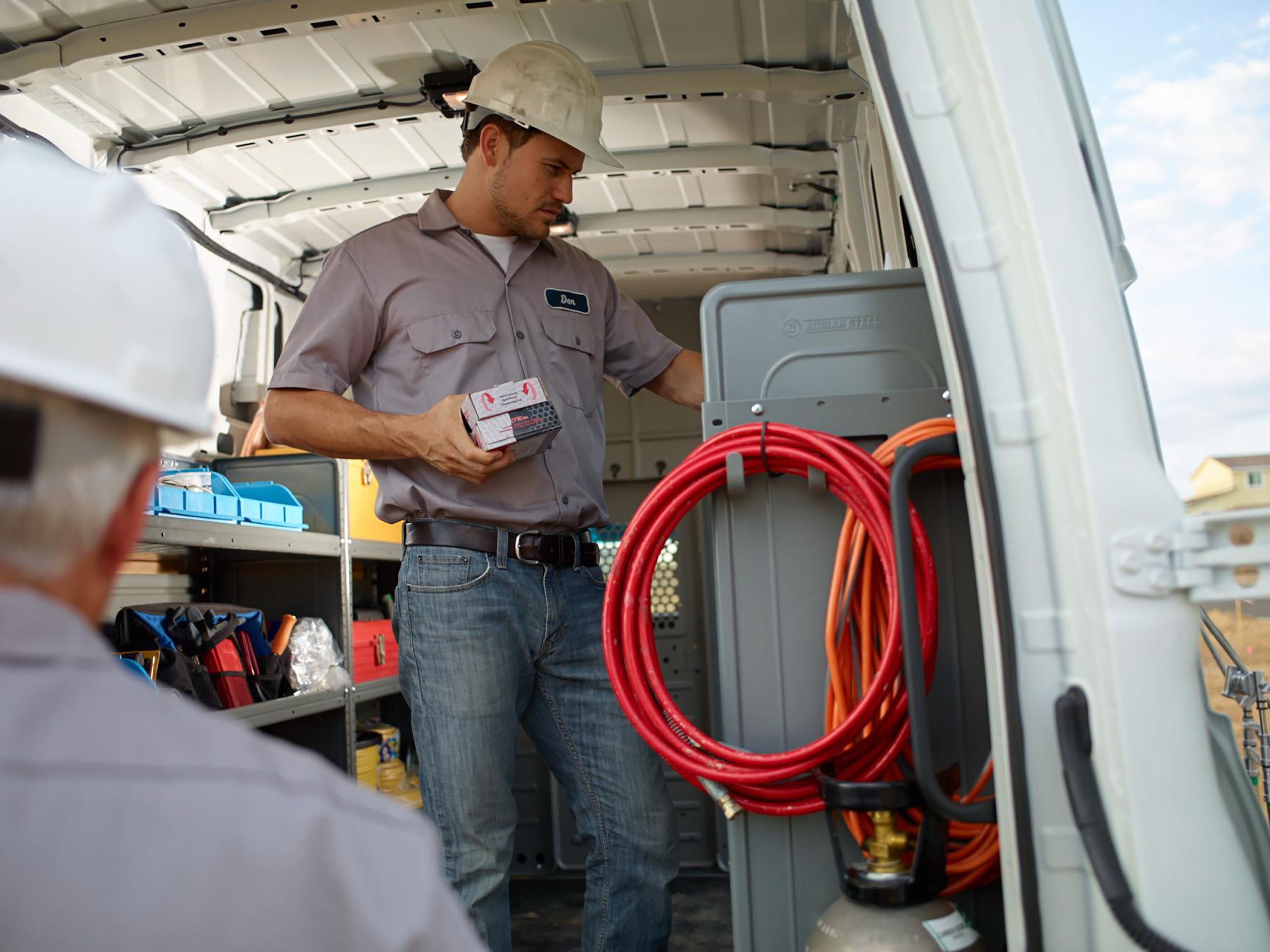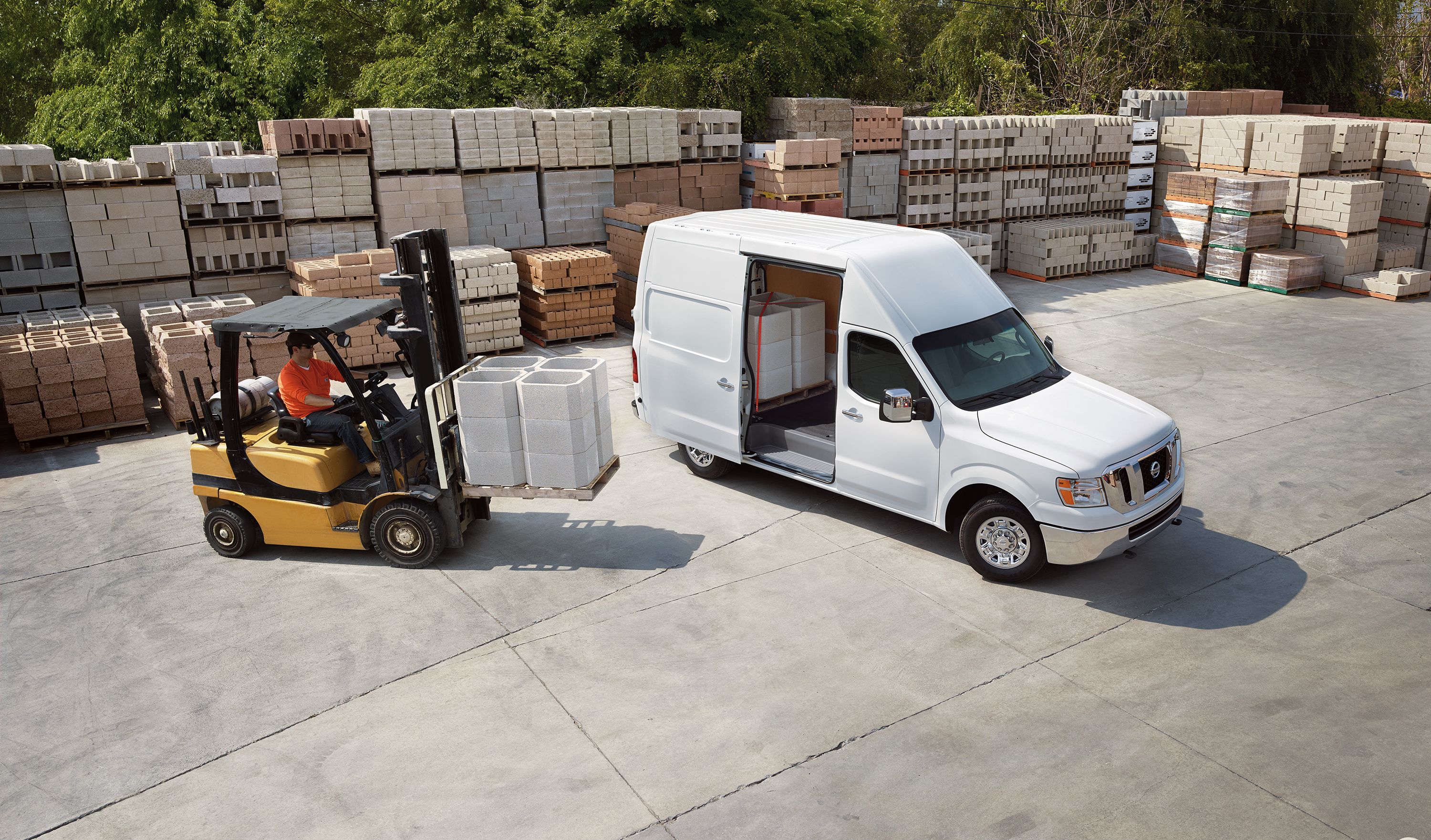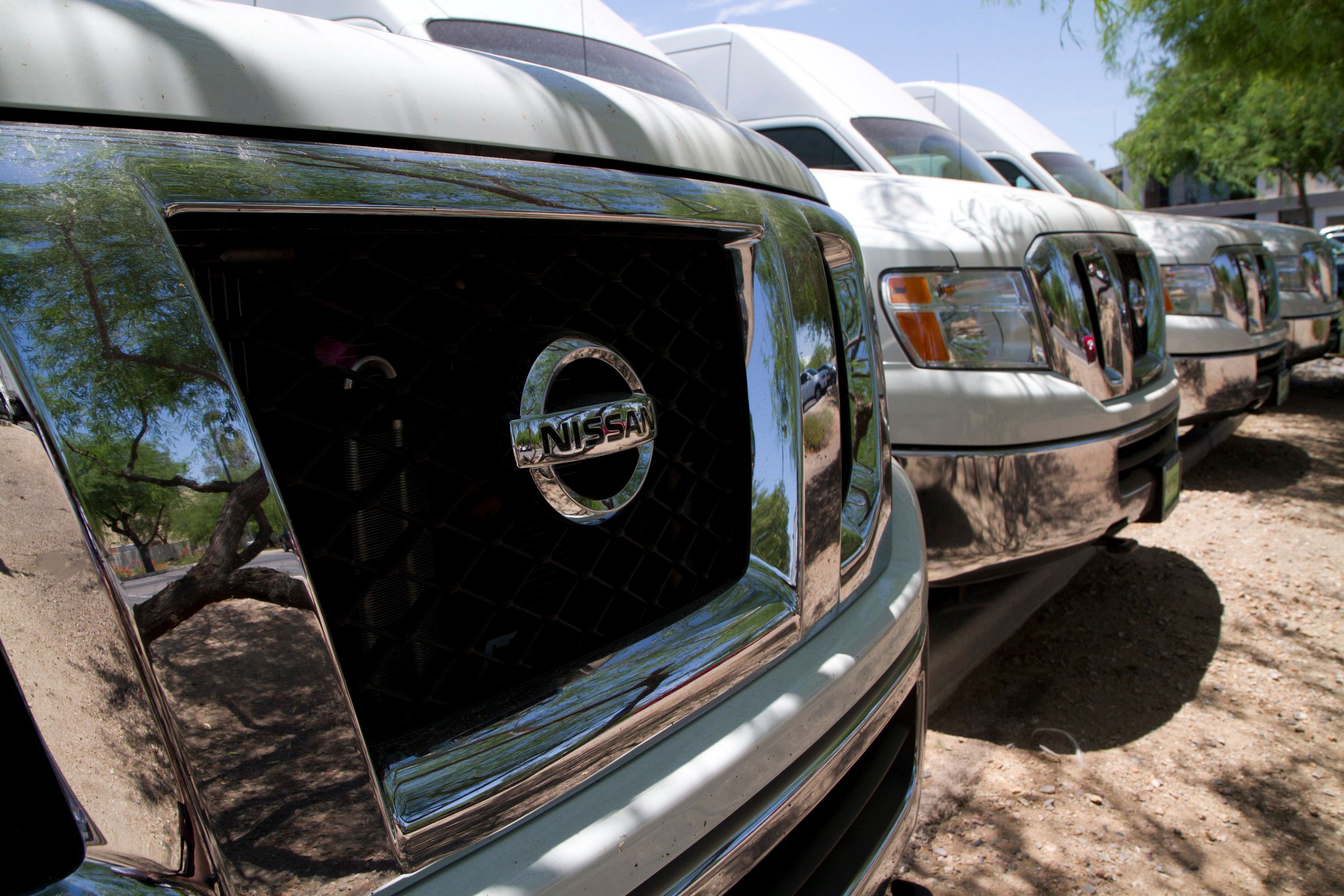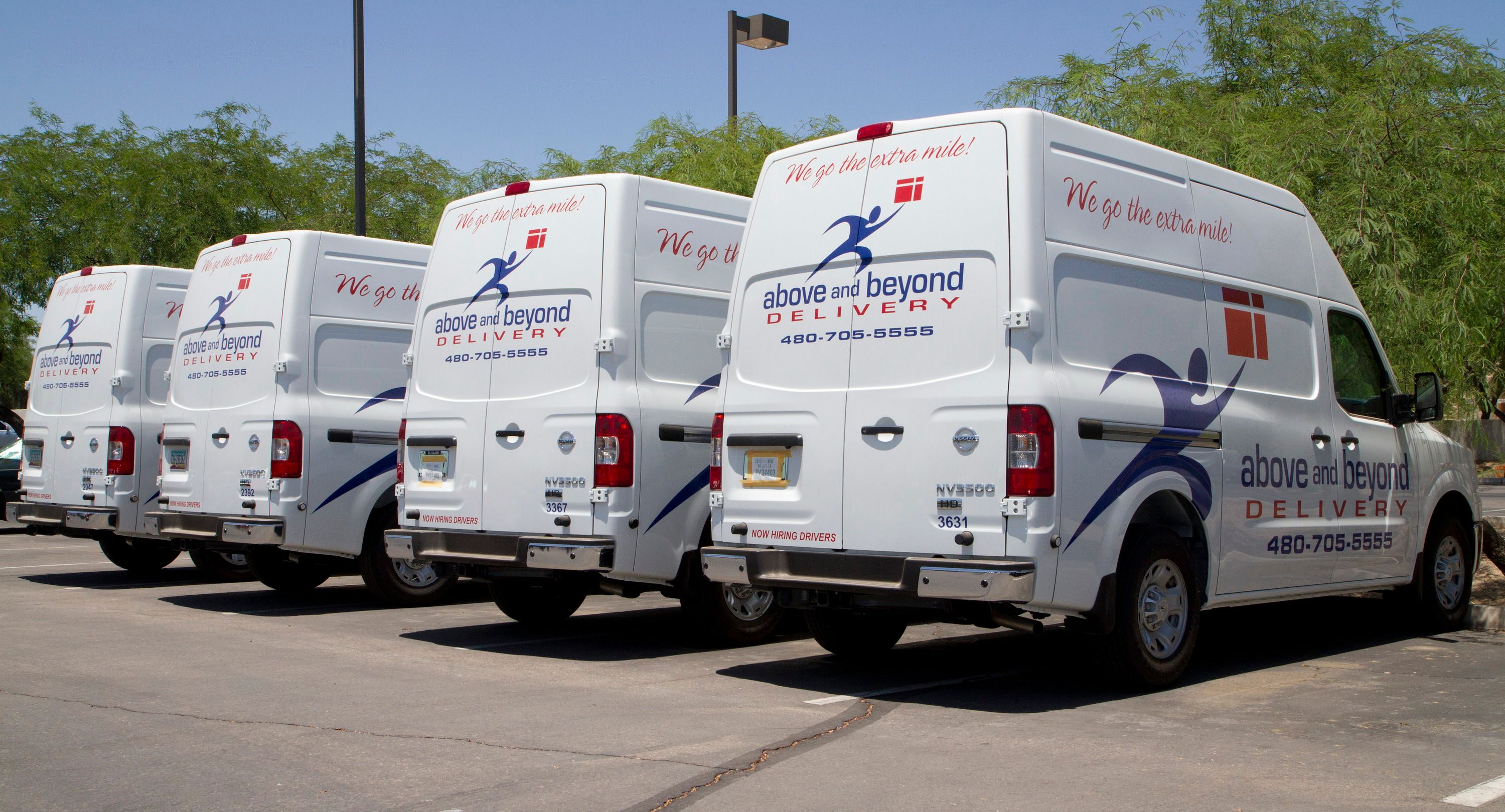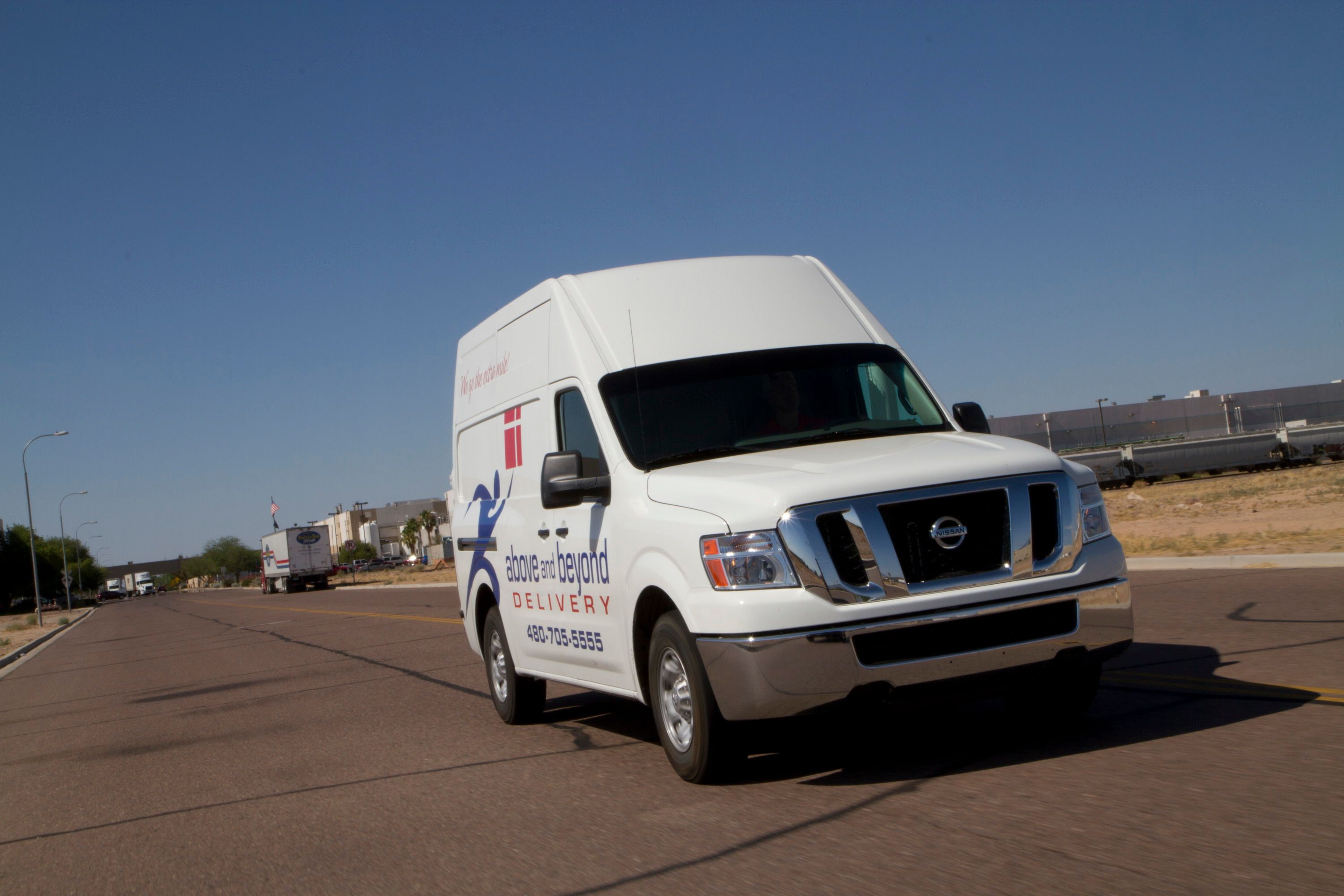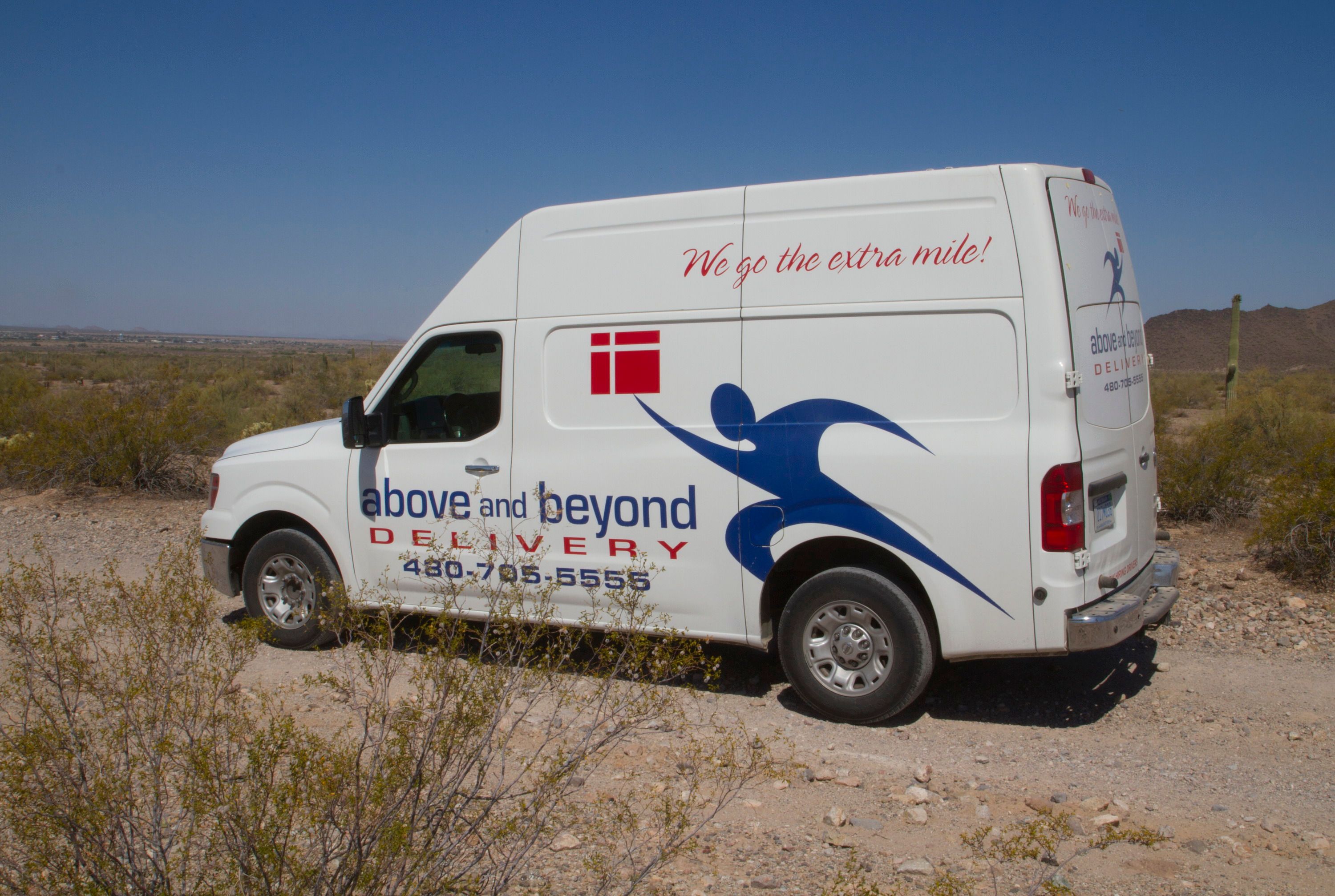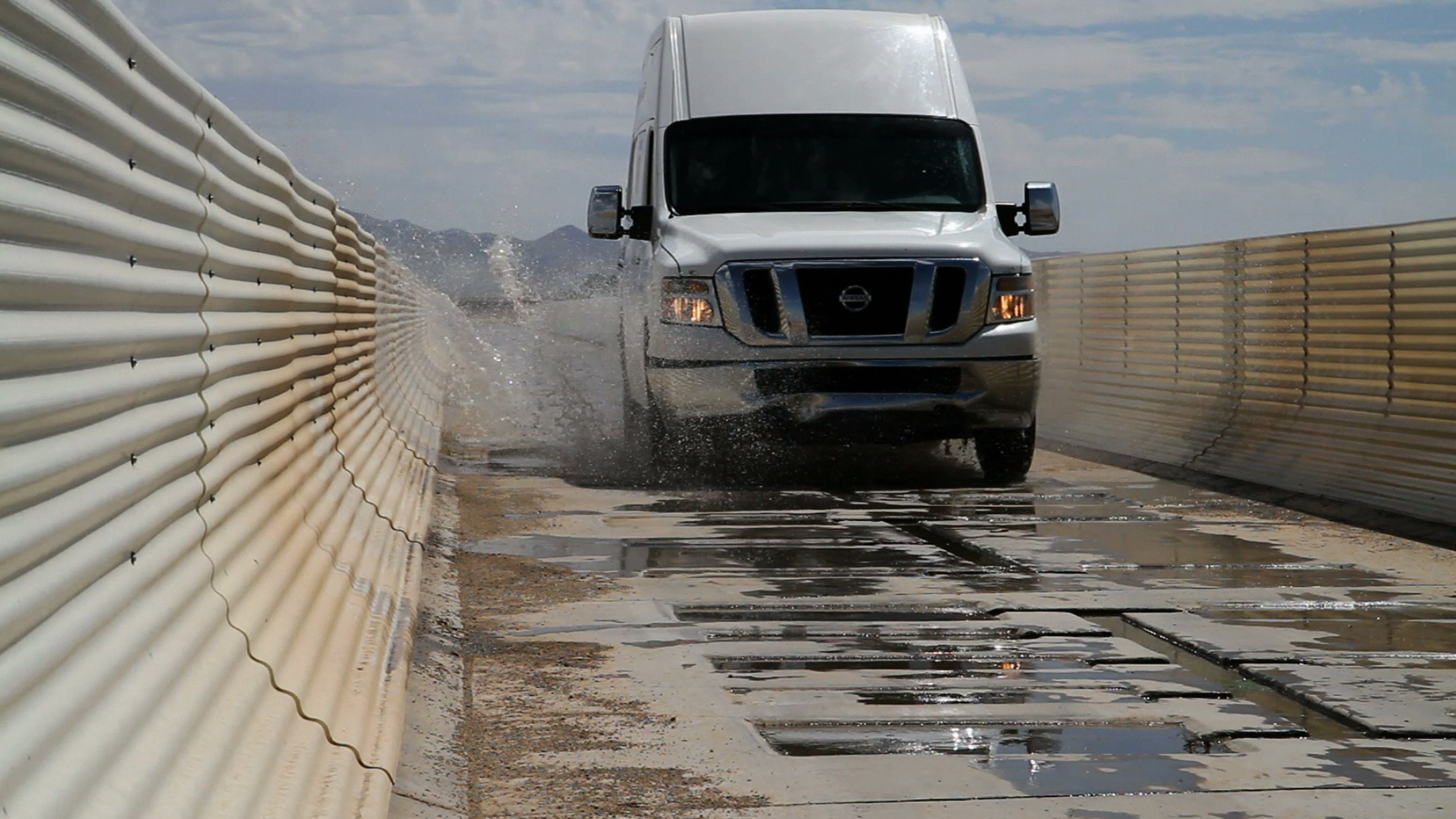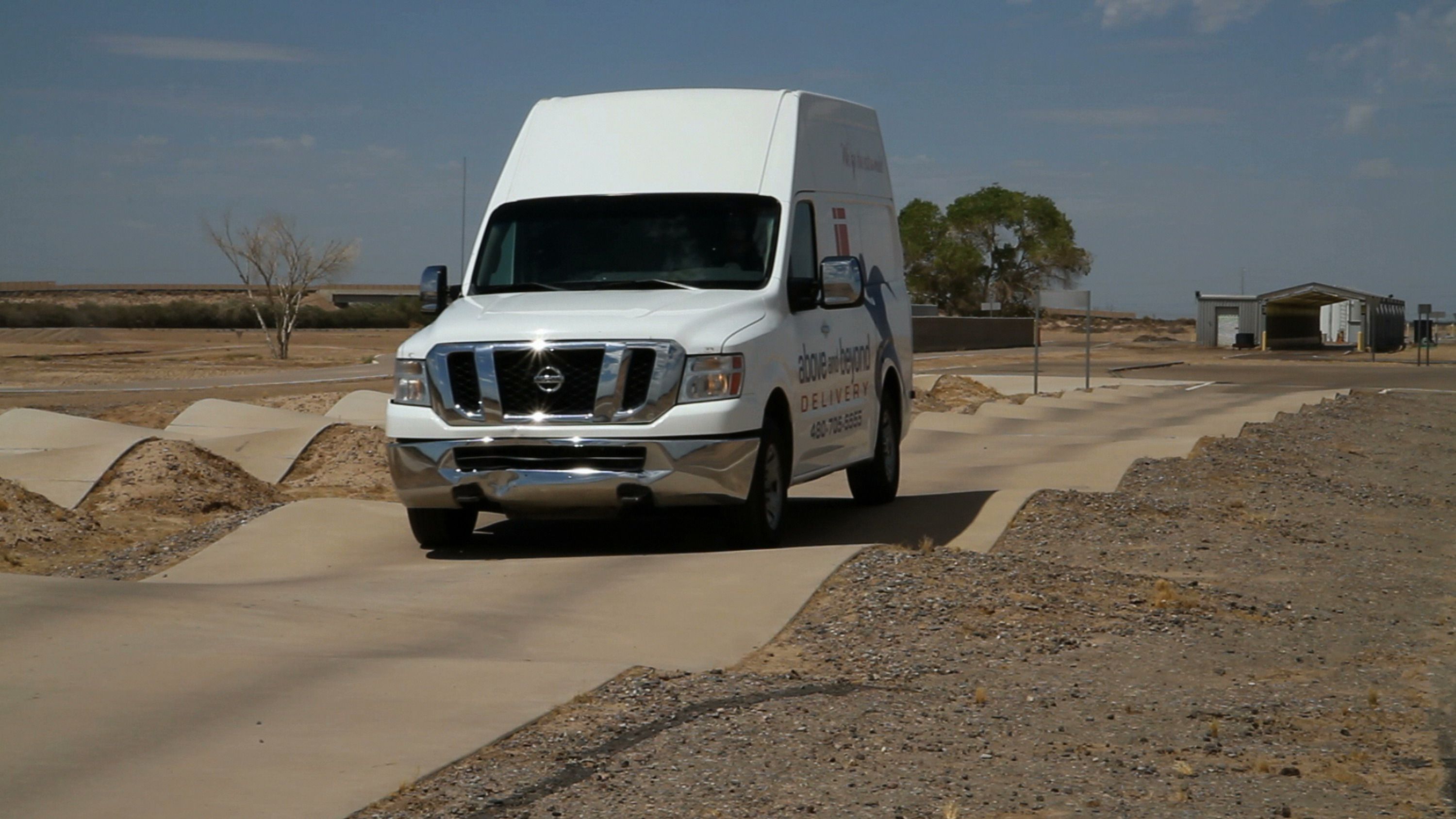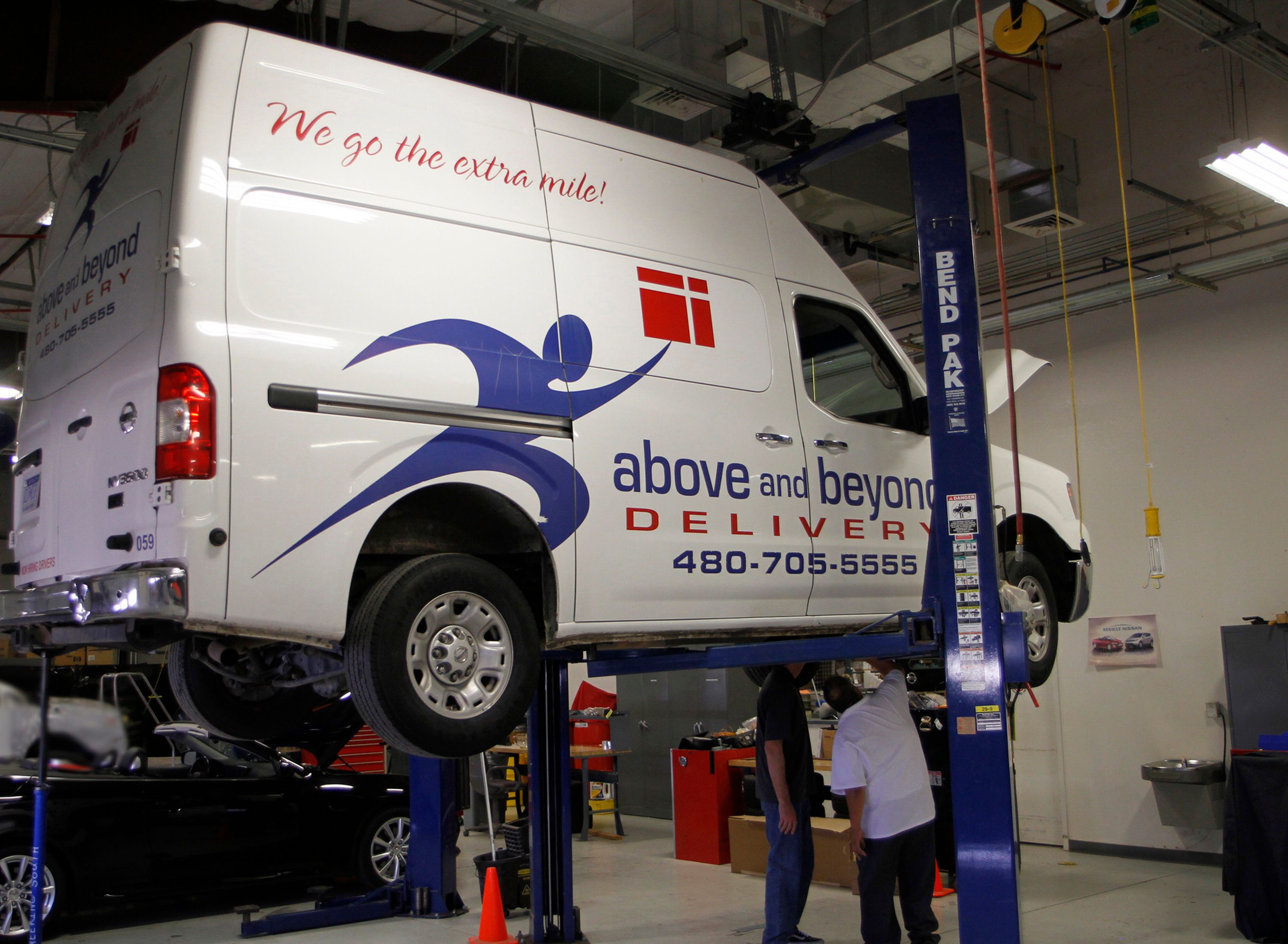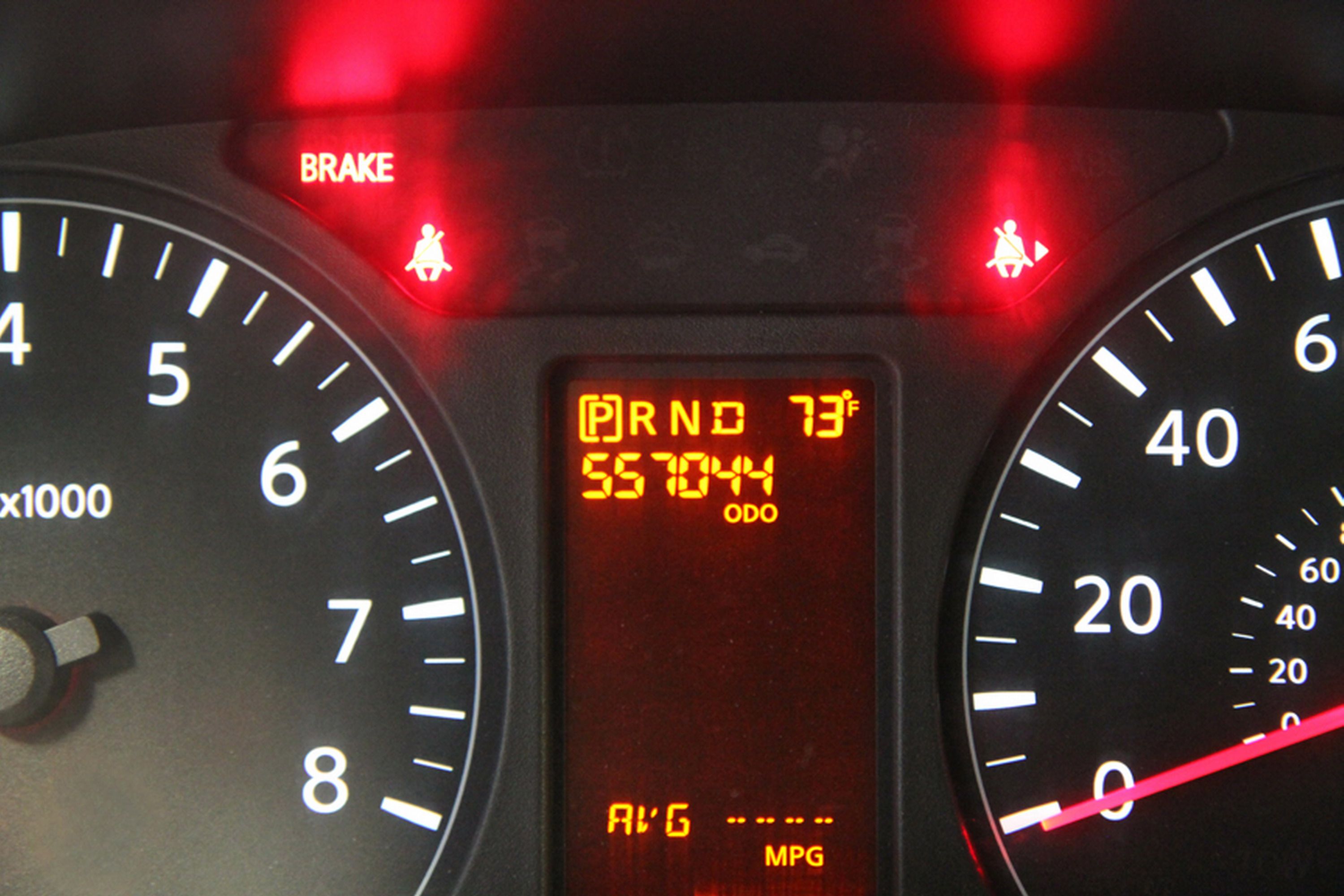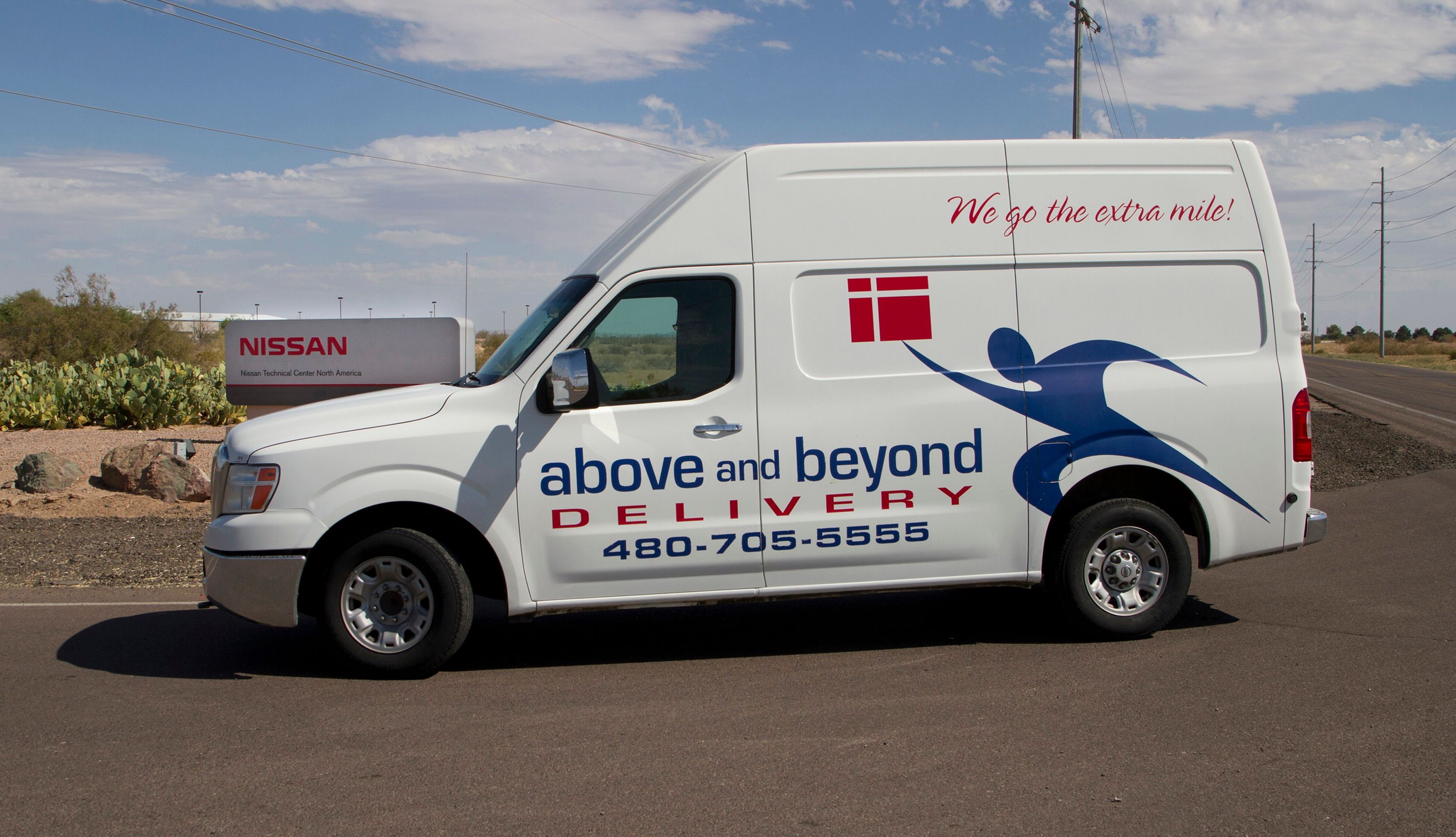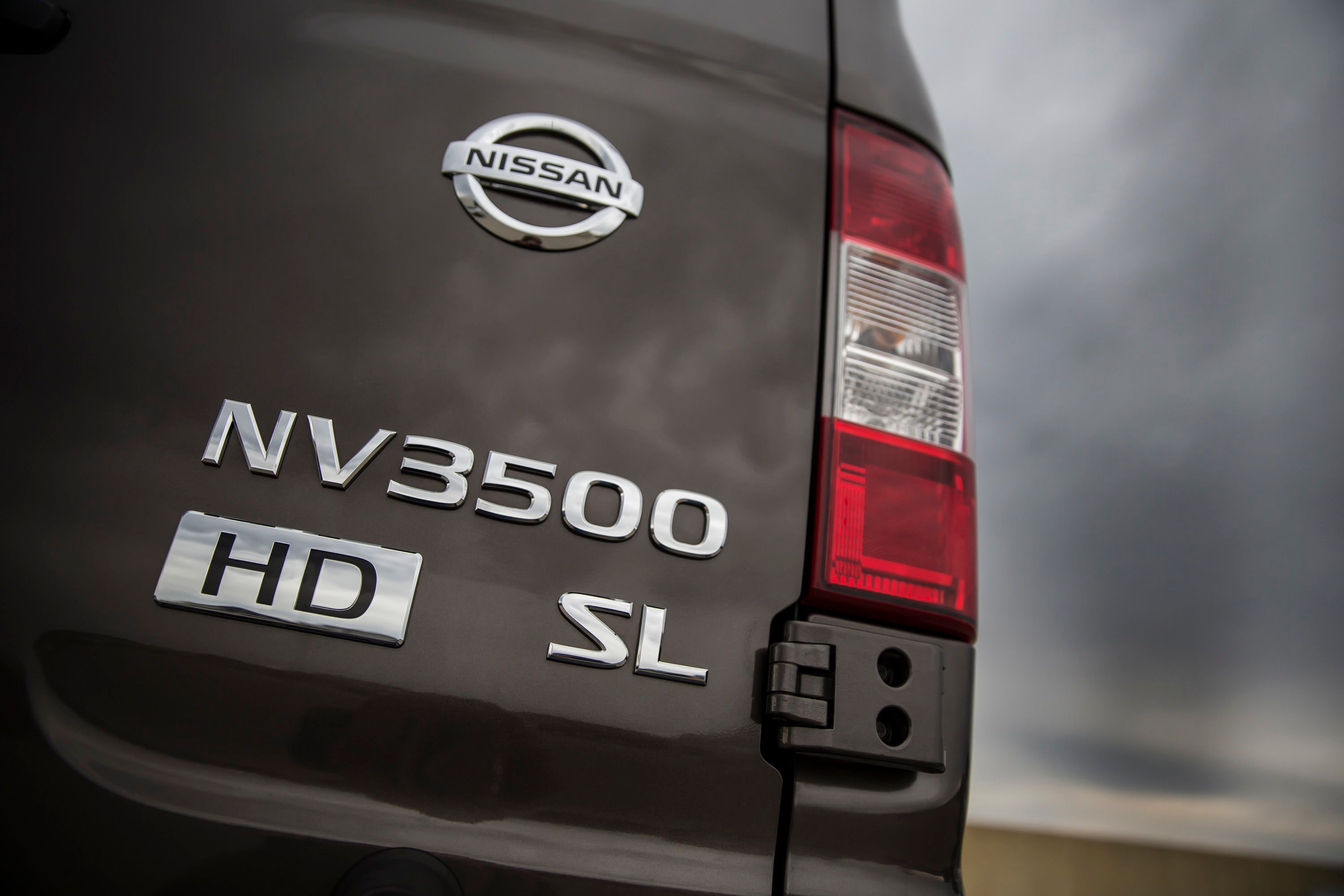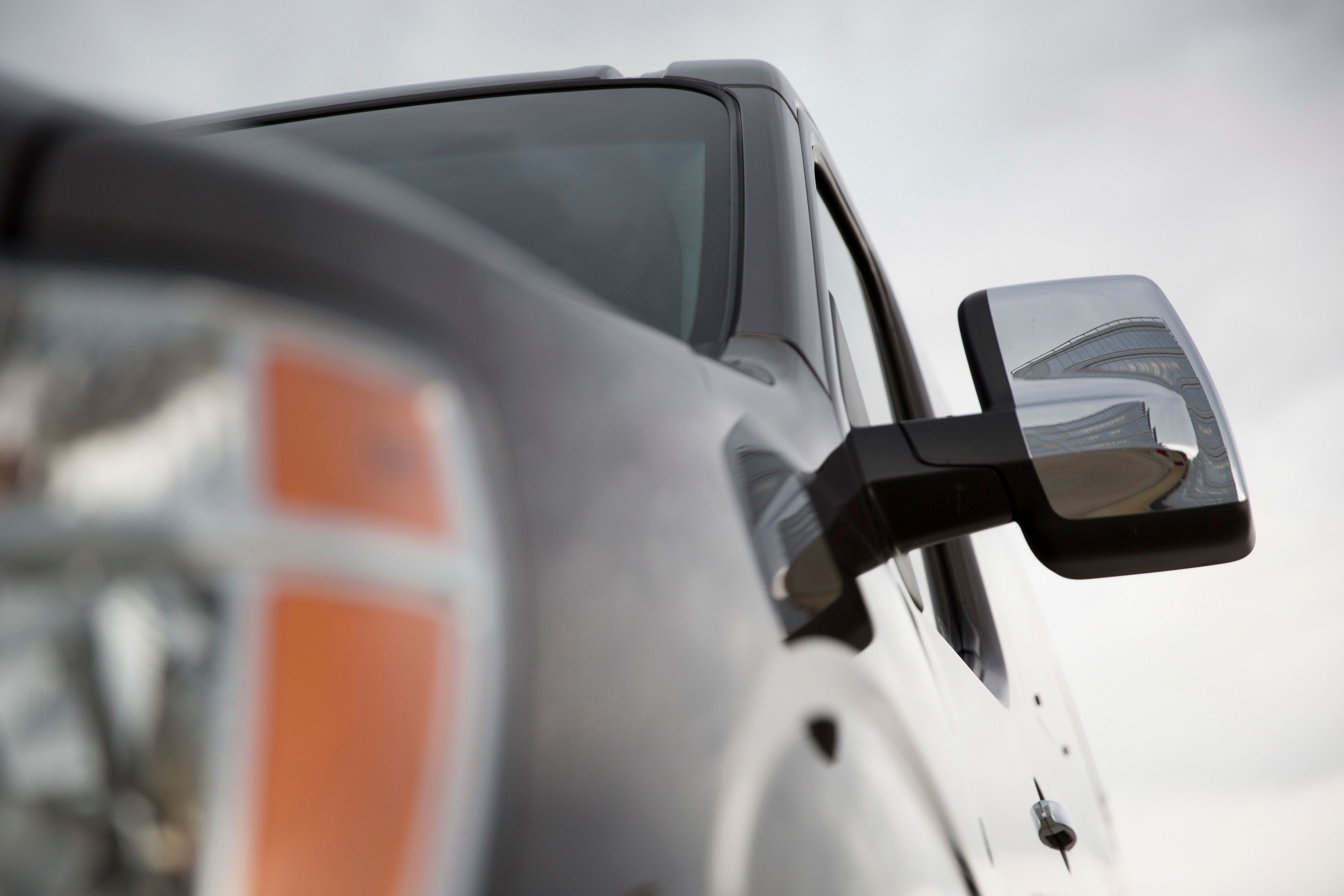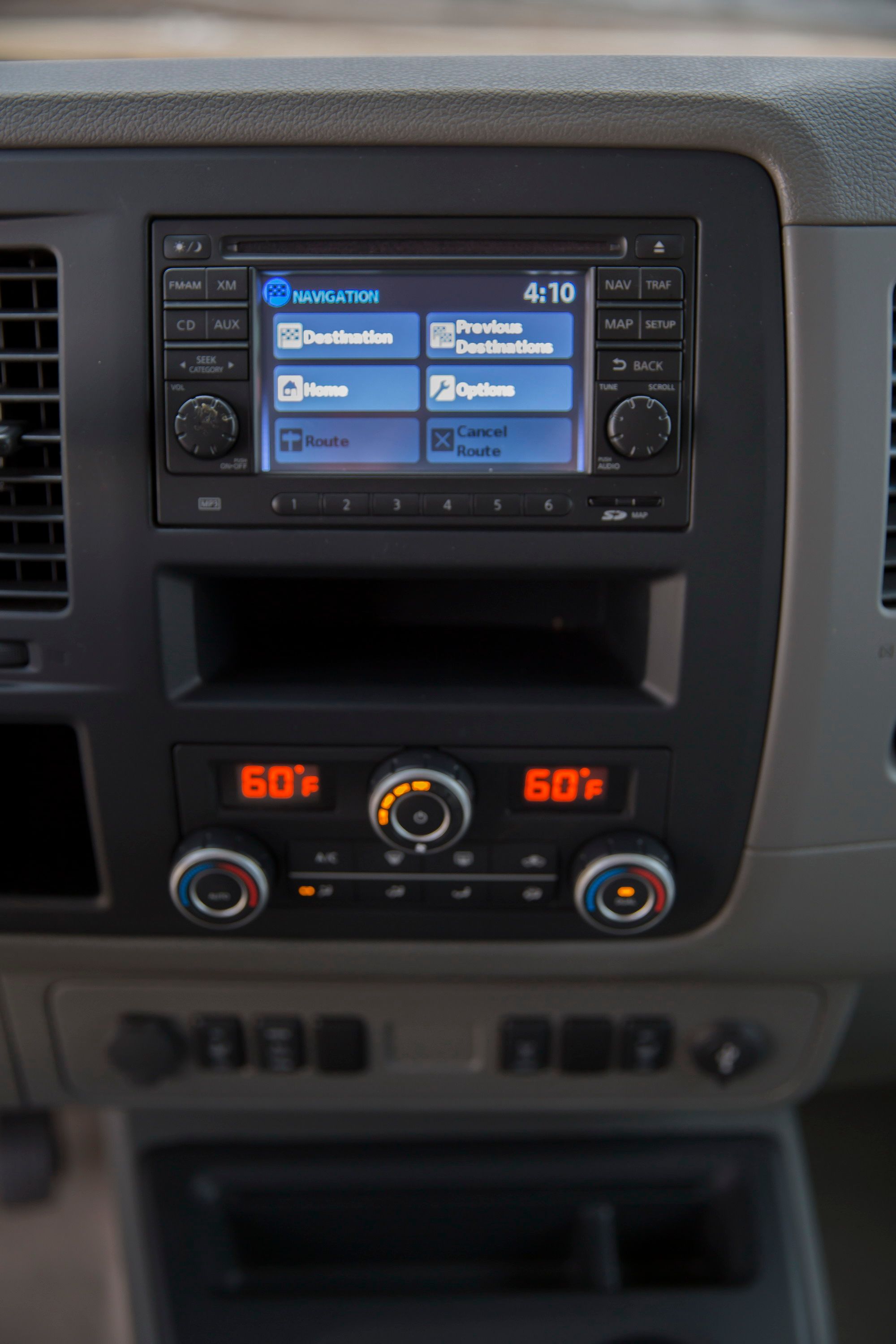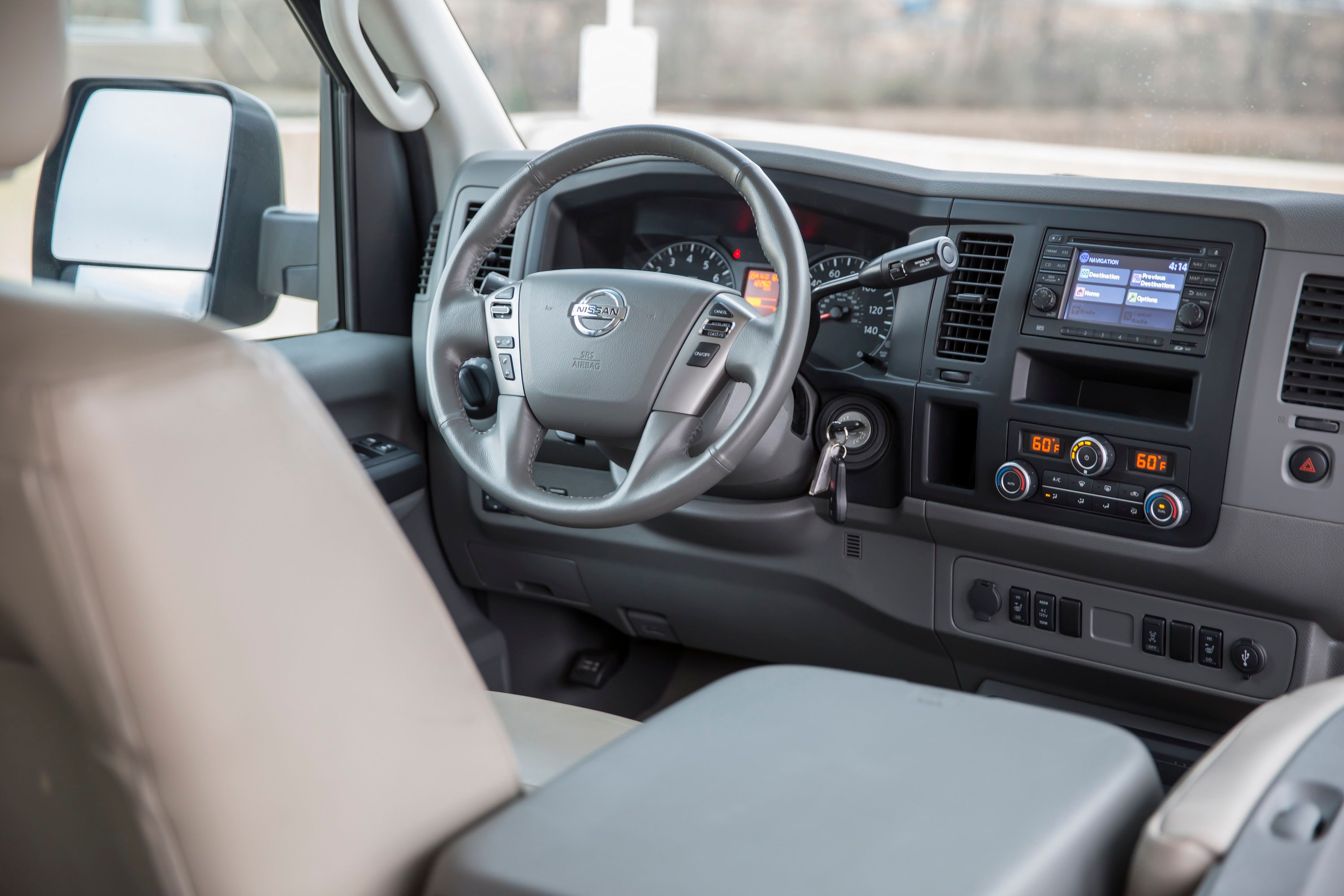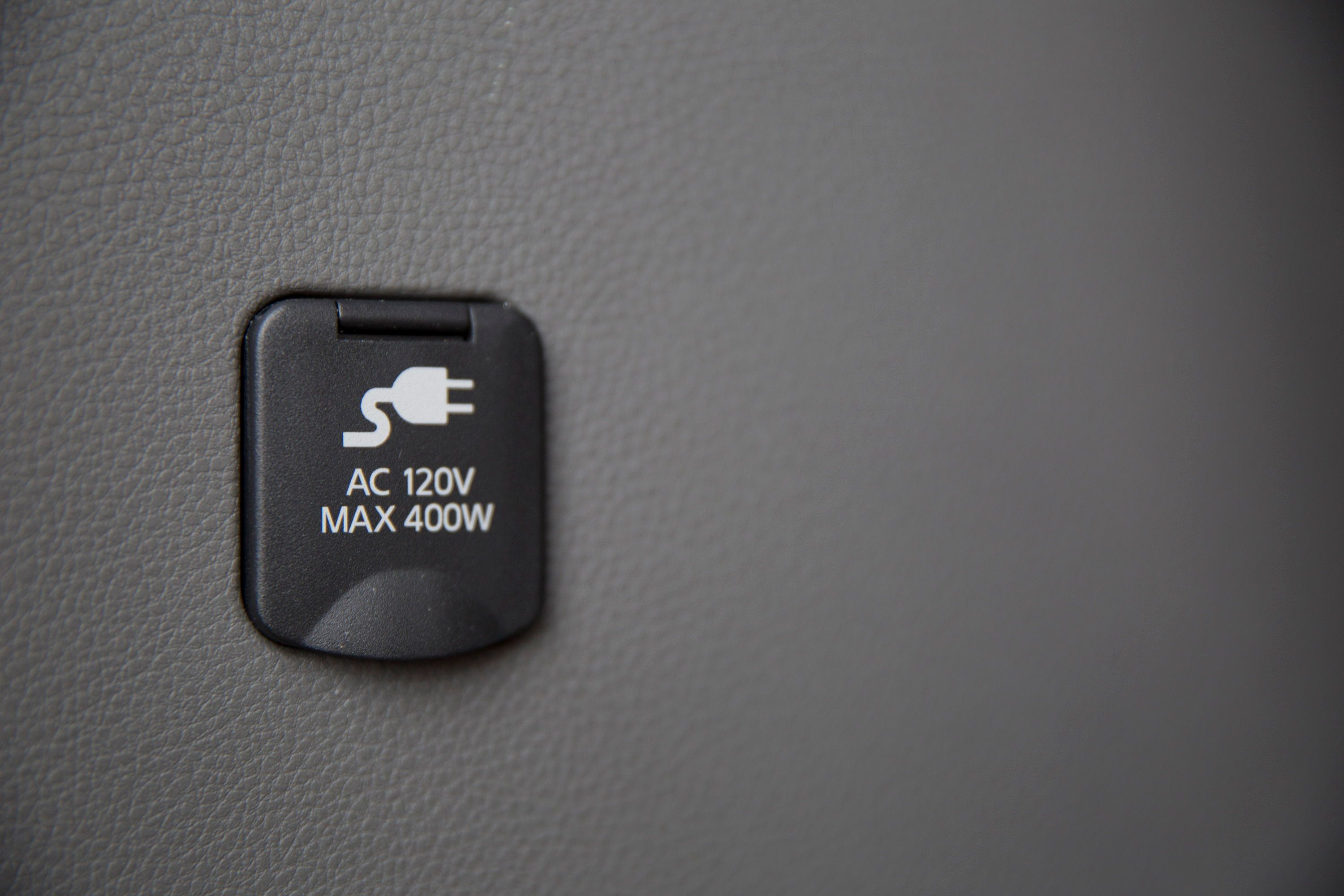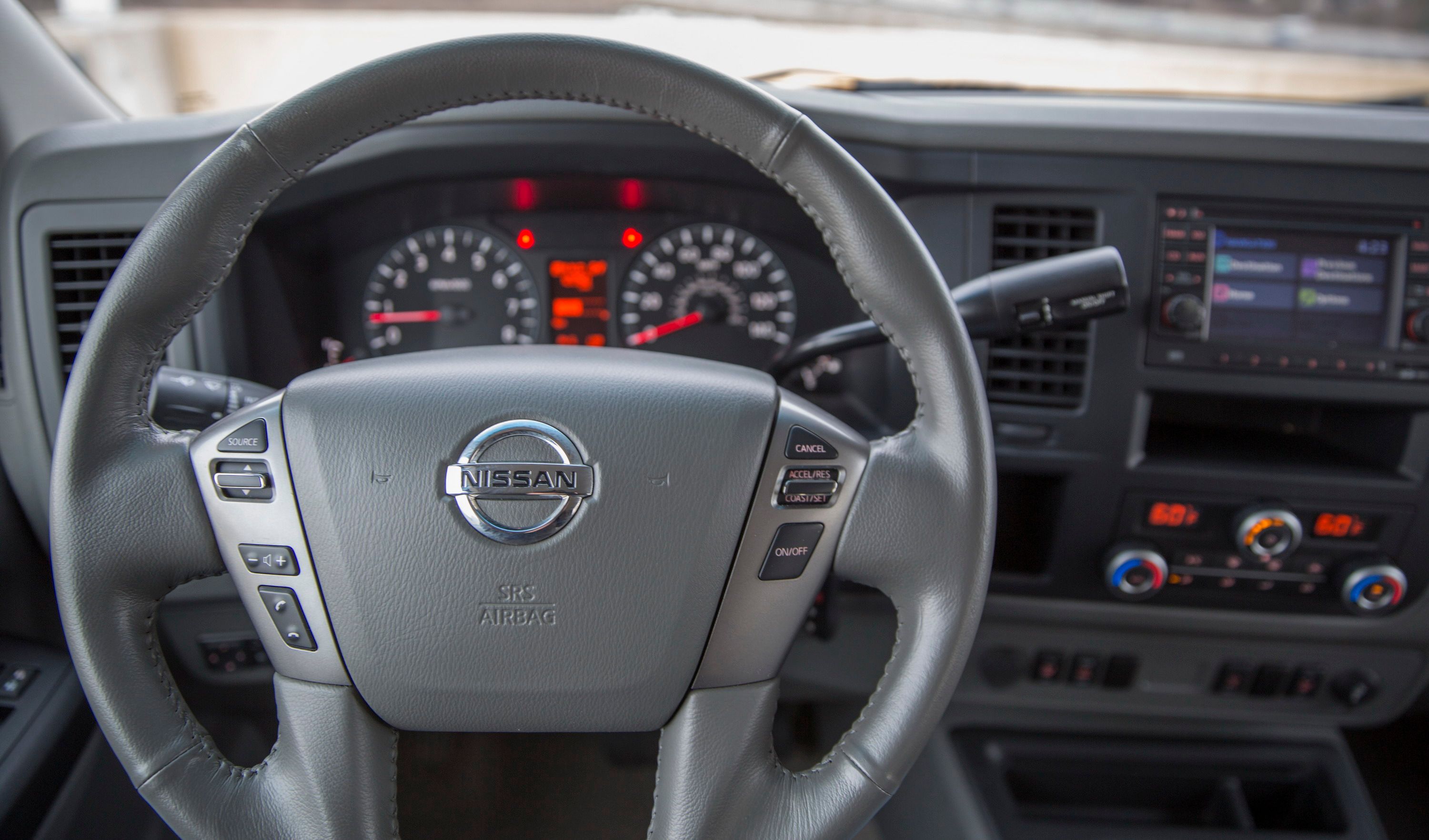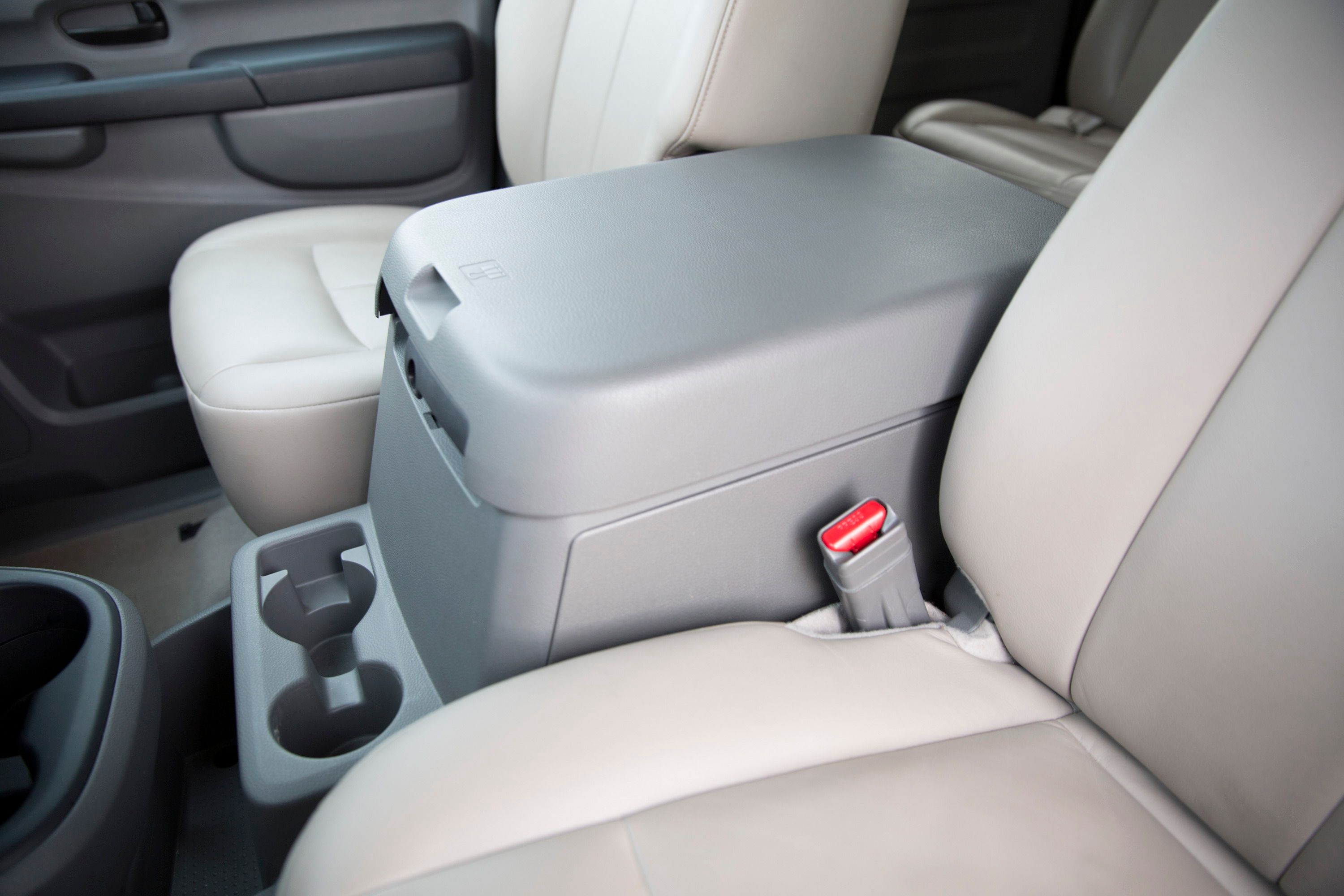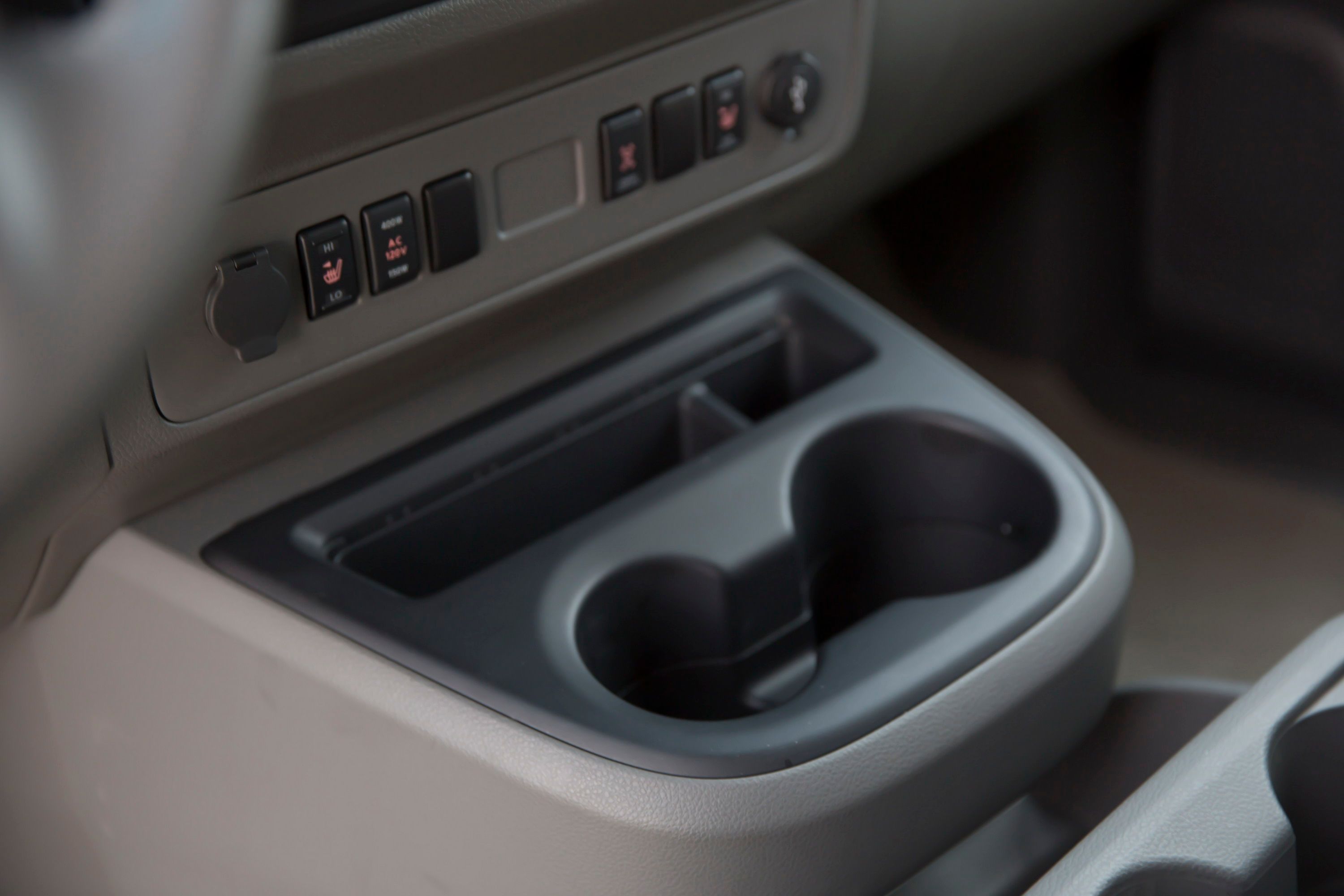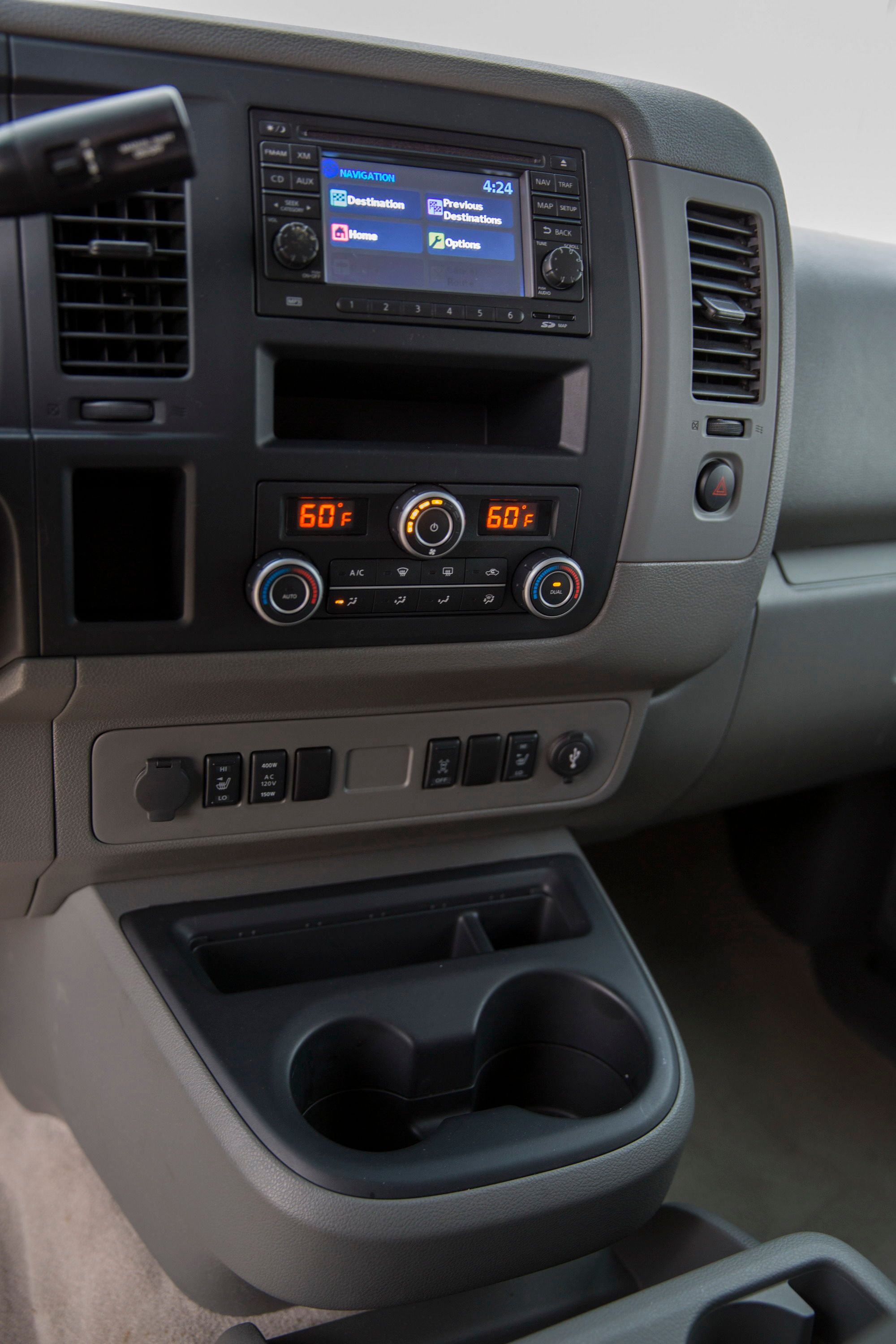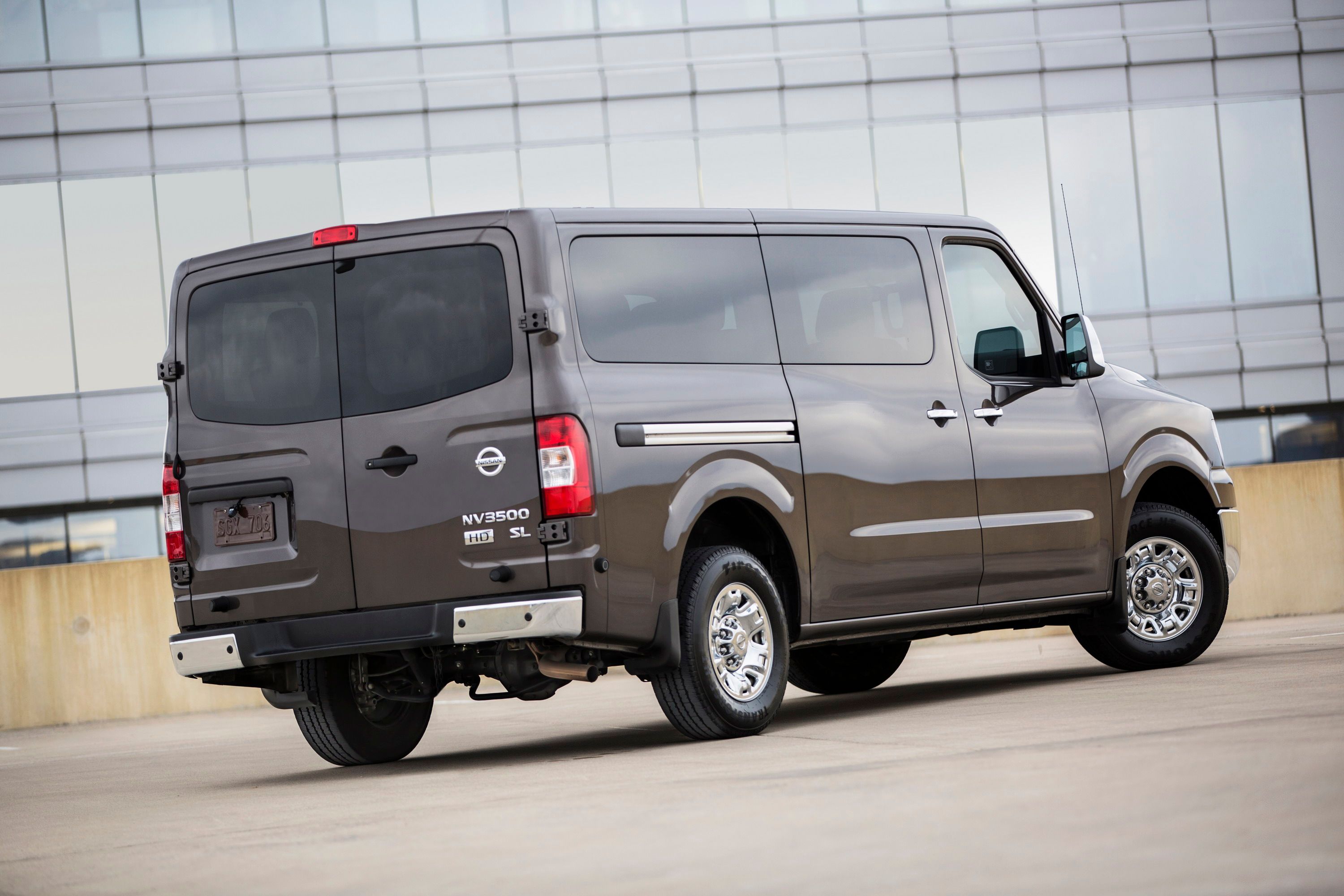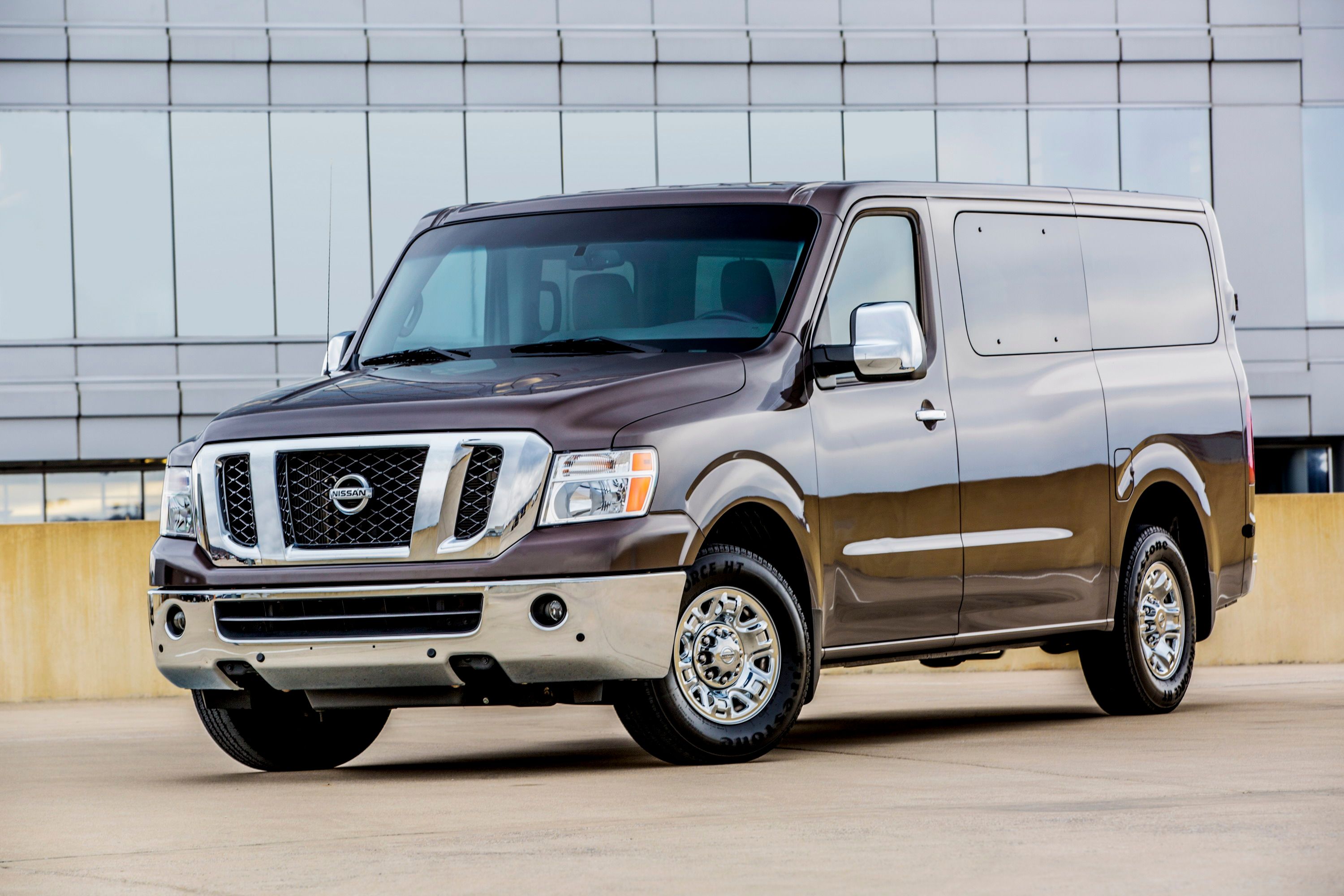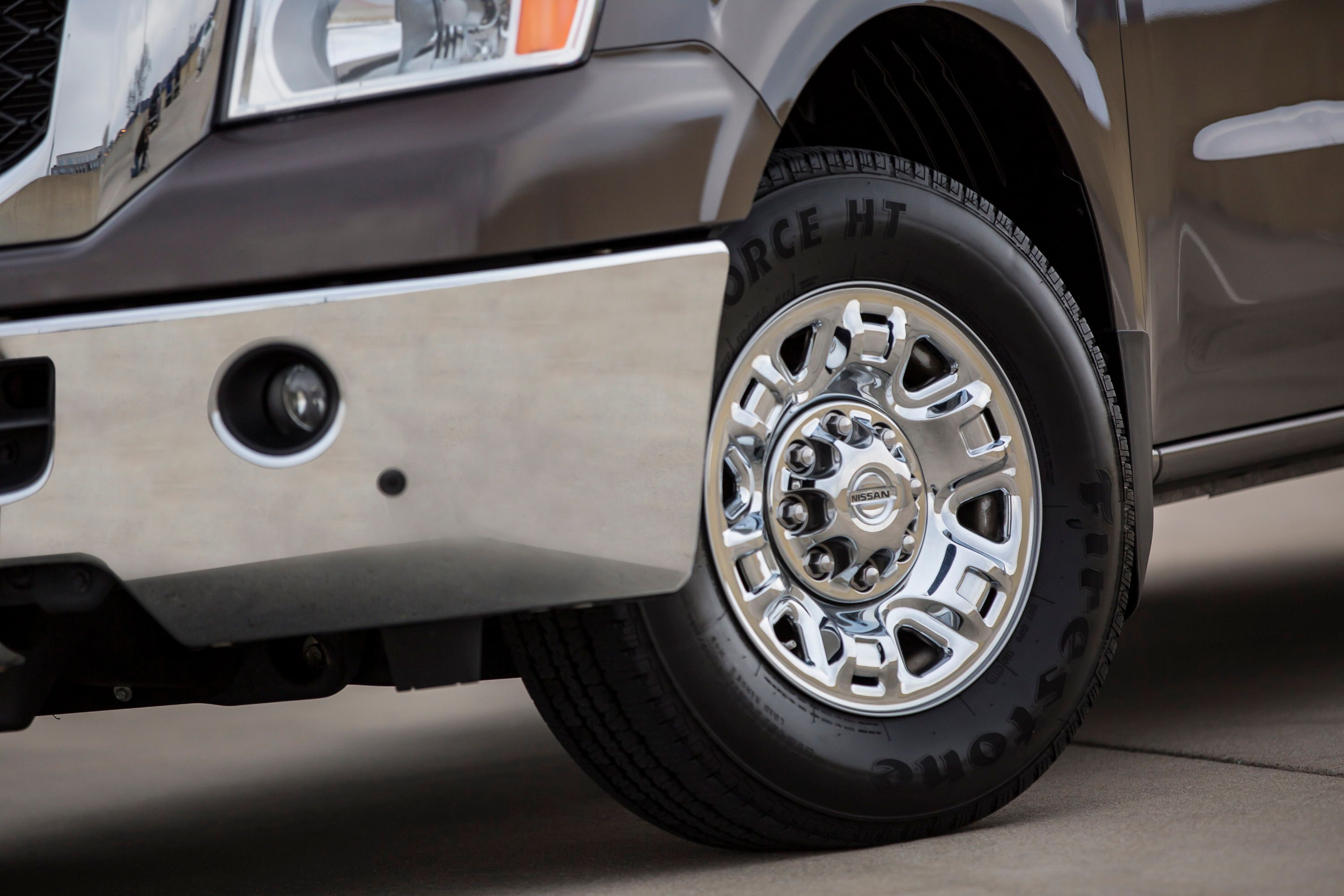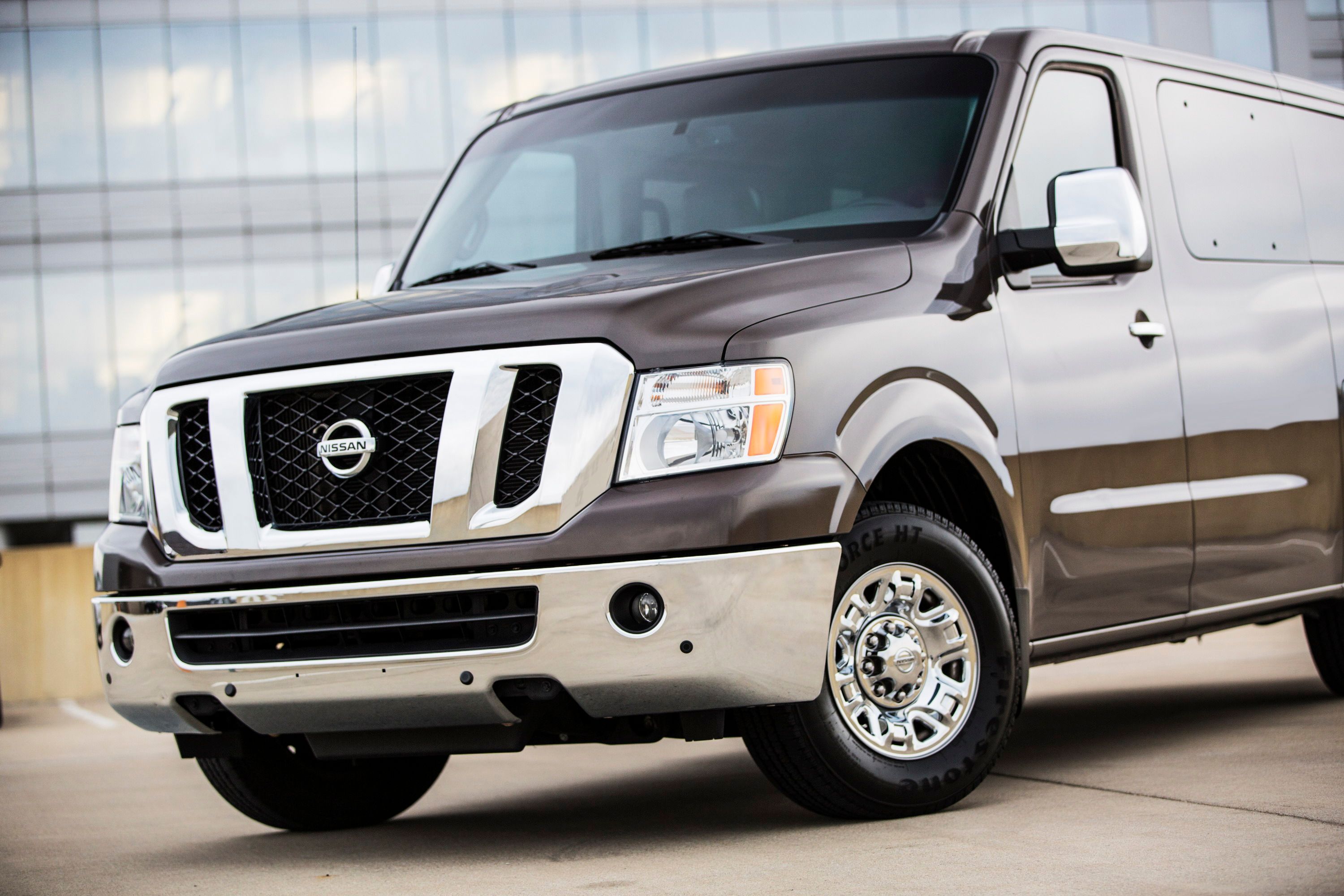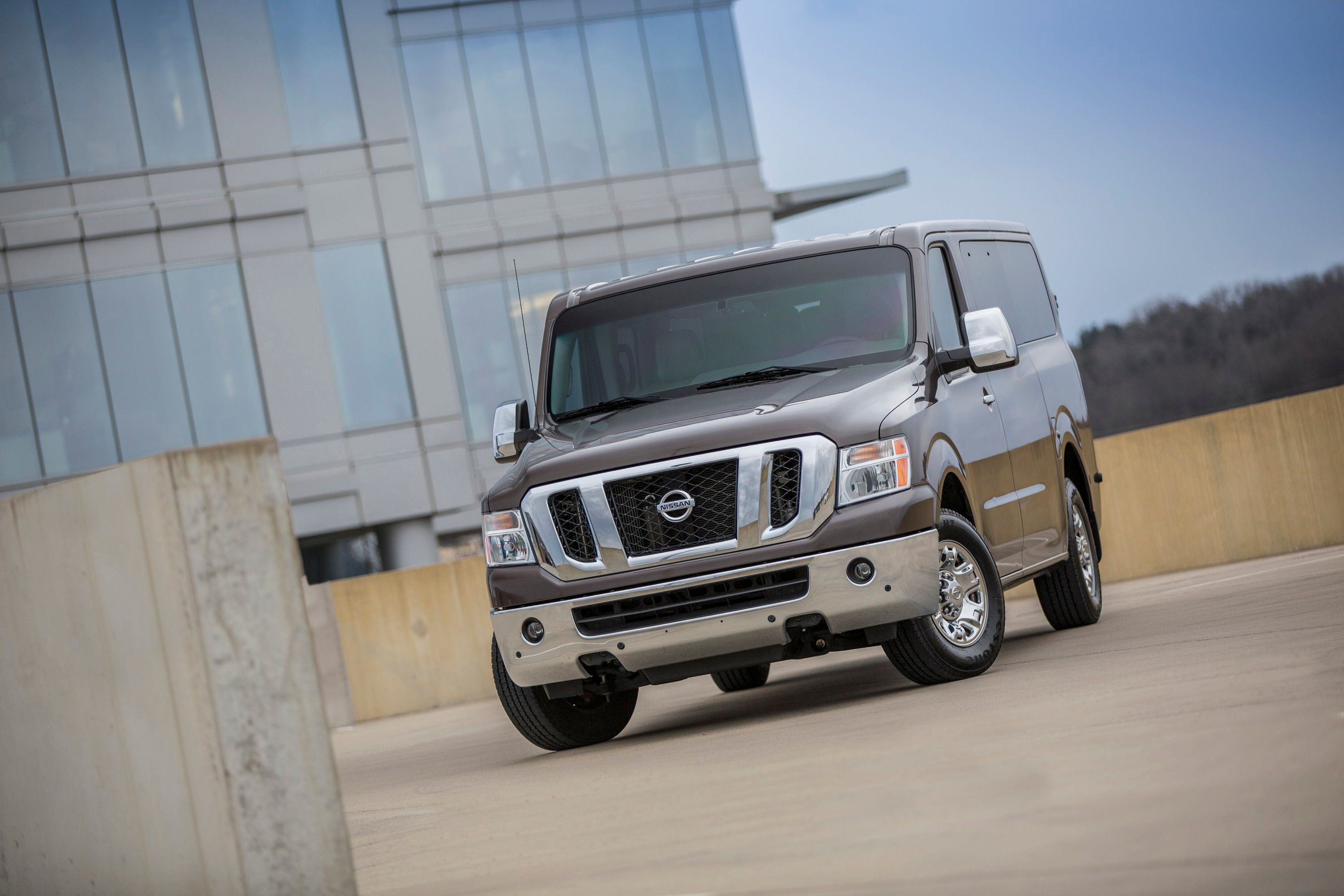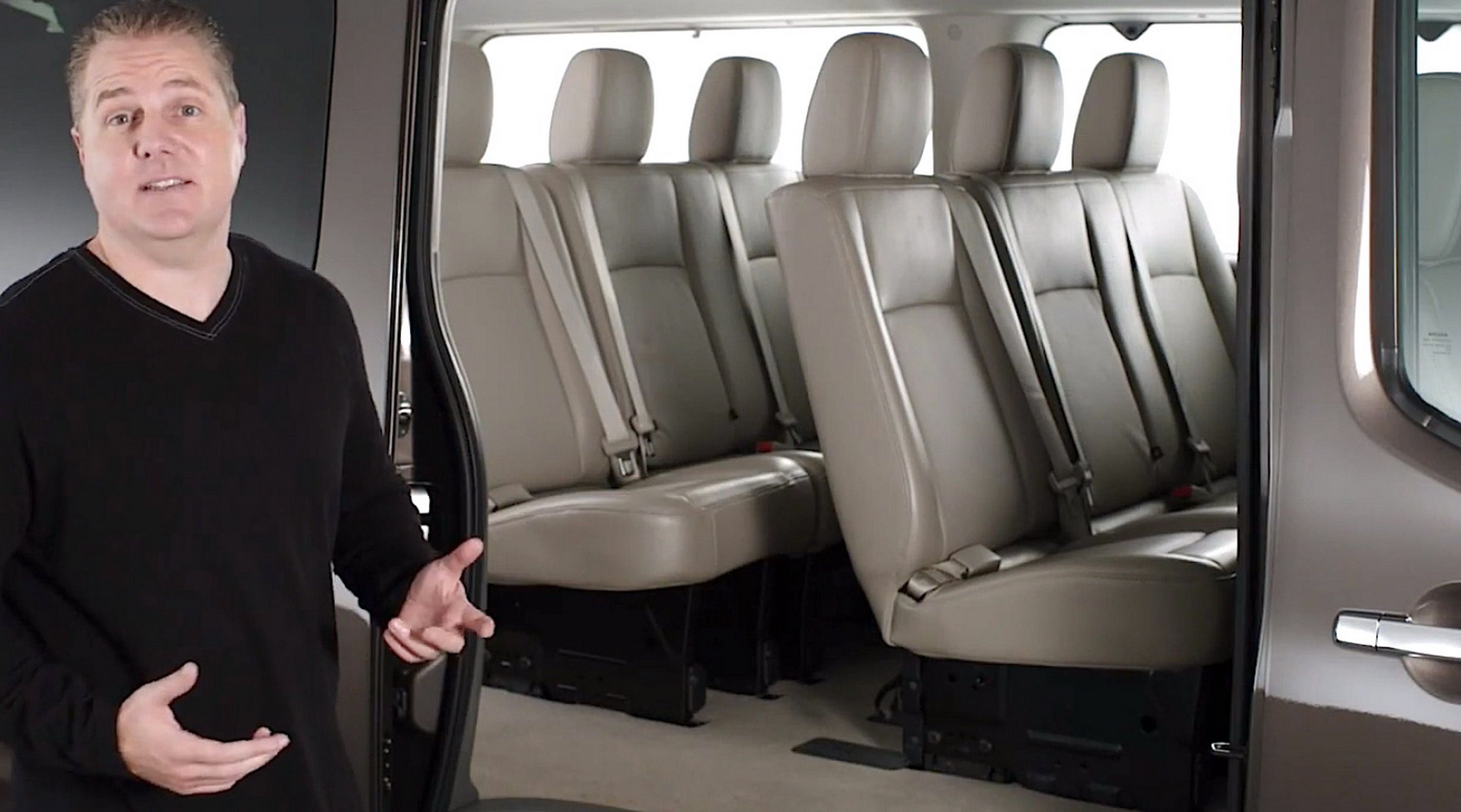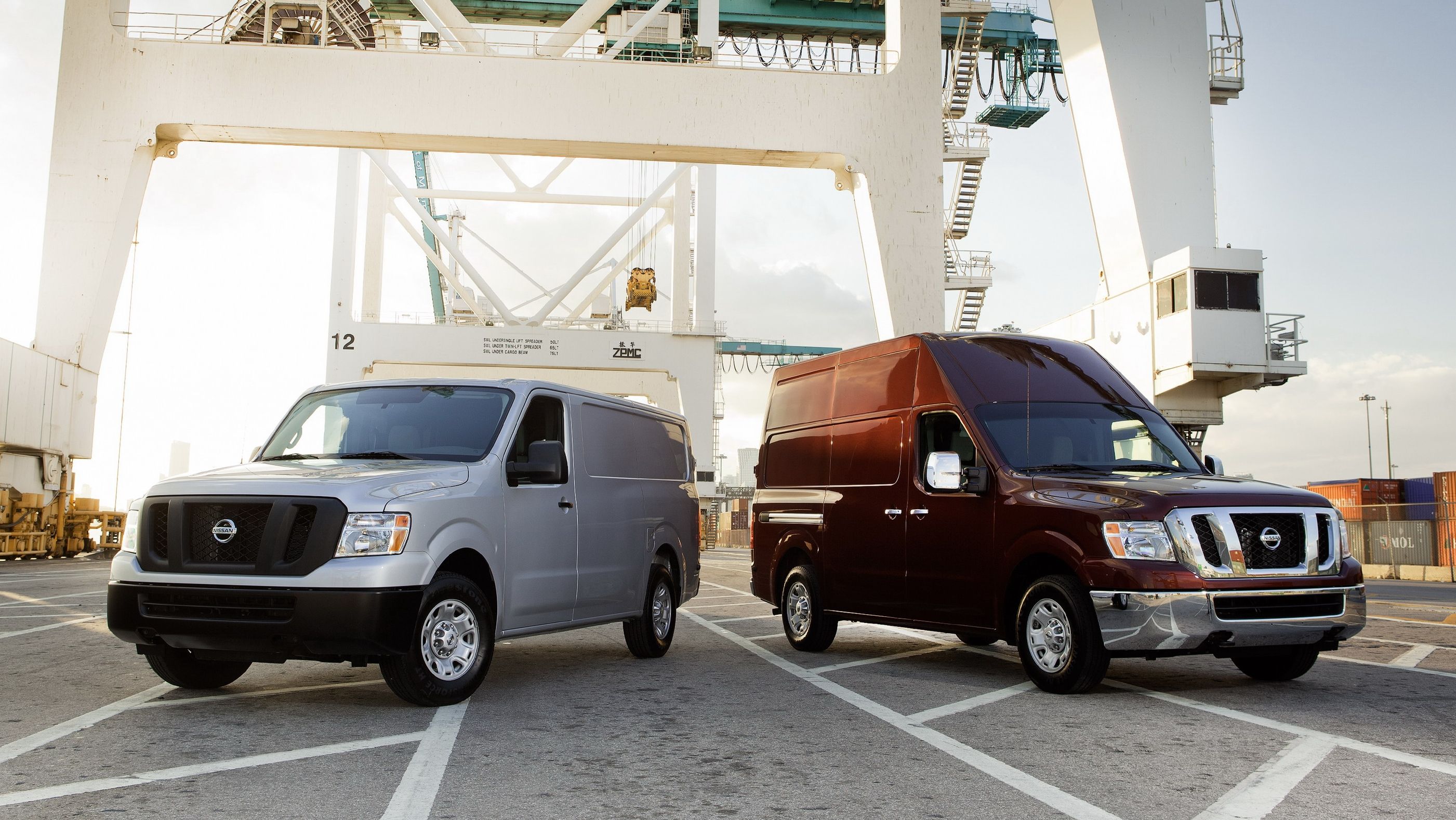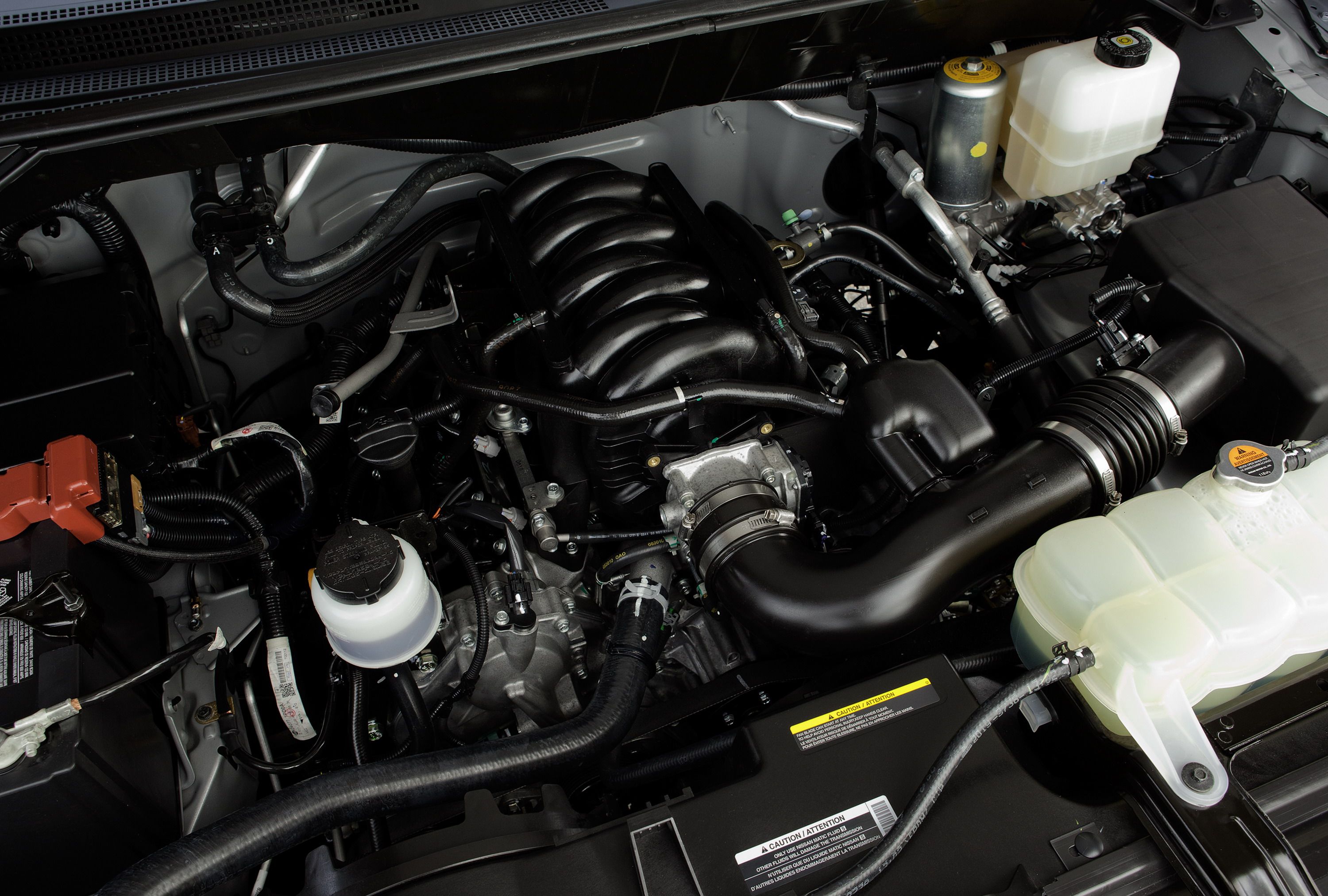Nissan is giving its NV passenger and cargo van a new heart – the all-new 5.6-liter Endurance V-8 and heavy-duty seven-speed automatic transmission found in the new Titan pickup and Armada SUV. This makes the Nissan NV vans the most modern body-on-frame vans in the industry, although its competition is becoming slim, with the Chevrolet Express and its corporate twin, the GMC Savana being the last holdouts in the segment.
For those who might not remember, the NV debuted for the 2012 model year and is based on the first-generation Nissan Titan. In fact, the NV shares the Titan’s front frame section, suspension parts, and steering gear. The NV also shares much of its front-end styling with the original Titan.
The original Titan is no longer, thanks to the introduction of the 2016 Titan XD and 2017 Titan pickup. That means Nissan had the perfect chance to update the NV with new components. Sadly, only the V-8 powertrain is changing, despite the opportunity of grafting the second-generation Titan’s face onto the chassis. Perhaps customers looking at full-size commercial vans aren’t too worried about aesthetics.
Nevertheless, the 2017 Nissan NV is getting the Titan’s new powerplant. That means horsepower jumps by 58 and torque improves by two pound-feet. The Titan’s seven-speed automatic transmission replaces the NV’s old five-speed automatic. The more powerful yet efficient V-8, paired with the new transmission, should help the NV vans achieve better fuel efficiency while delivering a better driving experience. The EPA doesn’t rate heavy-duty vehicles, so there is no official data to list.
So, let’s take a deep look at the 2017 Nissan NV van and its closest competitor.
Continue reading for more information.
2017 Nissan NV
- Make: Array
- Model: 2017 Nissan NV
- Engine/Motor: V8
- Horsepower: 375
- Torque: 387
- Transmission: Seven-speed automatic
- [do not use] Vehicle Model: Array
Exterior
Looking for something new and exciting? Skip down to the Drivetrain section. Sadly, nothing has changed on the outside. It’s hard to fault Nissan though. The NV isn’t competing for affectionate glances, but rather business and fleet customers attracted to its cavernous interior able to swallow 12 passengers or two full-size pallets.
Still, the 2017 NV van has plenty to talk about. The van is offered in three chassis configurations: 1500, 2500, and 3500. All three share the same basic look, but get different underpinnings that accompany increasingly large payload and towing capacities. The NV’s biggest differenticator is its optional high-profile roof. Unlike the Chevrolet Express, the NV is the only body-on-frame van available in the U.S. with a high roof. Of course, Ford offers the Transit, Mercedes-Benz has the Sprinter, and Ram has the ProMaster, but those are based on unibody platforms. We’ll cover the differences further down.
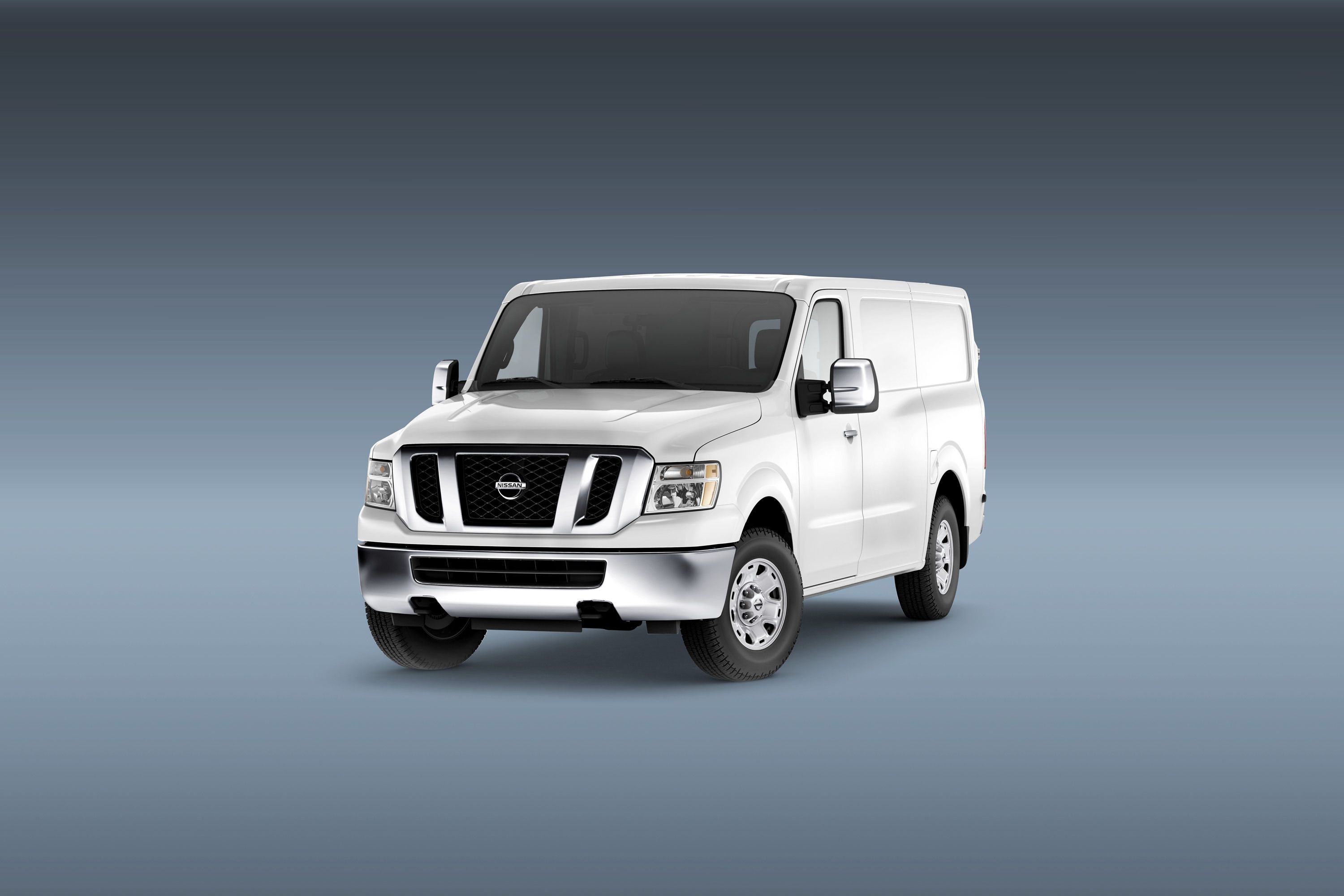
|
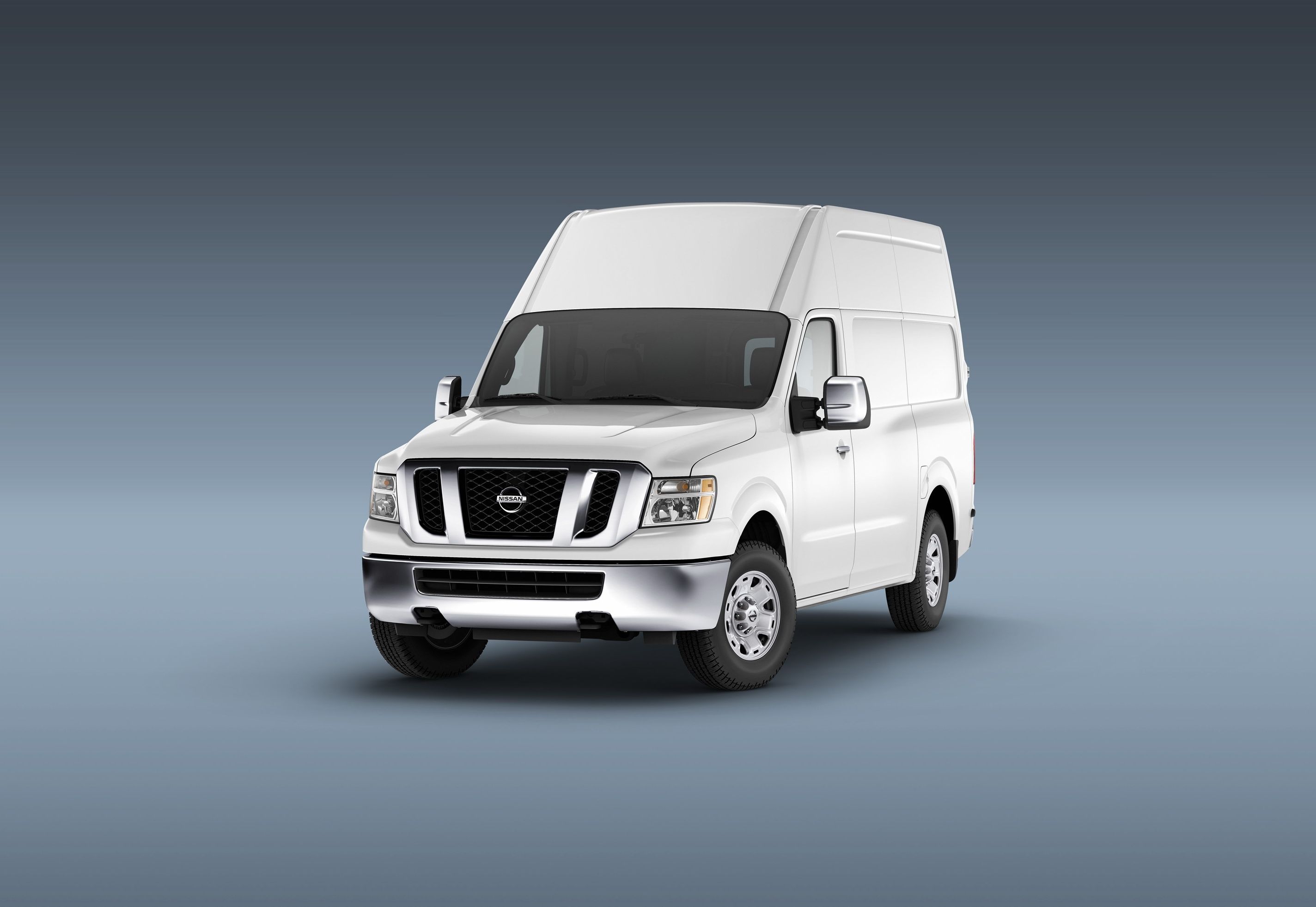
|
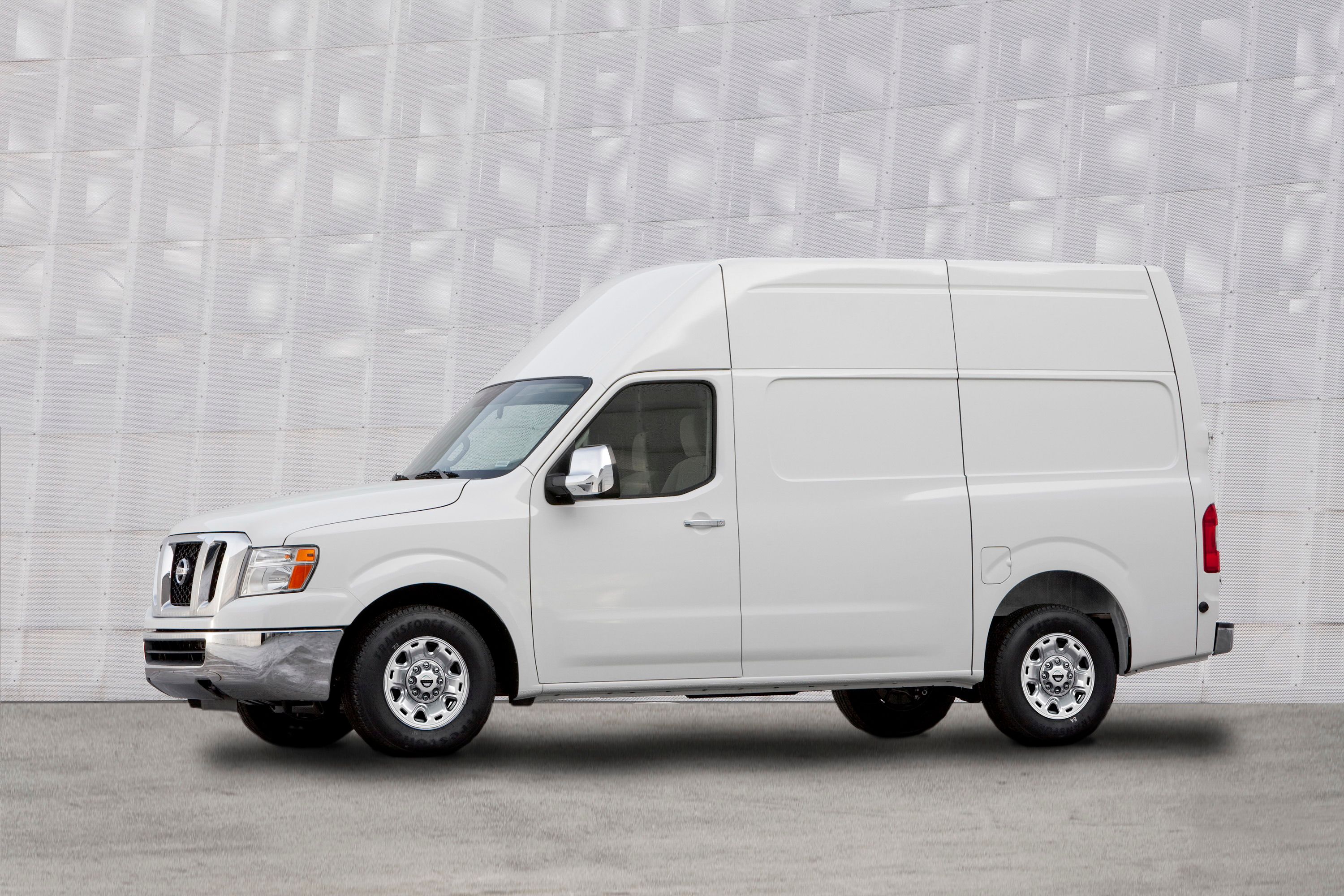
|
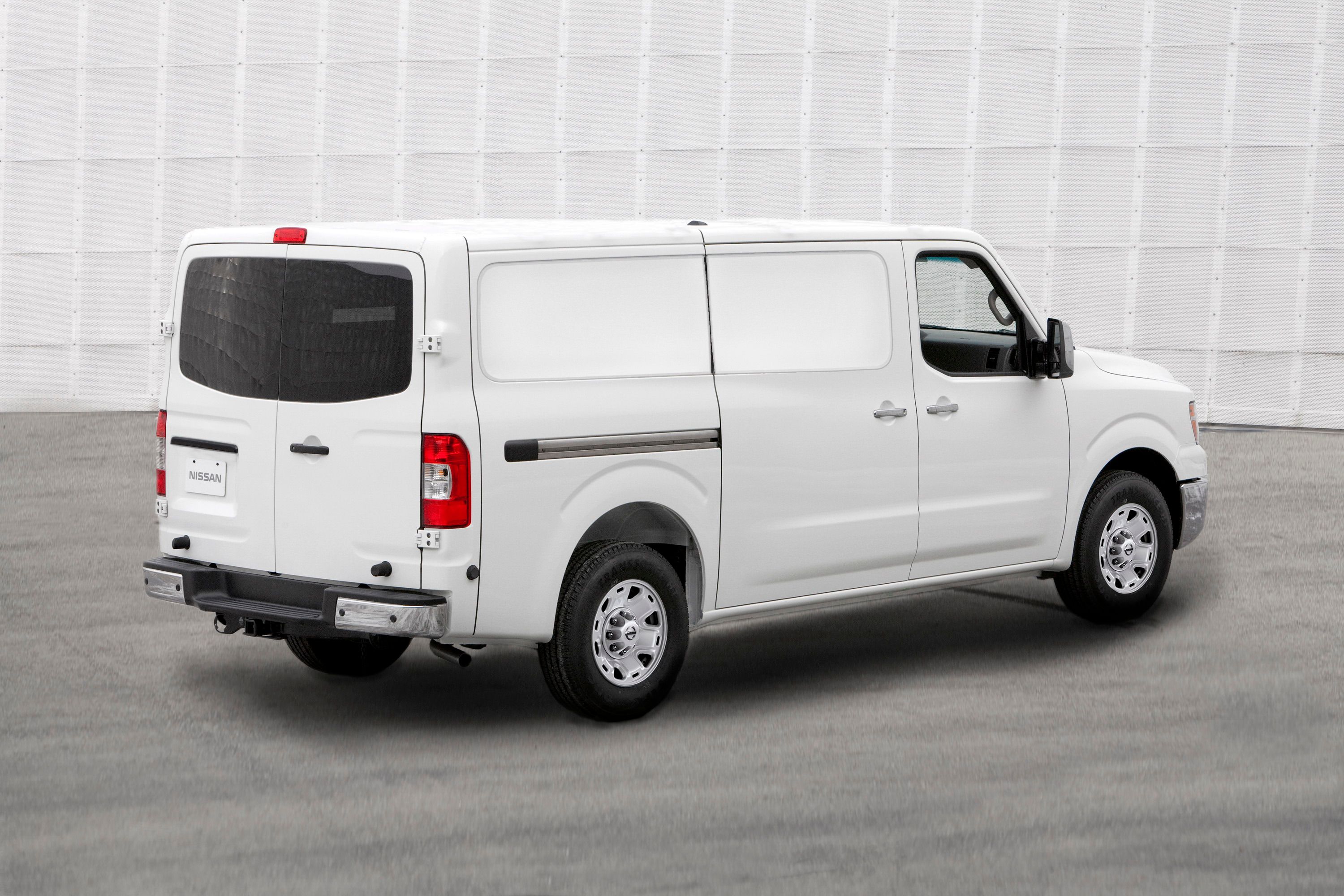
|
The Nissan also offers some innovative features not found elsewhere in the industry. The roof of the NV Cargo has built-in mounting points for cargo racks or other specialized equipment. This saves businesses or aftermarket upfitters from having to drill into the roof, creating potential leak points or a corrosion hazard. The NV also has frame-mounted tow hooks at the front bumper. No other van has this.
As for the doors, the NV has two conventional doors for the first row. A sliding passenger side door gives access to the front of the passenger or cargo compartment. The out back, barn door-style doors swing wide, resting against magnetic bump stops on the rear quarter panels. Several detents allow for users to position the door in various places along its travel. A step bumper helps aid entry into the rear, while the side door gets a similar step cut into the floor area.
As far as looks go, the Nissan NV continues to share aesthetics with the first-generation Nissan Titan pickup. In fact, everything ahead of the A-pillars is strikingly similar to the 2004 through 2015 Titan. The NV does have a more upright grille with different headlights, but the same theme is evidently used.
Every NV van comes with 17-inch wheels. The wheels’ appearance changes with the three available trim grades, with the base S getting steel wheels and the mid-grade SV trim and rage-topping SL trim getting chrome-clad wheels. The SV also gets standard equipment that includes a Class IV trailer hitch receiver, a seven-pin trailer wiring harness, and power heated chrome extendable towing mirrors. Opt for the SL trim, and the NV comes with fog lights, a front sonar system, and a rear-view camera. Moving from the S to SV trim also brings a chrome grille and chrome bumpers.
The Competition
The Chevrolet Express is the only body-on-frame van left in the segment these days. The Ford Econoline van is no longer available, though it technically lives on as a chassis cab option. Dodge/Ram hasn’t offered a body-on-frame van since it killed the B-Series van in 2003.
The Express has been around since the 1996 model year, but received a refresh for 2003. The van still wears the same face, making it more than 13 years old. Still, the van offers a clean, somehow not dated looking design. Trim levels determine the front grille and headlight design. Cargo models get a black treatment with old-school sealed beam headlights. Passenger models get a chrome strip across the front, with more modern headlights and chrome bumpers.
The Express comes in two wheelbase lengths. For passenger models, the regular wheelbase offers room for 12 passengers, while the extended wheelbase has a 15-passenger option. Both 2500 and 3500 models are offered in both passenger and cargo trims. Chevy dropped the 1500 model in June of 2014 due to poor sales.
|
Chevrolet Express Psgr Van |
Chevrolet Express Cargo Van |
Nissan NV Passenger Van |
Nissan NV Cargo |
|
|
Wheelbase (inches) |
135.0 |
135.0 |
146.1 |
146.1 |
|
Overall length (inches) |
224.0 |
224.0 |
240.6 |
240.6 |
|
Overall width (inches) |
79.2 |
79.2 |
79.9 |
79.9 |
|
Overall height (inches) |
84.6 |
84.6 |
84.0 |
83.9 |
Interior
Regular folks don’t really think that much about the interior of work vans or the airport shuttle, but Nissan has put quite an effort into making the NV a livable and workable mobile office. Up front, the dash uses a simple design that’s easy to learn. The gauge cluster is borrowed form the first-generation Titan, as is the steering wheel and HVAC controls. The radio also has a similar appearance, with the available NissanConnectSM and its 5.8-inch touchscreen. The system includes voice recognition, USB connection, AUX input, Bluetooth, SiriusXM, Travel Link, and a rearview camera.
Between the front seats is a versatile center console. It features two cup holders, a spot for a cell phone, a hard surface up top for easy writing, and space enough inside for hanging file folders. Detail wise, the top can slide forward, making it even easier to use as a desk and an available storage tray spans the length of the console for odds and ends. Interestingly enough, Nissan was the first automaker to incorporate groves for hanging files inside the center console. Mounted to the dash is a spot for cell phones or loose items and two additional cup holders.
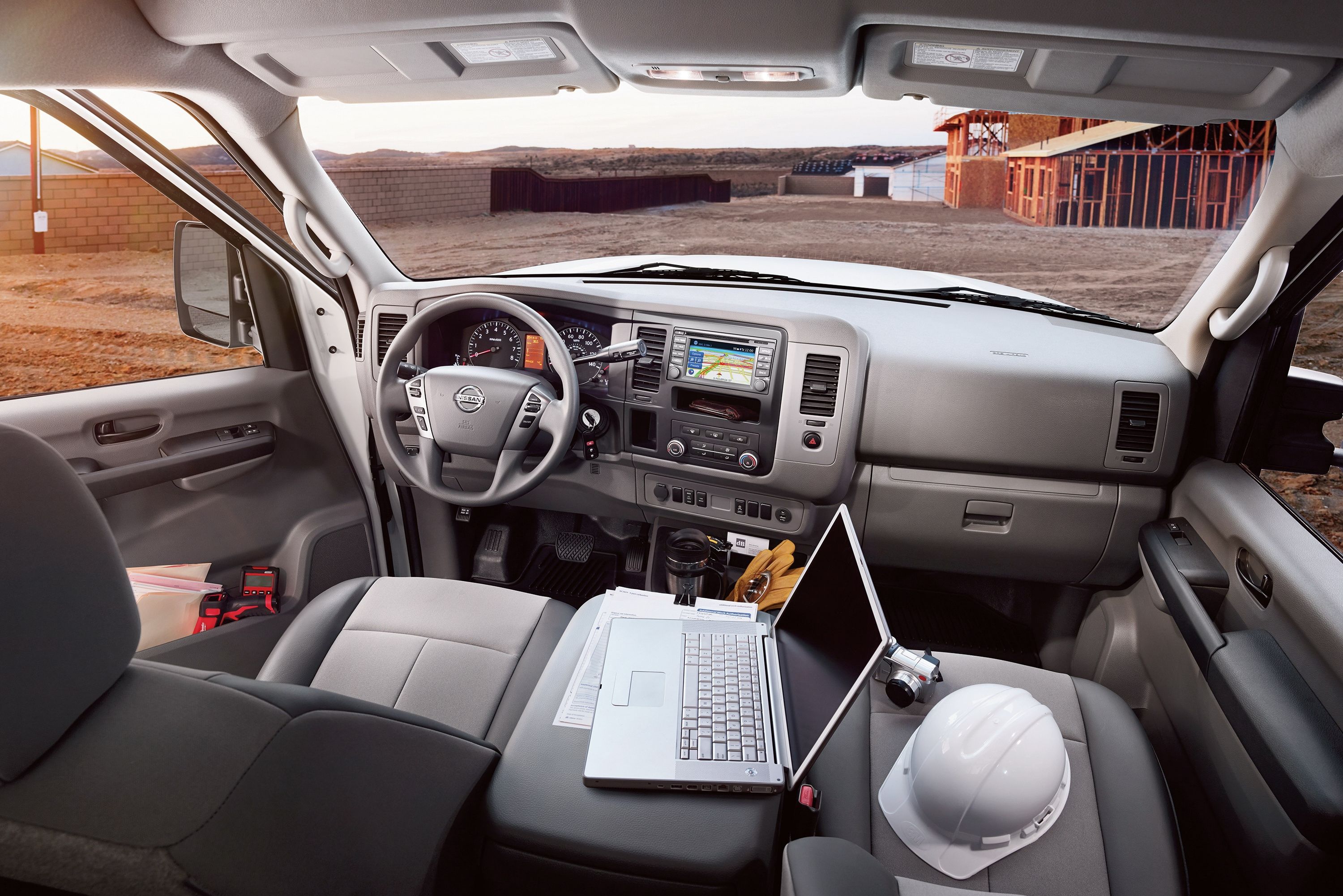
|
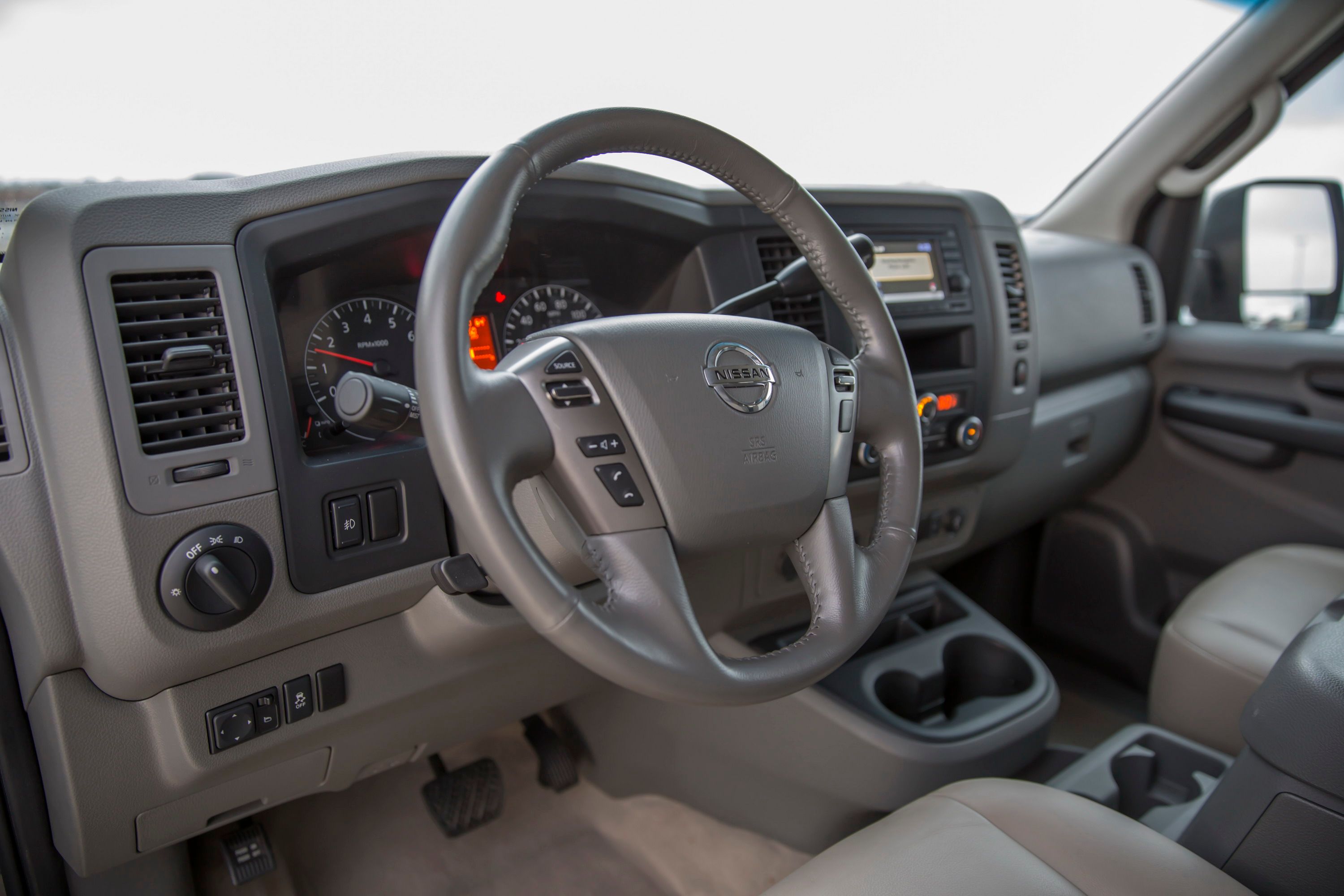
|
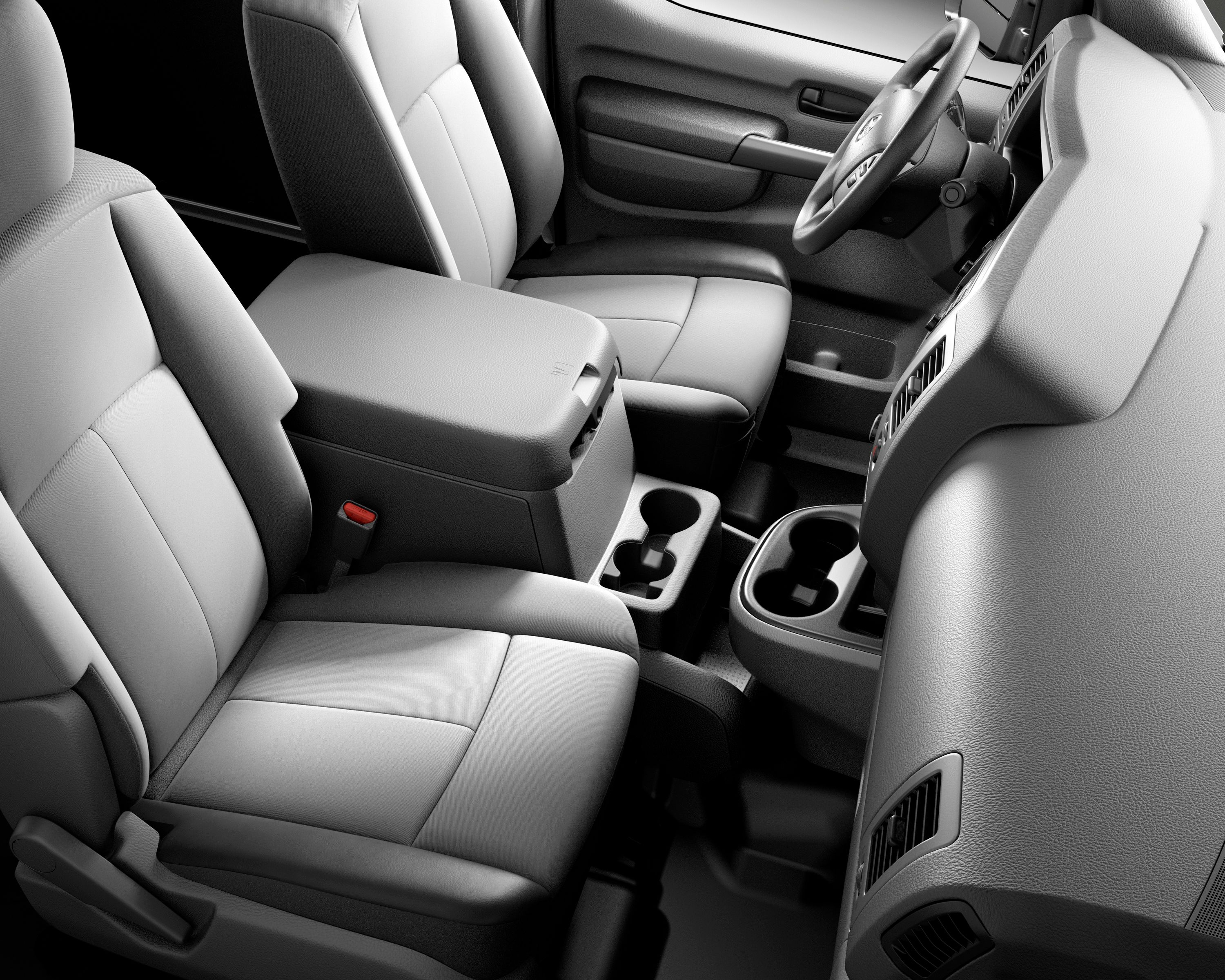
|
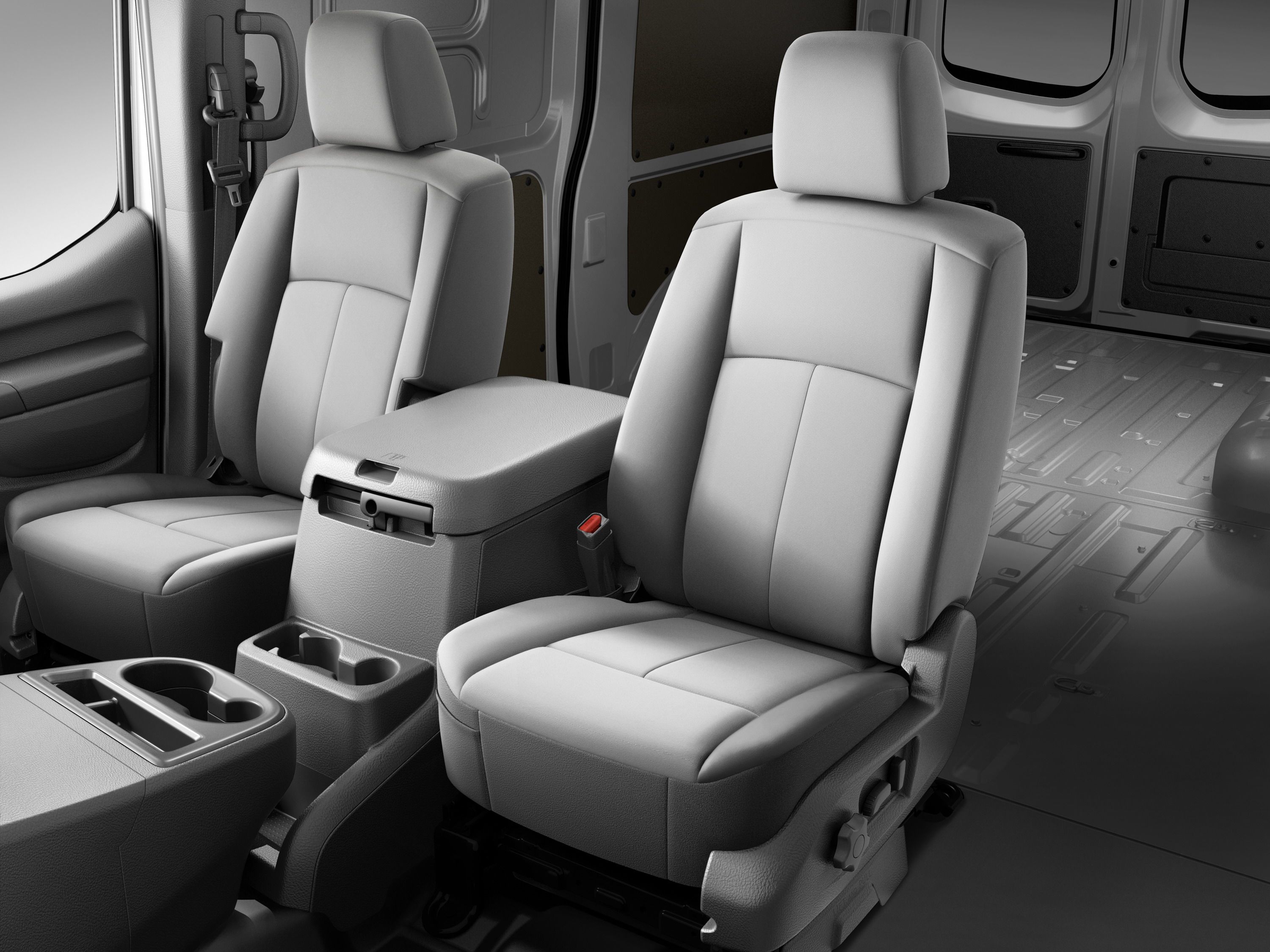
|
Passenger versions of the NV van get three rows of rear seating. The first two rows offer room for three across, with the rear row allowing four across. Each passenger has their own three-point seatbelt, which is attached to the bench itself – not the roof like some vans had in the past. The seats are removable and configurable, allowing for a slew of possibilities. In fact, Nissan says the NV passenger has 324 seat configurations.
Much of that can be contributed to the 50/50-split fourth-row seat. It can be partially or completely removed depending on the need. Optional equipment includes an eight-way power seat for the driver, a leather-wrapped steering wheel, and heated front seats. The NV also gives rear passengers their own HVAC vents and rear controls. There is also available map lights for each row, a 12-volt outlet on the third row, and a 120-volt, three-prong household outlet near the rear door.
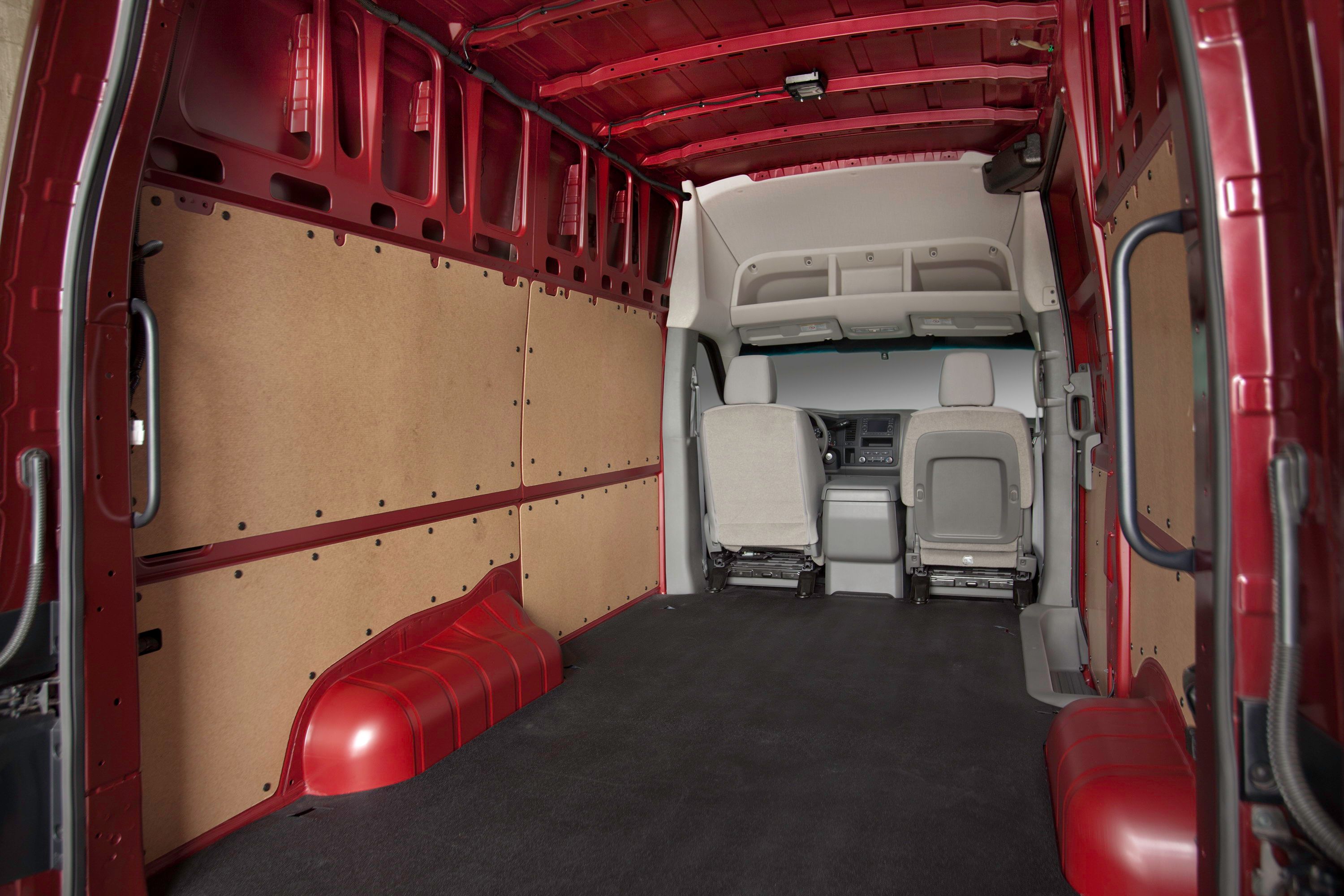
|
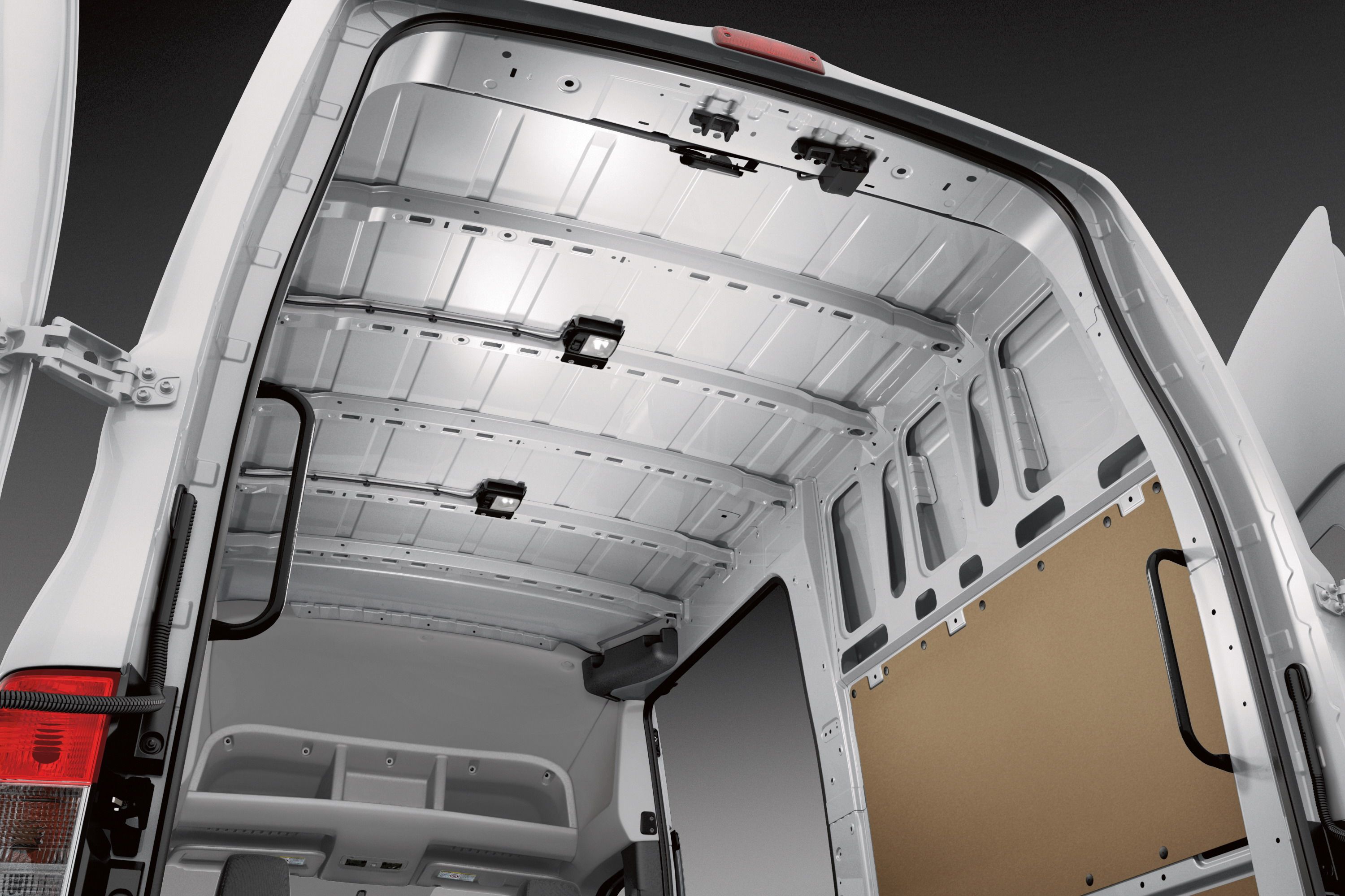
|
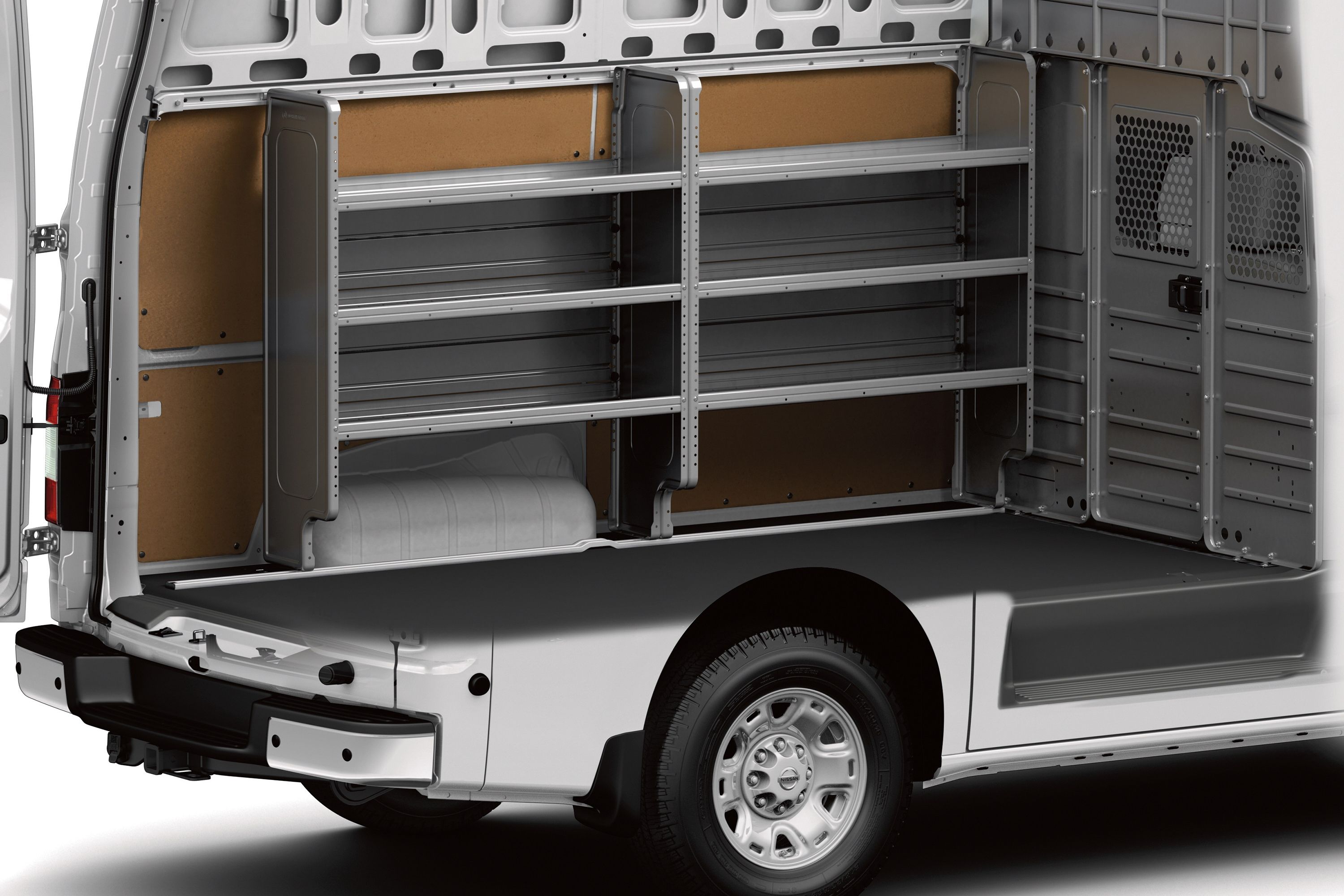
|
Cargo models come with only two seats – the rest is left wide open for, well… cargo. The NV is large enough to hold two full-size shipping pallets. One pallet can be loaded through the side door with a forklift and the second can be loaded, again with a forklift, through the rear doors. The side walls are also nearly vertical, making it easy to attach items like aftermarket storage shelves. The wheel wells are also squared off at the top, which increases interior volume and ease of use. And since a pallet will fit between the wheel wells, a 4x8 sheet of plywood or drywall will also fit. For those wanting more headroom, Nissan offers the high-roof version of the NV. It can be had with either the NV2500HD or NV3500HD cargo vans.
The cargo area boasts a length of 120 inches, a maximum width of 70.2 inches, and 55.8 inches of height in the standard-roof van. High-roof models had a maximum of 76.9 inches, or 6.4 feet. That’s more than tall enough to accommodate the average size human.
Cargo Area Dimensions
|
Length |
120 Inches |
|
Width |
70.2 Inches |
|
Height standard roof |
55.8 Inches |
|
Height high-roof |
76.9 Inches |
The Competition
The Chevrolet Express comes in both passenger and cargo versions as well. Regardless of configuration, the front two seats and dashboard remain unchanged. Trim level and color choice does shake things up a bit, but otherwise, the Express isn’t very… expressive… when it comes to interior choices.
The Chevy comes in two wheelbase lengths. The standard wheelbase can be had in both passenger and cargo form. In passenger guise, it can haul a maximum of 12 occupants. Opt for the extended wheelbase version, and the Express can hold 15 occupants, provided you pay for the extra row of seats. Otherwise, the van will come with extra storage space behind the last row, which is positioned over the rear axle. Regardless of length, the last row seats four, while the middle rows seat three across.
For the cargo version, regular wheelbase models have 124.6 inches of floor length behind the first row, while the extended wheelbase models have 146.2 inches of length. The Express only comes in one roof height, which measures 53.4 inches tall. Width wise, the Express is 52.7 inches from side to side inside the cargo area. Overall, the standard wheelbase Express can haul 239.7 cubic feet of cargo, while the extended wheelbase van can carry 284.4 cubic feet of cargo.
Up front, the Express has a large black dashboard with a center console mounted to its “dog house,” or the cover that resides over the engine. Remember, since the Express has a traditional van architecture, its engine sits over the front axle, which is directly under the A-pillar. An analog gauge cluster provides information on speed and engine parameters. The standard radio is about as basic as it gets these days, but an optional touchscreen infotainment system is optional. Unfortunately, it’s programmed with the last-generation MyLink software.
|
Chevrolet Express Psgr Van |
Chevrolet Express Cargo Van |
Nissan NV Passenger Van |
Nissan NV Cargo |
|
|
Headroom (inches) Front seats/2nd row/3rd row/4th row |
39.8/38.4/38.5/37.6 |
39.8 |
42.8/39.6/39.8/39.6 |
42.8 |
|
Legroom (inches) Front seats/2nd row/3rd row/4th row |
41.3/36.3/36.6/36.6 |
41.3 |
42.0/33.9/38.5/37.4 |
42.0 |
|
Shoulder room (inches) Front seats/2nd row/3rd row/4th row |
68.8/68.6/65.8/69.1 |
68.8 |
65.7/69.2/66.6/68.1 |
65.7 |
|
Hip room (inches) Front seats/2nd row/3rd row/4th row |
65.5/65.6/63.3/65.7 |
65.5 |
60.6/70.4/67.2/68.6 |
60.6 |
|
Cargo volume (cu ft) |
216.2 |
239.7 |
267.0 |
234.1 |
Drivetrain
Now to the new stuff. For 2017, Nissan has given the NV van the all-new 5.6-liter Endurance V-8. Don’t let the name or the familiar displacement fool you – this engine is basically new from the ground up. Nissan says it only shares the bore and stroke of the outgoing engine. This is the same V-8 that’s now found in the Titan, Titan XD, Armada, and Infiniti QX80, although it doesn’t share the same power output as these engines.
The naturally aspirated engine uses direct fuel injection, or what Nissan calls its Direct Injection Gas system, or DIG for short. The engine also boasts Nissan’s variable Valve Event & Lift system, otherwise known as VVEL, on its dual overhead cams that operate four valves per cylinder. It combines hydraulically controlled variable valve timing with electronically controlled variable valve lift on both the intake and exhaust sides. The result is a more powerful yet efficient engine. Nissan says the engine should deliver an estimated eight percent improvement in fuel economy over the outgoing engine.
The NV’s 5.6-liter makes 375 horsepower and 387 pound-feet of torque. That’s down a tad from the Titan and Armada’s output of 390 horsepower and 394 pound-feet of torque. Nevertheless, it’s a big improvement over the last-generation 5.6-liter Endurance’s 317 horsepower. Torque remains similar, only gaining two pound-feet over the last-generation’s 385 pound-feet of torque. These power figures also make the NV class leading in both horsepower and torque.
Backing the new V-8 is Nissan’s seven-speed automatic transmission. Assuming Nissan keeps the transmission unchanged from the Titan and Armada, it should features Adaptive Shift Control and Downshift Rev Matching. Widely spaced gears and a fluid warmer help with efficiency. That warmer is said to get the fluid up to operating temperature more quickly, making the gearbox work more smoothly and therefore cutting friction. The seven-speed replaces the five-speed gearbox shared by the NV and the first-generation Titan.
Four those not needing the extra power, the NV continues to come standard with the 4.0-liter V-6 and five-speed automatic transmission. The V-6 offers 261 horsepower and 281 pound-feet of torque. Port fuel injection and variable valve timing are utilized in this application.
Braking equipment continues unchanged, but remains class leading. Four-corner disc brakes with ABS bring the van to a stop. Front rotors measure 14.1 inches in diameter, while the rear rotors measure 14.3 inches. A good, old-fashioned hydraulic recirculating ball steering system controls the front wheels. Suspension wise, the front features an independent setup with MacPherson struts and a stabilizer bar. Out back is a solid axle held in place with leaf springs.
|
Engine |
V-6 |
V-8 |
|
Displacement (liters) |
4.0 |
5.6 |
|
Horsepower |
261 HP @ 5,600 RPM |
375 HP @ 5,800 RPM |
|
Torque |
281 LB-FT @ 4,000 RPM |
387 LB-FT @ 4,000 RPM |
|
Transmission type |
5-speed AT |
7-speed AT |
The Competition
Under the Chevy’s hood lies two engine options. The standard engine is GM’s 4.8-liter V-8. This third generation LS-based engine uses an iron block with aluminum cylinder heads with two valves per cylinder. Port fuel injection and variable valve timing control firing operations. The under-tuned engine is built for durability, only making 285 horsepower and 295 pound-feet of torque.
For those needing extra grunt, the Express’ optional engine is a 6.0-liter L96 V-8. This is the same engine that’s found in the Silverado HD pickups. Like the 4.8-liter, the 6.0-liter is a member of GM’s third generation LS family. Likewise, the L96 uses an iron block with aluminum heads with two valves per cylinder. Port fuel injection and variable valve timing contribute to performance and efficiency. In the Express, the V-8 is rated at 342 horsepower and 373 pound-feet of torque. Both engines use GM’s six-speed automatic transmission to send power to the rear wheels.
The Express rides on a ladder-type frame with an independent front suspension that uses MacPherson struts. A solid rear axle and leaf springs does duty out back, and an available Eaton G80 automatic locking differential helps with traction on loose surfaces.
|
Chevrolet Express 4.8L V-8 (L20) |
Chevrolet Express 6.0L V-8 (L96 / LC8) |
Chevrolet Express Duramax 6.6L V-8 turbo-diesel (LGH) |
Nissan NV V-6 |
Nissan NV V-8 |
|
|
Engine |
4.8-liter V-8 |
6.0-liter V-8 |
6.6-liter V-8 |
4.0-liter V-6 |
5.6-liter V-8 |
|
Horsepower |
285 HP @ 5,400 RPM |
329 @ 5,400 RPM |
260 HP @ 2,800 RPM |
261 HP @ 5,600 RPM |
375 HP @ 5,800 RPM |
|
Torque |
295 LB-FT @ 4,600 RPM |
373 LB-FT @ 4,400 RPM |
525 LB-FT @ 1,600 RPM |
281 LB-FT @ 4,000 RPM |
387 LB-FT @ 4,000 RPM |
|
Engine |
six-speed heavy-duty electronic automatic |
six-speed heavy-duty electronic automatic |
six-speed heavy-duty electronic automatic |
5-speed AT |
7-speed AT |
|
Horsepower |
6,096 Lbs |
6,117 Lbs |
6,436 Lbs |
6,695 Lbs |
6,864 Lbs |
|
Torque |
2,482 Lbs |
3,461 Lbs |
3,142 Lbs |
2,820 Lbs |
2,630 Lbs |
|
Transmission |
9,800 Lbs |
9,700 Lbs |
9,300 Lbs |
6,200 Lbs |
8,690 Lbs |
Prices
The 2017 Nissan NV carries a base price of $27,730. For that, you get the 1500-series model with the standard roof and 4.0-liter V-6. Surprisingly, this is the lowest-priced van in the full-size segment. The NV Passenger carries a base price of $33,800 and can be had only in the 3500-series, but comes with your choice of engine. A top-line NV 3500 passenger with the SL trim package and 5.6-liter V-8 has a starting price of $41,200. A $1,195 destination fee will be added at the time of purchase.
Nissan continues to back the NV with its five-year/100,000-mile bumper-to-bumper warranty. The 2017 NV will go on sale in February of 2017 at 440 Nissan Commercial dealerships nationwide.
|
2017 Nissan NV Cargo Standard Roof |
|
|
NV 1500 Standard Roof S V6 |
$27,730 USD |
|
NV 1500 Standard Roof SV V6 |
$28,720 USD |
|
NV 2500 Standard Roof S V6 |
$28,730 USD |
|
NV 2500 Standard Roof SV V6 |
$29,720 USD |
|
NV 2500 Standard Roof SL V6 |
$31,140 USD |
|
NV 2500 Standard Roof S V8 |
$30,330 USD |
|
NV 2500 Standard Roof SV V8 |
$31,320 USD |
|
NV 2500 Standard Roof SL V8 |
$32,700 USD |
|
NV 3500 Standard Roof S V8 |
$32,030 USD |
|
NV 3500 Standard Roof SV V8 |
$33,020 USD |
|
NV 3500 Standard Roof SL V8 |
$34,400 USD |
|
2017 Nissan NV Cargo High Roof |
|
|
NV 2500 High Roof S V6 |
$30,880 USD |
|
NV 2500 High Roof SV V6 |
$31,870 USD |
|
NV 2500 High Roof SL V6 |
$33,290 USD |
|
NV 2500 High Roof S V8 |
$32,480 USD |
|
NV 2500 High Roof SV V8 |
$33,470 USD |
|
NV 2500 High Roof SL V8 |
$34,850 USD |
|
NV 3500 High Roof S V8 |
$34,180 USD |
|
NV 3500 High Roof SV V8 |
$35,170 USD |
|
NV 3500 High Roof SL V8 |
$36,550 USD |
|
2017 Nissan NV Passenger Van |
|
|
NVP 3500 S / 4.0-liter V6 |
$33,800 USD |
|
NVP 3500 SV / 4.0-liter V6 |
$36,000 USD |
|
NVP 3500 S / 5.6-liter V8 |
$35,400 USD |
|
NVP 3500 SV / 5.6-liter V8 |
$37,600 USD |
|
NVP 3500 SL / 5.6-liter V8 |
$41,200 USD |
Competition
Ford Transit
While body-on-frame vans are a dying breed, the van industry is taking off thanks to the U.S.’ proliferation of the “Euro van.” These unibody vans have been popular in Europe and across the world for decades, but have only recently become accepted Stateside. The Ford Transit replaced the venerable Econoline van. It offers more interior room, more versatility thanks to various wheelbase lengths, roof heights, and passenger configurations.
The Transit is offered with three engine options. The standard is a 275-horse 3.7-liter V-6, the midrange option is the 310-horse 3.5-liter EcoBoost V-6, and the range-topping option is Ford’s 3.2-liter inline five-cylinder turbodiesel that makes 185 horsepower and 350 pound-feet of torque. A six-speed automatic is paired with all three engines.
In its base cargo van form, the 2017 Transit carries a base price of $31,610. For those needed more room, an extended wheelbase and high roof version with dual rear wheels is available. Check all the expensive configuration boxes, and it can easily exceed $46,000.
Read our full review on the Ford Transit here.
Mercedes Sprinter
The Sprinter van is what started the Euro van trend in the States back in 2001. The vans showed Americans that choice was a good thing. It won businesses over with its multiple wheelbase lengths, available high-roof design, optional passenger seating, and surprising maneuverability.
Two engine choices are available with the Sprinter. The standard is a 2.1-liter four-cylinder turbodiesel. It makes 161 horsepower and 265 pound-feet of torque. Optionally, a 3.0-liter V-6 turbodiesel is available. It makes 188 horsepower and 325 pound-feet of torque. Both engines are mated to a seven-speed automatic transmission. The Sprinter is also the only van that offers a factory 4WD option.
Prices for the 2016 Sprinter start at $32,495. Countless numbers of wheelbase, roof height, trim level, and drivetrain combinations are available, making the Sprinter – hands down – the most versatile van in the industry. Deck a fully loaded Sprinter with all the bells and whistles, and the price can exceed $60,000.
Read more about the Mercedes Sprinter here.
Ram ProMaster
Ram enters the Euro van segment with its rebranded Fiat Ducato van. This van marches to its own drummer, using a FWD platform to help keep its loading deck extremely low. Like the others, it’s available in a cargo, chassis cab, cutaway, and passenger van versions with various states of trim levels. The ProMaster might not be the prettiest thing on the road, but it works.
Power options include the familiar 3.6-liter Pentastar V-6 with 280 horsepower and 260 pound-feet of torque. Heavy haulers will gravitate to the well-loved 3.0-liter EcoDiesel V-6. In this application, it makes 174 horsepower and 295 pound-feet of torque. Both come mated to a six-speed automatic gearbox.
The Ram ProMaster has a starting price of $27,935. Chassis options include the 1500, 2500, and 3500 classes. It also has multiple wheelbases and roof height options. Opt for the most expensive passenger model with the EcoDiesel, and the price can swell to just over $41,000.
Find out more about the Ram ProMaster here.
Conclusion
Nissan is smart to update the NV van with a new V-8 powertrain and seven-speed transmission, although the automaker didn’t really have a choice. See, the outgoing 5.6-liter is no longer produced – gone with the last generation Titan. The new 5.6-liter is built in its place, in the Decherd, Tennessee engine plant outside Chattanooga. Nevertheless, the update is appreciated. It should help with advertising as well, thanks to its best-in-class horsepower and torque.
Despite the NV’s versatile configurations and body-on-frame construction, its sales remain at the bottom of the class. Nissan sold just 16,958 NV vans in the U.S. in 2015. Compare that to Chevy’s movement of 63,382 Express vans. Add to that the 21,992 GMC Savana vans sold in 2015, and GM has a huge portion of the market share. Still, that pales in comparison to Ford’s sales of the Transit van. In 2015, Ford moved 117,577 Transits off U.S. dealer lots. Sales in 2016 have already exceeded that. Counting November’s sales, Ford has sold a whopping 130,188 Transits so far. Tack on another 10,000 or so that’s expected to sell in December. And despite its role in defining the segment, Mercedes only sold 29,889 Sprinter vans in the U.S. in 2015. Still, that’s far more than Nissan.
So, will the new V-8 and gearbox be enough to boost Nissan NV sales? It’s doubtful, but every little bit helps. Granted, Nissan is playing in dangerously competitive territory where fleet sales and mass ordering are common. Ford has a lock on that market thanks to its pickup trucks, so it’s easy to understand why the Transit does so well. Regardless, Nissan offers a solid van for a great price that now comes with the segment’s most powerful and technologically advanced V-8 engine.

